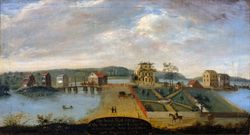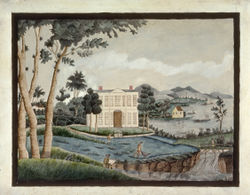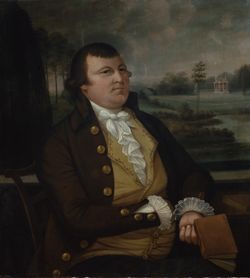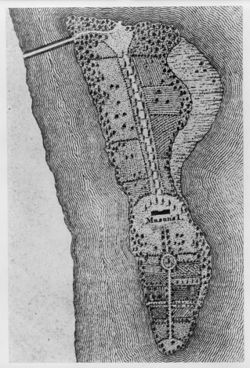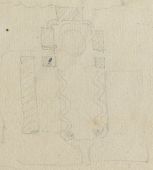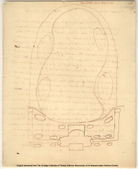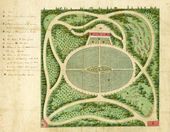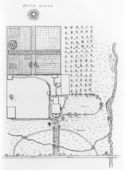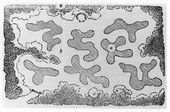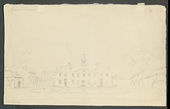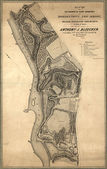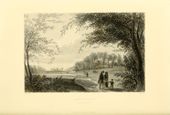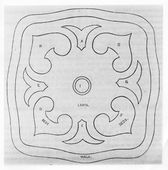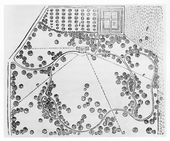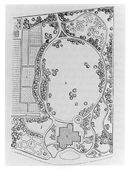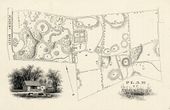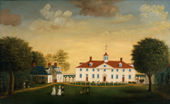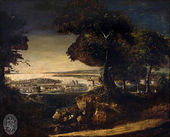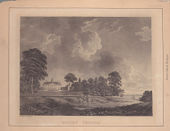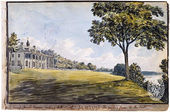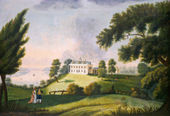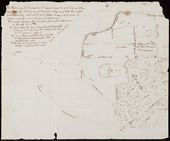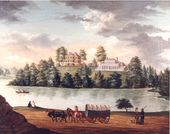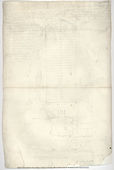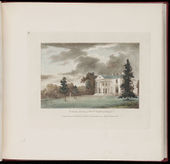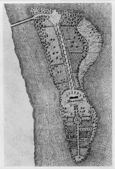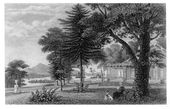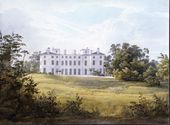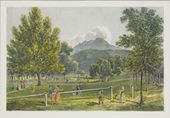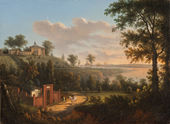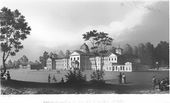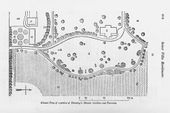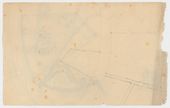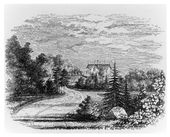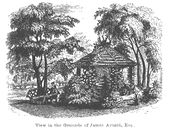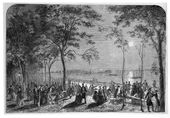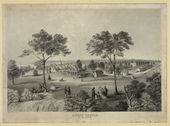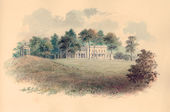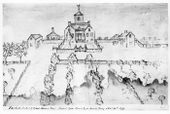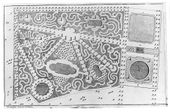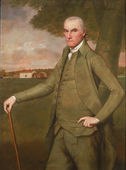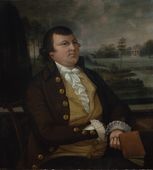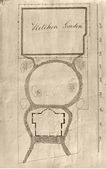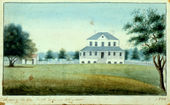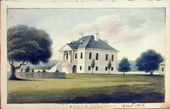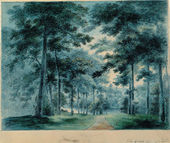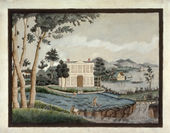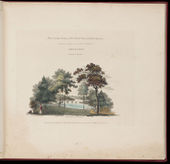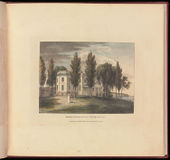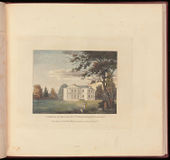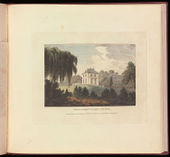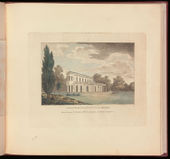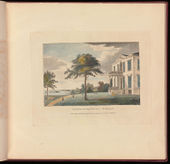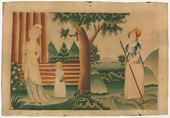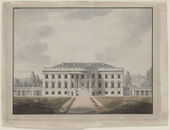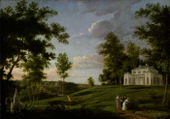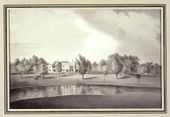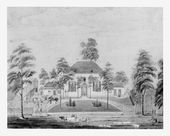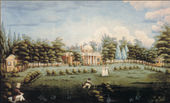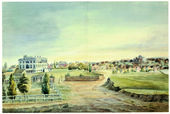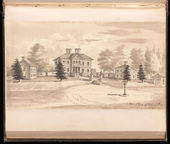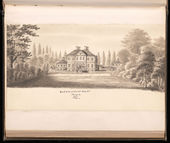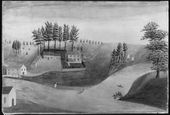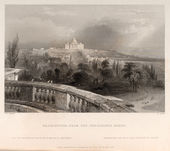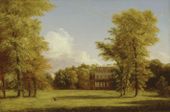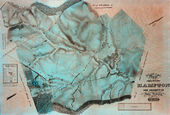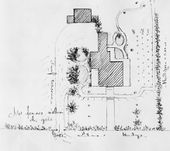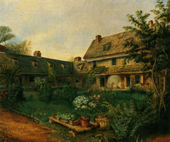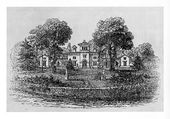Difference between revisions of "Lawn"
V-Federici (talk | contribs) m |
A-whitlock (talk | contribs) |
||
| (86 intermediate revisions by 4 users not shown) | |||
| Line 1: | Line 1: | ||
==History== | ==History== | ||
[[File:0425.jpg|thumb|left|Fig. 1, [[Alexander Jackson Davis]], Design for University of Michigan (elevation and plan of building and grounds), c. 1838.]] | [[File:0425.jpg|thumb|left|Fig. 1, [[Alexander Jackson Davis]], Design for University of Michigan (elevation and plan of building and grounds), c. 1838.]] | ||
| − | [[File:0490.jpg|thumb|Fig. 2, Archibald L. Dick, “Elysian Fields, Hoboken (New York in the distance),” in '' | + | [[File:0490.jpg|thumb|Fig. 2, Archibald L. Dick, “Elysian Fields, Hoboken (New York in the distance),” in ''[[View]]s in New-York and its Environs'' (1831–34).]] |
| − | Throughout the 18th and 19th centuries, the lawn was an essential element of the American designed landscape. It was a stretch of grass turf occasionally referred to as grass-ground or greensward. | + | Throughout the 18th and 19th centuries, the lawn was an essential element of the American designed landscape. It was a stretch of grass turf occasionally referred to as grass-ground or greensward. Samuel Johnson defined “greensword” as “the turf on which grass grows.” These terms, however, were rarer in American usage than the term “lawn.”<ref>See Samuel Johnson Jr., ''Dictionary of the English Language'', 2 vols. (London: W. Strahan for J. and P. Knapton, 1755), 1:n.p., [https://www.zotero.org/groups/54737/items/itemKey/GE2JPJR3 view on Zotero], and S. Allen Chambers Jr., ''Poplar Forest and Thomas Jefferson'' (Forest, VA: Corporation for Jefferson’s Poplar Forest, 1993), 73, [https://www.zotero.org/groups/54737/items/itemKey/HEXFEBX9 view on Zotero]. One of the first recorded examples of the use of the term “greensward” is Thomas Jefferson’s 1812 instructions that if “seed could be gathered by the children it might be sowed in the fall or spring in the square round the house where the greensward has not yet taken.”</ref> Although descriptions exist of public spaces having lawns, such as the former [[bowling green]] in New York, described by John Lambert (1816), and the University of Virginia in Charlottesville, described by Margaret Bayard Smith (1828), other terms (such as [[square]], [[park]], [[green]] or [[bowling green]], [[common]], or [[mall]]) were more commonly used for public sites. The term “lawn” was used more often in descriptions of residential landscapes. |
| − | [[File:1389.jpg|thumb|left|Fig. 3, | + | [[File:1389.jpg|thumb|left|Fig. 3, Batty Langley, “Variety of ''Lawns'', or ''Openings'', before a ''grand Front of a Building'', into a ''[[Park]], Forest, [[Common]]'', &c.” in ''New Principles of Gardening'' (1728), pl. XVI.]] |
| − | [[File:0229.jpg|thumb|Fig. 4, [[Charles Fraser]], ''The Seat of John Julius Pringle, Esquire, on the Ashley River'', 1800.]] | + | [[File:0229.jpg|thumb|Fig. 4, [[Charles Fraser]], ''The [[Seat]] of John Julius Pringle, Esquire, on the Ashley River'', 1800.]] |
| − | The scale of lawns ranged from modest to grand. Small dwelling [[yard]]s contrasted with broad swaths of turf in settings as diverse as landscape [[park]]s at country homes, campuses [Fig. 1], hospitals, resorts, and public spaces that included [[green]]s and [[common]]s. Where rainfall, climate, and soil allowed, imported English grasses and cultivars, such as clover, were planted in lawns, and native [[meadow]] grasses were scythed to similar effect.<ref>The importation of English grasses was necessary for providing forage for livestock that had been introduced to America. As early as the 1640s, a thriving seed market had been established in Rhode Island. See Daniel A. Romani Jr., “‘Our English Clover-Grass Sowen Thrives Very Well’: The Importation of English Grasses and Forages into Seventeenth-Century New England,” in ''Plants and People: The Dublin Seminar for New England Folklife'', Annual Proceedings, 1995, ed. Peter Benes (Boston: Boston University Press, 1996), 25–37, [https://www.zotero.org/groups/54737/items/itemKey/NJCQ95SU/ view on Zotero]. While the presence of grass seed does not indicate a similarly early practice of planting lawns, many of the same cultivars were used in the descriptions of American lawns in the last third of the 18th century.</ref> | + | The scale of lawns ranged from modest to grand. Small dwelling [[yard]]s contrasted with broad swaths of turf in settings as diverse as landscape [[park]]s at country homes, campuses [Fig. 1], hospitals, resorts, and public spaces that included [[green]]s and [[common]]s. Where rainfall, climate, and soil allowed, imported English grasses and cultivars, such as clover, were planted in lawns, and native [[meadow]] grasses were scythed to similar effect.<ref>The importation of English grasses was necessary for providing forage for livestock that had been introduced to America. As early as the 1640s, a thriving seed market had been established in Rhode Island. See Daniel A. Romani Jr., “‘Our English Clover-Grass Sowen Thrives Very Well’: The Importation of English Grasses and Forages into Seventeenth-Century New England,” in ''Plants and People: The Dublin Seminar for New England Folklife'', Annual Proceedings, 1995, ed. Peter Benes (Boston: Boston University Press, 1996), 25–37, [https://www.zotero.org/groups/54737/items/itemKey/NJCQ95SU/ view on Zotero]. While the presence of grass seed does not indicate a similarly early practice of planting lawns, many of the same cultivars were used in the descriptions of American lawns in the last third of the 18th century.</ref> George Washington mentions planting his lawn with “English grass Seeds” in 1785. Correspondence between Charles Carroll (of Annapolis) and his son reveals the planning and labor involved in planting a lawn: "Severall Small Boys & Girls Have been employed. . . in picking English grass & white Clover seed. Ye 1st was allmost all shed, of ye latter I think I shall send you enough. . . In levelling yr ground I hope you have been Carefull to preserve ye top Soil & to lay it on again, Sowe yr Clover seed when ye Soil is moist, Rake it & when pretty dry Role it with yr Garden Roler is not too Heavy."<ref>Charles Carroll (of Annapolis) to Charles Carroll of Carrollton, August 16, 1771. Maryland Historical Society, Carroll Papers, MS 206.</ref> |
| − | [[File:0317.jpg|thumb|left|Fig. 5, | + | [[File:0317.jpg|thumb|left|Fig. 5, William Russell Birch, ''Montebello—The [[Seat]] of General Smith'', c. 1808.]] |
[[File:0083.jpg|thumb|Fig. 6, [[Benjamin Henry Latrobe]], ''Sedgeley'', c. 1799.]] | [[File:0083.jpg|thumb|Fig. 6, [[Benjamin Henry Latrobe]], ''Sedgeley'', c. 1799.]] | ||
While turf was most likely cultivated in some fashion during colonial times, it was not until the last quarter of the 18th century that garden descriptions and other landscape writing registered the common practice of planting lawns, particularly among the larger gardens of the colonial elite.<ref>Virginia Scott Jenkins, ''The Lawn: A History of an American Obsession'' (Washington, DC: Smithsonian Institution Press, 1994), 14, [https://www.zotero.org/groups/54737/items/itemKey/IKMBW6W7 view on Zotero], and Therese O’Malley, “The Lawn in Early American Landscape and Garden Design,” in ''The American Lawn'', ed. Georges Teyssot (New York: Princeton Architectural Press, 1999), 64–87, [https://www.zotero.org/groups/54737/items/itemKey/DC7N8IZS view on Zotero].</ref> Lawns continued to grow in popularity in America, and by the mid-19th century they were firmly established as a signature of the prosperous American homeowner’s landscape. These lawns became a stage for the social dramas of leisure and sport, depicted at White Sulphur Springs in Virginia, Elysian Fields in Hoboken, New Jersey [Fig. 2], and New Haven Green in Connecticut.<ref>In contrast to Jenkins’s interpretation, which argues that the importance of the lawn began with the development of American suburbs in the mid-19th century and culminated in the mid-20th century, the lawn was a significant element of American landscape design in the 18th and early 19th centuries as well. See Jenkins 1994, 14, [https://www.zotero.org/groups/54737/items/itemKey/IKMBW6W7 view on Zotero].</ref> | While turf was most likely cultivated in some fashion during colonial times, it was not until the last quarter of the 18th century that garden descriptions and other landscape writing registered the common practice of planting lawns, particularly among the larger gardens of the colonial elite.<ref>Virginia Scott Jenkins, ''The Lawn: A History of an American Obsession'' (Washington, DC: Smithsonian Institution Press, 1994), 14, [https://www.zotero.org/groups/54737/items/itemKey/IKMBW6W7 view on Zotero], and Therese O’Malley, “The Lawn in Early American Landscape and Garden Design,” in ''The American Lawn'', ed. Georges Teyssot (New York: Princeton Architectural Press, 1999), 64–87, [https://www.zotero.org/groups/54737/items/itemKey/DC7N8IZS view on Zotero].</ref> Lawns continued to grow in popularity in America, and by the mid-19th century they were firmly established as a signature of the prosperous American homeowner’s landscape. These lawns became a stage for the social dramas of leisure and sport, depicted at White Sulphur Springs in Virginia, Elysian Fields in Hoboken, New Jersey [Fig. 2], and New Haven Green in Connecticut.<ref>In contrast to Jenkins’s interpretation, which argues that the importance of the lawn began with the development of American suburbs in the mid-19th century and culminated in the mid-20th century, the lawn was a significant element of American landscape design in the 18th and early 19th centuries as well. See Jenkins 1994, 14, [https://www.zotero.org/groups/54737/items/itemKey/IKMBW6W7 view on Zotero].</ref> | ||
| − | [[File: | + | [[File:2223.jpg|thumb|left|Fig. 7, Karl Bodmer, ''Point Breeze,'' 1832.]] |
| − | [[File:0088.jpg|thumb|Fig. 8, [[Benjamin Henry Latrobe]], | + | [[File:0088.jpg|thumb|Fig. 8, [[Benjamin Henry Latrobe]], "[[View]] to the North from the Lawn at [[Mount Vernon]]", 1796.]] |
| − | Praising the merits of turf had a long tradition in treatise writing. | + | Praising the merits of turf had a long tradition in treatise writing. Batty Langley (1728) included several unadorned “[[parterre]]s of grass” in his designs, noting that “the Grandeur of those beautiful Carpets consists in their native Plainness” [Fig. 3]. Treatises for American audiences continued to offer instructions for maintaining lush, green lawns and recommended frequent scything or mowing, sweeping, and rolling, while acknowledging the limitations of the often hotter and dryer American climate. |
| − | [[File:1975.jpg|thumb|left|Fig. 9, James Smillie (artist), | + | [[File:1975.jpg|thumb|left|Fig. 9, James Smillie (artist), “[[View]] from Battle Hill,” in Nehemiah Cleaveland, ''Green-Wood Illustrated'' (1847), opp. 79.]] |
[[File:1678.jpg|thumb|Fig. 10, Anonymous, ''Friends Almshouse, Walnut Street, Philadelphia'', c. 1848.]] | [[File:1678.jpg|thumb|Fig. 10, Anonymous, ''Friends Almshouse, Walnut Street, Philadelphia'', c. 1848.]] | ||
| − | The qualities praised in the didactic sources in terms of color and texture were reflected in representations of the American lawn in both verbal and visual descriptions. The smooth, green plane provided a pleasing setting for [[view]]s of a house, as suggested by | + | The qualities praised in the didactic sources in terms of color and texture were reflected in representations of the American lawn in both verbal and visual descriptions. The smooth, green plane provided a pleasing setting for [[view]]s of a house, as suggested by Margaret Bayard Smith’s 1828 description of James Madison’s Montpelier in Virginia, and by house portraits by such artists as [[Charles Fraser]] [Fig. 4], William Russell Birch [Fig. 5], and [[Benjamin Henry Latrobe]] [Fig. 6]. Distant views, such as Karl Bodmer’s painting of Point Breeze [Fig. 7], capitalized upon the effect of a house surrounded by an unobstructed lawn—the centerpiece of the estate presented like a jewel mounted on a swath of green velvet. In a similar manner, the unbroken plane of a green lawn provided a foreground for [[view]]s from a main house. This idea was exemplified by several descriptions of [[Monticello]], [[Mount Vernon]], and [[William Hamilton|William Hamilton's]] seat, [[The Woodlands]], near Philadelphia, and was depicted in paintings, such as [[Benjamin Henry Latrobe|Benjamin Henry Latrobe's]] view from [[Mount Vernon]] [Fig. 8] and a view of the [[picturesque]] Green-Wood Cemetery in Brooklyn, New York, by James Smillie [Fig. 9]. This foreground effect of the lawn was further enhanced by planting trees at its edge in a diverging or undulating pattern, drawing the viewer’s attention outward, thus enhancing the distant [[view]] and accentuating the size of the lawn. |
| − | [[File: | + | [[File:2262.jpg|thumb|left|Fig. 11, Anonymous, ''The South West [[Prospect]] of the [[Seat]] of Colonel George Boyd of Portsmouth, New Hampshire, New England, 1774''.]] |
[[File:0123.jpg|thumb|Fig. 12, Rebecca Couch, ''Connecticut House'', c. 1805.]] | [[File:0123.jpg|thumb|Fig. 12, Rebecca Couch, ''Connecticut House'', c. 1805.]] | ||
| − | The appearance of an open lawn, freely blending with the landscape beyond, was an essential aspect of the “[[modern style]]” of English [[park]]s and of their American emulations. This effect was to be achieved, where possible, with the appearance of minimal human intervention. One technique was the use of the [[ha-ha]], or, later, the wire [[fence]], which provided a measure of protection against wildlife without interrupting the effect of a continuous transition from the house and lawn to the surrounding countryside. Writers and artists alike admired the contrast of the lawn, “smooth as velvet,” with the irregular, shadowy outline of trees, which helped to create the contrast and diversity espoused by advocates of the natural and [[picturesque]] styles. The disposition of groups of trees and shrubs suggested by | + | The appearance of an open lawn, freely blending with the landscape beyond, was an essential aspect of the “[[modern style]]” of English [[park]]s and of their American emulations. This effect was to be achieved, where possible, with the appearance of minimal human intervention. One technique was the use of the [[ha-ha]], or, later, the wire [[fence]], which provided a measure of protection against wildlife without interrupting the effect of a continuous transition from the house and lawn to the surrounding countryside. Writers and artists alike admired the contrast of the lawn, “smooth as velvet,” with the irregular, shadowy outline of trees, which helped to create the contrast and diversity espoused by advocates of the natural and [[picturesque]] styles. The disposition of groups of trees and shrubs suggested by John Abercrombie (1817) presented the lawn as a space through which one wandered, over which one’s gaze was carried to distant [[vista]]s, and on which animals grazed.<ref>While images of landscape gardens often included sheep and cattle reclining or grazing on lawns in classic pastoral repose, we have only two references that address the symbiotic utility of lawns or greenswards for grazing livestock.</ref> The principle was one that [[Andrew Jackson Downing|A. J. Downing]] espoused in ''A Treatise on the Theory and Practice of Landscape Gardening'' (1849) in his designs for residential gardens. Despite the emphasis in treatise texts on the use of broad, sweeping lawns in large-scale [[plantation]] and estate gardens, lawns were also important design elements in small, enclosed spaces, such as the Friends Almshouse in Philadelphia [Fig. 10]. In numerous examples dating from the 18th and 19th centuries, lawns were enclosed with either a screen of trees or a barrier of [[Fence|fencing]], [[wall]]s, or [[hedge]]s.<ref>Tom Williamson has pointed out a similar continuity of enclosed, often geometrically regular gardens near the house even after the construction of large, naturalistic landscape gardens on the same estate. See Tom Williamson, ''Polite Landscapes: Gardens and Society in Eighteenth-Century England'' (Baltimore: Johns Hopkins University Press, 1995), 69–71, [https://www.zotero.org/groups/54737/items/itemKey/2VTUQM87 view on Zotero].</ref> Sometimes these enclosures were necessitated by space constraints, as seen, for example, in the anonymous painting of Col. George Boyd’s seat in Portsmouth, New Hampshire [Fig. 11], and, at times, by the desire to separate the lawn from other parts of the garden or work areas, as in Rebecca Couch’s painting of a Connecticut house [Fig. 12] (see [[Yard]]). Even in small lots, however, garden periodicals and treatises encouraged the juxtaposition of lawn and trees, [[bed]]s, or [[shrub]]s to give the illusion of greater depth and to diversify the space [Fig. 13]. |
[[File:0058.jpg|thumb|left|Fig. 13, [[Benjamin Henry Latrobe]], Garden plan with outbuildings, from “Buildings Erected or Proposed to be Built in Virginia,” 1795–99.]] | [[File:0058.jpg|thumb|left|Fig. 13, [[Benjamin Henry Latrobe]], Garden plan with outbuildings, from “Buildings Erected or Proposed to be Built in Virginia,” 1795–99.]] | ||
[[File:0546.jpg|thumb|Fig. 14, William Clarke, ''Levin Winder'', 1793.]] | [[File:0546.jpg|thumb|Fig. 14, William Clarke, ''Levin Winder'', 1793.]] | ||
| − | While the pursuit of the [[picturesque]] landscape continued through the mid-19th century (with proponents such as [[Bernard M’Mahon]] and [[A. J. Downing|Downing]]), another current of garden design was less concerned with mimicking the irregularity of nature than with the “clean unbroken line.” Promoted by British writers, such as | + | While the pursuit of the [[picturesque]] landscape continued through the mid-19th century (with proponents such as [[Bernard M’Mahon]] and [[A. J. Downing|Downing]]), another current of garden design was less concerned with mimicking the irregularity of nature than with the “clean unbroken line.” Promoted by British writers, such as Humphry Repton (1803) and [[J. C. Loudon]] (1826), and by American writers, such as Thomas Bridgeman (1832) and James E. Teschemacher (1835), the lawn was praised as a setting for variety within the garden, whether its carpet-like surface was cut into by the regular forms of [[walk]]s and flower [[bed]]s, or embellished with furniture, benches, [[arbor]]s, and [[Statue|statuary]]. In contrast to qualities of diversity and irregularity, the frequent use of adjectives such as “polish,” “neatness,” and “precision” conveyed the effect of the lawn as a kind of canvas into which regular elements were cut or placed. In addition to their visual significance in American landscape design, lawns held social and symbolic significance. In both the 18th and 19th centuries, the lawn was perceived to be a sign of improved or “cultivated” space. For example, John Lambert in his 1816 account of the Hudson River area, found pleasure in the contrast between uncultivated [[wood]]s and [[copse]]s and cultivated lawns and [[meadow]]s. In domestic residences, the green lushness sought after by admirers of the lawn was a mark of competence, investment, and, as [[A. J. Downing|Downing]] phrased it, “a universal passport to admiration.” Visitors often took note of a lawn’s color as a sign of its condition and a reflection of its owner’s care: Margaret Bayard Smith (1828) reported that the lawn at Montpelier was “green as in spring,” while David Bailie Warden (1816) admired the “beautiful verdure” of Analostan Island, Gen. John Mason’s summer house in Washington, DC. Turfing one’s grounds not only indicated an investment in the labor of planting and maintaining a lawn, but also signaled that one had the luxury of devoting time and space to something other than utilitarian [[kitchen garden]]s or [[orchard]]s. Numerous portraits, such as that of Levin Winder [Fig. 14], depicted the sitter’s properties, including lawns expressive of status and wealth. |
| − | In addition to the lawn’s role as a marker of status, descriptions, such as that by Frederick Douglass of Col. Edward Lloyd’s [[Wye House]] in Talbot County, Maryland (1825), as a scene of “Eden-like beauty,” reflected the broader rhetoric of America as the new paradise with its bountiful, limitless space untainted by the crowding and evils of the Old World. In seeming contradiction, the lawn was also read as a sign of having an affinity with the vast estates and pleasure [[park]]s of civilized Europe. Several writers describing American residences noted that lawn and tree groupings, even in modest scale, alluded to the great landscape gardens of English manor houses that were known through the descriptions and tours in such works as | + | In addition to the lawn’s role as a marker of status, descriptions, such as that by Frederick Douglass of Col. Edward Lloyd’s [[Wye House]] in Talbot County, Maryland (1825), as a scene of “Eden-like beauty,” reflected the broader rhetoric of America as the new paradise with its bountiful, limitless space untainted by the crowding and evils of the Old World. In seeming contradiction, the lawn was also read as a sign of having an affinity with the vast estates and pleasure [[park]]s of civilized Europe. Several writers describing American residences noted that lawn and tree groupings, even in modest scale, alluded to the great landscape gardens of English manor houses that were known through the descriptions and tours in such works as Thomas Whately’s ''Observations on Modern Gardening'' (1770).<ref>Thomas Whately, ''Observations on Modern Gardening'' (1770; repr., New York: Garland, 1982), [https://www.zotero.org/groups/54737/items/itemKey/QKRK8DCD view on Zotero].</ref> Both Douglass at [[Wye House]] and C. M. (Charles Mason) Hovey (1841) at William Demming’s residence, Presque Isle, in Fishkill, New York, described in [[Andrew Jackson Downing|Downing's]] ''Magazine of Horticulture'', linked the American lawn to English [[park]]s. |
| − | In addition, in the second half of the 18th century the lawn referred to the agrarian roots of the new republic and to the classical villas, on which many of the planter gentry modeled their estates.<ref>William A. Brogden, “The Ferme Ornée and Changing Attitudes to Agricultural Improvement,” ''Eighteenth Century Life'' 8 (January 1983): 39–40, [https://www.zotero.org/groups/54737/items/itemKey/2JXRQB64]; James S. Ackerman, The Villa: Form and Ideology of Country Houses (Princeton, NJ: Princeton University Press, 1990), [https://www.zotero.org/groups/54737/items/itemKey/2EC879QB view on Zotero], see especially chapters 8 and 10 about Jefferson and Downing.</ref> In short, the lawn was equated with the land itself. Even a small patch of green in a muddy, smelly town alluded to a [[plantation]] or country house, presumed or real. Granted, the rhetoric of the lawn as the vestigial rural [[seat]] of the natural legislator was one shared by an elite few, but it was a symbol of an ideology that shaped much of the political philosophy of the revolutionary and early national period. [[Thomas Jefferson|Jefferson]], in ''Notes on the State of Virginia'' (1784), echoed French Physiocratic philosophers in his presentation of the land as the only true and moral source of wealth. J.-P. Brissot de Warville wrote upon visiting [[Mount Vernon]] in 1788 that George Washington had often been “compared to Cincinnatus: the comparison is doubtless just. This celebrated General is nothing more at present than a good farmer.”<ref>J.-P. Brissot de Warville, ''New Travels in the United States of America'', ed. Durand Echeverria, trans. Mara Soceanu Vamos and Durand Echeverria (Cambridge, MA: Belknap, 1964), 428–29, [https://www.zotero.org/groups/54737/items/itemKey/RB4EKFVG view on Zotero].</ref> America’s 18th-century landed gentry was not only versed in the arts of botany, geometry, astronomy, classics, and music, but also in farming their own land. The smooth spread of lawn, even at a modest scale surrounding an urban dwelling, could be read as a badge of allegiance to that agrarian ideal. | + | In addition, in the second half of the 18th century the lawn referred to the agrarian roots of the new republic and to the classical villas, on which many of the planter gentry modeled their estates.<ref>William A. Brogden, “The Ferme Ornée and Changing Attitudes to Agricultural Improvement,” ''Eighteenth Century Life'' 8 (January 1983): 39–40, [https://www.zotero.org/groups/54737/items/itemKey/2JXRQB64 view on Zotero]; James S. Ackerman, The Villa: Form and Ideology of Country Houses (Princeton, NJ: Princeton University Press, 1990), [https://www.zotero.org/groups/54737/items/itemKey/2EC879QB view on Zotero], see especially chapters 8 and 10 about Jefferson and Downing.</ref> In short, the lawn was equated with the land itself. Even a small patch of green in a muddy, smelly town alluded to a [[plantation]] or country house, presumed or real. Granted, the rhetoric of the lawn as the vestigial rural [[seat]] of the natural legislator was one shared by an elite few, but it was a symbol of an ideology that shaped much of the political philosophy of the revolutionary and early national period. [[Thomas Jefferson|Jefferson]], in ''Notes on the State of Virginia'' (1784), echoed French Physiocratic philosophers in his presentation of the land as the only true and moral source of wealth. J.-P. Brissot de Warville wrote upon visiting [[Mount Vernon]] in 1788 that George Washington had often been “compared to Cincinnatus: the comparison is doubtless just. This celebrated General is nothing more at present than a good farmer.”<ref>J.-P. Brissot de Warville, ''New Travels in the United States of America'', ed. Durand Echeverria, trans. Mara Soceanu Vamos and Durand Echeverria (Cambridge, MA: Belknap, 1964), 428–29, [https://www.zotero.org/groups/54737/items/itemKey/RB4EKFVG view on Zotero].</ref> America’s 18th-century landed gentry was not only versed in the arts of botany, geometry, astronomy, classics, and music, but also in farming their own land. The smooth spread of lawn, even at a modest scale surrounding an urban dwelling, could be read as a badge of allegiance to that agrarian ideal. |
—''Elizabeth Kryder-Reid'' | —''Elizabeth Kryder-Reid'' | ||
| Line 39: | Line 39: | ||
===Usage=== | ===Usage=== | ||
*Gordon, Lord Adam, May 1765, describing a house in Annapolis, MD (quoted in Mereness 1916: 408)<ref>Newton Dennison Mereness, ed., ''Travels in the American Colonies'' (New York: Macmillan, 1916), [https://www.zotero.org/groups/54737/items/itemKey/8CGKJV8S view on Zotero].</ref> | *Gordon, Lord Adam, May 1765, describing a house in Annapolis, MD (quoted in Mereness 1916: 408)<ref>Newton Dennison Mereness, ed., ''Travels in the American Colonies'' (New York: Macmillan, 1916), [https://www.zotero.org/groups/54737/items/itemKey/8CGKJV8S view on Zotero].</ref> | ||
| − | :“. . . a house which was built for a Governour . . . but never was finished . . . the Situation of it most Elegant, Standing on an agreeable rising ground, in a beautiful '''Lawn''', commanding the [[view]] of the Town.” | + | :“. . . a house which was built for a Governour. . . but never was finished. . . the Situation of it most Elegant, Standing on an agreeable rising ground, in a beautiful '''Lawn''', commanding the [[view]] of the Town.” |
| − | [[File:0342.jpg|thumb|Fig. 15, Edward Savage, ''The East Front of Mount Vernon'', c. 1787–92.]] | + | [[File:0342.jpg|thumb|Fig. 15, Edward Savage, ''The East Front of [[Mount Vernon]]'', c. 1787–92.]] |
| − | * | + | *Washington, George, October 6, 1785, describing [[Mount Vernon]], [[plantation]] of George Washington, Fairfax County, VA (Jackson and Twohig, eds., 1978: 4:202)<ref>George Washington, ''The Diaries of George Washington'', eds. Donald Jackson and Dorothy Twohig, 6 vols. (Charlottesville: University Press of Virginia, 1978), [https://www.zotero.org/groups/54737/items/itemKey/9ZIIR3FT view on Zotero].</ref> |
:“The appearances of the day, and the impracticability of giving, on acct. of the clammyness of the Earth, an even face to any more of my '''lawn''', until the grd. should get dryer, of which there is no immediate [[prospect]], I sowed what was levelled & smoothed of it, with English grass Seeds; and as soon as the top was so dry, as not to stick to the Roller, I rolled & cross rolled it; first with a light wooden roller; and then with a heavy wooden roller; with a [[view]] of compressing the Ground— smoothing the Surfice of it & to bury the Seeds.” [Fig. 15] | :“The appearances of the day, and the impracticability of giving, on acct. of the clammyness of the Earth, an even face to any more of my '''lawn''', until the grd. should get dryer, of which there is no immediate [[prospect]], I sowed what was levelled & smoothed of it, with English grass Seeds; and as soon as the top was so dry, as not to stick to the Roller, I rolled & cross rolled it; first with a light wooden roller; and then with a heavy wooden roller; with a [[view]] of compressing the Ground— smoothing the Surfice of it & to bury the Seeds.” [Fig. 15] | ||
*Anonymous, January 21, 1790, describing in the ''Virginia Herald and Fredericksburg Advertiser'' a property for sale in Orange County, VA (Colonial Williamsburg Foundation) | *Anonymous, January 21, 1790, describing in the ''Virginia Herald and Fredericksburg Advertiser'' a property for sale in Orange County, VA (Colonial Williamsburg Foundation) | ||
| − | :“To be sold, The place where I reside in Orange County, lying on the great mountain road, 30 miles from Fredericksburg . . . a '''lawn''' of 10 acres surrounding the dwelling houses.” | + | :“To be sold, The place where I reside in Orange County, lying on the great mountain road, 30 miles from Fredericksburg. . . a '''lawn''' of 10 acres surrounding the dwelling houses.” |
*[[William Bartram|Bartram, William]], 1791, describing Marshall Plantation, on the San Juan River, FL (1928: 84)<ref>William Bartram, ''Travels through North and South Carolina, Georgia, East and West Florida'', ed. Mark Van Doren (New York: Dover, 1928), [https://www.zotero.org/groups/54737/items/itemKey/88NA3B2P/ view on Zotero].</ref> | *[[William Bartram|Bartram, William]], 1791, describing Marshall Plantation, on the San Juan River, FL (1928: 84)<ref>William Bartram, ''Travels through North and South Carolina, Georgia, East and West Florida'', ed. Mark Van Doren (New York: Dover, 1928), [https://www.zotero.org/groups/54737/items/itemKey/88NA3B2P/ view on Zotero].</ref> | ||
| − | :“The house was situated on an [[eminence]], about one hundred and fifty yards from the river | + | :“The house was situated on an [[eminence]], about one hundred and fifty yards from the river. . . On the other side was a spacious garden, occupying a regular [[slope]] of ground down to the water; and a pleasant '''lawn''' lay between.” |
*Bentley, William, April 21, 1791, describing a house and garden in Newbury, MA (1962: 1:249)<ref>William Bentley, ''The Diary of William Bentley, D.D., Pastor of the East Church, Salem, Massachusetts'' (Gloucester, MA: Peter Smith, 1962), [https://www.zotero.org/groups/54737/items/itemKey/B63ABACF view on Zotero].</ref> | *Bentley, William, April 21, 1791, describing a house and garden in Newbury, MA (1962: 1:249)<ref>William Bentley, ''The Diary of William Bentley, D.D., Pastor of the East Church, Salem, Massachusetts'' (Gloucester, MA: Peter Smith, 1962), [https://www.zotero.org/groups/54737/items/itemKey/B63ABACF view on Zotero].</ref> | ||
| − | :“[74] 21. . . . Hon. Mr Jackson shewed me his elegant mansion House. It is situate in the upper Street above the Church towards Amsbury ferry. It has a spacious '''lawn''' behind it with a gradual descent, & is near the house of John Tracey. The banks [[slope]] from the House.” | + | :“[74] 21. . . . Hon. Mr Jackson shewed me his elegant mansion House. It is situate in the upper Street above the Church towards Amsbury ferry. It has a spacious '''lawn''' behind it with a gradual descent, & is near the house of John Tracey. The banks [[slope]] from the House.” |
*Tucker, Saint George, 1793, describing a passage of landscape in his “Almanack” (quoted in Martin 1991: 222, n39)<ref>Peter Martin, ''The Pleasure Gardens of Virginia: From Jamestown to Jefferson'' (Princeton, NJ: Princeton University Press, 1991), [https://www.zotero.org/groups/54737/items/itemKey/6TAHS88N view on Zotero].</ref> | *Tucker, Saint George, 1793, describing a passage of landscape in his “Almanack” (quoted in Martin 1991: 222, n39)<ref>Peter Martin, ''The Pleasure Gardens of Virginia: From Jamestown to Jefferson'' (Princeton, NJ: Princeton University Press, 1991), [https://www.zotero.org/groups/54737/items/itemKey/6TAHS88N view on Zotero].</ref> | ||
| − | :“How sweet is the landscape before us!—the distant mountains mingle with the azure, and all between is the finest penciling of nature. The verdant '''lawn''', the tufted grove, the dusky tower, the hanging [[wood]], the winding stream and tumbling [[waterfall|water fall]], compose the lovely picture before you.” | + | :“How sweet is the landscape before us!—the distant mountains mingle with the azure, and all between is the finest penciling of nature. The verdant '''lawn''', the tufted grove, the dusky tower, the hanging [[wood]], the winding stream and tumbling [[waterfall|water fall]], compose the lovely picture before you.” |
*Brown, Charles Brockden, 1798, describing a fictional character’s home (1798: 58–59)<ref>Charles Brockden Brown, ''Wieland, or The Transformation, An American Tale'' (New York: T. & J. Swords, 1798), [https://www.zotero.org/groups/54737/items/itemKey/5CB78G5T view on Zotero].</ref> | *Brown, Charles Brockden, 1798, describing a fictional character’s home (1798: 58–59)<ref>Charles Brockden Brown, ''Wieland, or The Transformation, An American Tale'' (New York: T. & J. Swords, 1798), [https://www.zotero.org/groups/54737/items/itemKey/5CB78G5T view on Zotero].</ref> | ||
| − | :“One sunny afternoon, I was standing in the door of my house, when I marked a person passing close to the edge of the bank that was in front | + | :“One sunny afternoon, I was standing in the door of my house, when I marked a person passing close to the edge of the bank that was in front. . . |
:“such figures were seldom seen by me, except on the road or field. This '''lawn''' was only traversed by men whose views were directed to the pleasures of the [[walk]], or the grandeur of the scenery.” | :“such figures were seldom seen by me, except on the road or field. This '''lawn''' was only traversed by men whose views were directed to the pleasures of the [[walk]], or the grandeur of the scenery.” | ||
| − | [[File:0340.jpg|thumb|Fig. 16, Mutual Assurance Society, Richmond, Declaration for Assurance Book, vol. 26, policy no. 2049, Insurance policy drawings for Mount Vernon, March 13, 1803.]] | + | [[File:0340.jpg|thumb|Fig. 16, Mutual Assurance Society, Richmond, Declaration for Assurance Book, vol. 26, policy no. 2049, Insurance policy drawings for [[Mount Vernon]], March 13, 1803.]] |
| − | *Weld, Isaac, 1799, describing [[Mount Vernon]], [[plantation]] of | + | *Weld, Isaac, 1799, describing [[Mount Vernon]], [[plantation]] of George Washington, Fairfax County, VA (1799: 53)<ref>Isaac Weld, ''Travels through the States of North America and the Provinces of Upper and Lower Canada, during the Years 1795, 1796, and 1797'' (London: John Stockdale, 1799), [https://www.zotero.org/groups/54737/items/itemKey/4HPKRDA7 view on Zotero].</ref> |
| − | :“In front, the breadth of the whole building, is a '''lawn''' with a gravel [[walk]] round it, planted with trees, and separated by [[hedge]]s on either side from the farm [[yard]] and garden. As for the garden, it wears exactly the appearance of a [[nursery]], and with every thing about the place indicates that more attention is paid to profit than to pleasure. The ground in the rear of the house is also laid out in a '''lawn''', and the declivity of the [[Mount]], towards the water, in a [[deer park]].” [Fig. 16] | + | :“In front, the breadth of the whole building, is a '''lawn''' with a gravel [[walk]] round it, planted with trees, and separated by [[hedge]]s on either side from the farm [[yard]] and garden. As for the garden, it wears exactly the appearance of a [[nursery]], and with every thing about the place indicates that more attention is paid to profit than to pleasure. The ground in the rear of the house is also laid out in a '''lawn''', and the declivity of the [[Mount]], towards the water, in a [[deer park]].” [Fig. 16] |
| − | *Codman, Dr. John, July 18, 1800, in a letter to Sarah Codman, describing the Grange, estate of Dr. John and Sarah Codman, Lincoln, MA (Society for the Preservation of New England Antiquities, Codman Family Manuscript Collection, box 118, folder 1,923.) | + | *Codman, Dr. John, July 18, 1800, in a letter to Sarah Codman, describing the Grange, estate of Dr. John and Sarah Codman, Lincoln, MA (Society for the Preservation of New England Antiquities, Codman Family Manuscript Collection, box 118, folder 1,923.) |
| − | :“Mrs. Gore and myself have been planning improvements at Lincoln, she says it is the handsomest place in America and might be made a l’anglaise with ease. I like her plan that the fore-[[yard]] should be thrown down into a '''lawn''' that carriages may drive to the front door.” | + | :“Mrs. Gore and myself have been planning improvements at Lincoln, she says it is the handsomest place in America and might be made a l’anglaise with ease. I like her plan that the fore-[[yard]] should be thrown down into a '''lawn''' that carriages may drive to the front door.” |
*[[Manasseh Cutler|Cutler, Manasseh]], January 2, 1802, in a letter to his daughter, Mrs. Torrey, describing [[The Woodlands]], seat of [[William Hamilton]], near Philadelphia, PA (1987: 2:145)<ref>William Parker Cutler, ''Life, Journals, and Correspondence of Rev. Manasseh Cutler, LL.D.'' (Athens: Ohio University Press, 1987), [https://www.zotero.org/groups/54737/items/itemKey/3PBNT7H9 view on Zotero].</ref> | *[[Manasseh Cutler|Cutler, Manasseh]], January 2, 1802, in a letter to his daughter, Mrs. Torrey, describing [[The Woodlands]], seat of [[William Hamilton]], near Philadelphia, PA (1987: 2:145)<ref>William Parker Cutler, ''Life, Journals, and Correspondence of Rev. Manasseh Cutler, LL.D.'' (Athens: Ohio University Press, 1987), [https://www.zotero.org/groups/54737/items/itemKey/3PBNT7H9 view on Zotero].</ref> | ||
| − | :“We then walked over the [[pleasure ground]]s in front and a little back of the house. It is formed into [[walk]]s, in every direction, with [[border]]s of flowering [[shrub]]s and trees. Between are '''lawns''' of green grass, frequently mowed to make them convenient for walking, and at different distances numerous copse of native trees, interspersed with artificial [[grove]]s, which are set with trees collected from all parts of the world.” | + | :“We then walked over the [[pleasure ground]]s in front and a little back of the house. It is formed into [[walk]]s, in every direction, with [[border]]s of flowering [[shrub]]s and trees. Between are '''lawns''' of green grass, frequently mowed to make them convenient for walking, and at different distances numerous copse of native trees, interspersed with artificial [[grove]]s, which are set with trees collected from all parts of the world.” |
| − | [[File:0969.jpg|thumb|Fig. 17, [[Thomas Jefferson]], Plan of the grounds at Monticello, 1806.]] | + | [[File:0969.jpg|thumb|Fig. 17, [[Thomas Jefferson]], Plan of the grounds at [[Monticello]], 1806.]] |
*[[Thomas Jefferson|Jefferson, Thomas]], c. 1804, describing improvements for [[Monticello]], [[plantation]] of [[Thomas Jefferson]], Charlottesville, VA (quoted in Nichols and Griswold 1978: 111)<ref>Frederick Doveton Nichols and Ralph E. Griswold, ''Thomas Jefferson, Landscape Architect'' (Charlottesville: University Press of Virginia, 1978), [https://www.zotero.org/groups/54737/items/itemKey/RUZC4Q3D view on Zotero].</ref> | *[[Thomas Jefferson|Jefferson, Thomas]], c. 1804, describing improvements for [[Monticello]], [[plantation]] of [[Thomas Jefferson]], Charlottesville, VA (quoted in Nichols and Griswold 1978: 111)<ref>Frederick Doveton Nichols and Ralph E. Griswold, ''Thomas Jefferson, Landscape Architect'' (Charlottesville: University Press of Virginia, 1978), [https://www.zotero.org/groups/54737/items/itemKey/RUZC4Q3D view on Zotero].</ref> | ||
:“The ground between the upper and lower roundabouts to be laid out in '''lawns''' & clumps of trees, the '''lawns''' opening so as to give advantageous catches of [[prospect]] to the upper roundabout.” [Fig. 17] | :“The ground between the upper and lower roundabouts to be laid out in '''lawns''' & clumps of trees, the '''lawns''' opening so as to give advantageous catches of [[prospect]] to the upper roundabout.” [Fig. 17] | ||
| − | [[File:0304.jpg|thumb|Fig. 18, | + | [[File:0304.jpg|thumb|Fig. 18, William Russell Birch, “[[The Woodlands|Woodlands]] the [[Seat]] of M.<sup>r</sup> W.<sup>m</sup> Hamilton Pennsylv.<sup>a</sup>,” in ''The Country [[Seat]]s of the United States'' (1808), pl. 14.]] |
| − | * | + | *Drayton, Charles, November 2, 1806, describing [[The Woodlands]], seat of [[William Hamilton]], near Philadelphia, PA (1806: 54—58)<ref>Charles Drayton, “The Diary of Charles Drayton I, 1806,” Drayton Hall: A National Historic Trust Site, [https://www.zotero.org/groups/54737/items/itemKey/HAARCGXN view on Zotero].</ref> |
:“The <u>Approach</u>, its road, [[wood]]s, '''lawn''' & [[clump]]s, are laid out with much taste & ingenuity. Also the location of the Stables; with a [[Yard]] between the house, stables, '''lawn''' of approach or [[park]], & the [[pleasure ground]] or [[pleasure garden|garden]]. | :“The <u>Approach</u>, its road, [[wood]]s, '''lawn''' & [[clump]]s, are laid out with much taste & ingenuity. Also the location of the Stables; with a [[Yard]] between the house, stables, '''lawn''' of approach or [[park]], & the [[pleasure ground]] or [[pleasure garden|garden]]. | ||
| − | : The [[Fence|<u>Fences</u>]] separating the [[Park]]-'''lawn''' from the Garden on one hand, & the office [[yard]] on the other, are 4 ft. 6 high | + | : The [[Fence|<u>Fences</u>]] separating the [[Park]]-'''lawn''' from the Garden on one hand, & the office [[yard]] on the other, are 4 ft. 6 high. . . The [[park]] '''lawn''' is not in good order, for lack of being fed upon. . . |
| − | :“The <u>Garden</u> consists of a large verdant '''lawn''' surrounded by a belt of [[walk]], & [[shrubbery]] for some distance | + | :“The <u>Garden</u> consists of a large verdant '''lawn''' surrounded by a belt of [[walk]], & [[shrubbery]] for some distance. . . |
| − | :“The <u>Stable [[yard|Yard]]</u>, tho contiguous to the house, is perfectly concealed from it, the '''Lawn''', & the Garden | + | :“The <u>Stable [[yard|Yard]]</u>, tho contiguous to the house, is perfectly concealed from it, the '''Lawn''', & the Garden. . . This sloping passage being a segment of a circle, & its two outer walls <u>concealed</u> by loose [[hedge]]s, & by the projection of the flat roofed Screen of masonry, keeps the [[yard]], & I believe the whole passage <u>out of sight</u> from the house—but certainly from the garden & [[park]] '''lawn'''.” [Fig. 18] |
*Ticknor, George, 1815, describing [[Monticello]], [[plantation]] of [[Thomas Jefferson]], Charlottesville (quoted in Jones 1957: 3–4)<ref>Katharine M. Jones, ''The Plantation South'' (New York: Bobbs-Merrill, 1957), [https://www.zotero.org/groups/54737/items/itemKey/AT62T7KC view on Zotero].</ref> | *Ticknor, George, 1815, describing [[Monticello]], [[plantation]] of [[Thomas Jefferson]], Charlottesville (quoted in Jones 1957: 3–4)<ref>Katharine M. Jones, ''The Plantation South'' (New York: Bobbs-Merrill, 1957), [https://www.zotero.org/groups/54737/items/itemKey/AT62T7KC view on Zotero].</ref> | ||
| − | :“He [[[Thomas Jefferson]]] lives on a mountain | + | :“He [ [[Thomas Jefferson]] ] lives on a mountain. . . We were obliged to wind two thirds round its sides before we reached the artificial '''lawn''' on which the house stands. . . The '''lawn''' on the top, as I hinted, was artificially formed by cutting down the peak of the height. In its centre, and facing the southeast, [[Thomas Jefferson|Mr. Jefferson]] has placed his house.” |
| − | * | + | *Lambert, John, 1816, describing the Hudson River Valley, NY (1816: 2:45)<ref name="Lambert">John Lambert, ''Travels through Canada, and the United States of North America in the Years 1806, 1807, and 1808'', 2 vols. (London: Baldwin, Cradock, and Joy, 1816), [https://www.zotero.org/groups/54737/items/itemKey/T9KUEDWH view on Zotero].</ref> |
| − | :“The cultivated parts are intersected with small [[wood]]s, [[coppices]], and [[clump]]s of trees, which add much to the diversity of the scenery, and form a pleasing contrast to '''lawns''', [[meadow]]s, and cornfields.” | + | :“The cultivated parts are intersected with small [[wood]]s, [[coppices]], and [[clump]]s of trees, which add much to the diversity of the scenery, and form a pleasing contrast to '''lawns''', [[meadow]]s, and cornfields.” |
| − | * | + | *Lambert, John, 1816, describing New York, NY (1816: 2:57)<ref name="Lambert"></ref> |
| − | :“At the commencement of the Broadway, near the Battery, stands the old Government-house, now converted into offices for the customs. Before it is a small '''lawn''' railed in, and in the centre is a stone pedestal, upon which formerly stood a leaden [[statue]] of George the Third.” | + | :“At the commencement of the Broadway, near the Battery, stands the old Government-house, now converted into offices for the customs. Before it is a small '''lawn''' railed in, and in the centre is a stone pedestal, upon which formerly stood a leaden [[statue]] of George the Third.” |
| Line 115: | Line 115: | ||
| − | * | + | *Forman, Martha Ogle, 1818, 1820, and 1823, describing Rose Hill, home of Martha Ogle Forman, Baltimore County, MD (1976: 60, 102, 159)<ref>Martha Ogle Forman, ''Plantation Life at Rose Hill: The Diaries of Martha Ogle Forman, 1814–1845'' (Wilmington: Historical Society of Delaware, 1976), [https://www.zotero.org/groups/54737/items/itemKey/EHQ6UZGE view on Zotero].</ref> |
| − | :“[24 April 1818] Ramsey . . . has erected on the '''lawn''' a handsome Cage for the Hawk Pen, he has also made for us a Chicken, a duck, a Turkey, and a goose Coop. . . . | + | :“[24 April 1818] Ramsey. . . has erected on the '''lawn''' a handsome Cage for the Hawk Pen, he has also made for us a Chicken, a duck, a Turkey, and a goose Coop. . . . |
| − | :“[11 May 1820] . . . Mowed our '''lawn''', which looks beautiful | + | :“[11 May 1820]. . . Mowed our '''lawn''', which looks beautiful. . . |
| − | :“[8 May 1823] Rachel finished whitewashing the garden poles, the [[Pigeon house]] and the [[fence]] round the '''lawn'''.” | + | :“[8 May 1823] Rachel finished whitewashing the garden poles, the [[Pigeon house]] and the [[fence]] round the '''lawn'''.” |
[[File:1052.jpg|thumb|Fig. 20, Daniel Wadsworth, “Monte-Video,” in Benjamin Silliman, ''Remarks Made on a Short Tour between Hartford and Quebec, in the Autumn of 1819'' (1824), frontispiece.]] | [[File:1052.jpg|thumb|Fig. 20, Daniel Wadsworth, “Monte-Video,” in Benjamin Silliman, ''Remarks Made on a Short Tour between Hartford and Quebec, in the Autumn of 1819'' (1824), frontispiece.]] | ||
| − | *Silliman, Benjamin, 1824, describing | + | *Silliman, Benjamin, 1824, describing Monte Video, property of Daniel Wadsworth, Avon, CT (1824: 12)<ref>Benjamin Silliman, ''Remarks Made on a Short Tour between Hartford and Quebec, in the Autumn of 1819'' (New Haven, CT: S. Converse, 1824), [https://www.zotero.org/groups/54737/items/itemKey/B5VWTWM5 view on Zotero].</ref> |
:“To the west, the '''lawn''' rises gradually from the water, until it reaches the [[portico]] of the house, near the brow of the mountain, beyond which, the western valley is again seen.” [Fig. 20] | :“To the west, the '''lawn''' rises gradually from the water, until it reaches the [[portico]] of the house, near the brow of the mountain, beyond which, the western valley is again seen.” [Fig. 20] | ||
| − | [[File:0079.jpg|thumb|Fig. 21, Jane Braddick Peticolas, ''View of the West Front of Monticello and Garden'', 1825.]] | + | [[File:0079.jpg|thumb|Fig. 21, Jane Braddick Peticolas, ''[[View]] of the West Front of [[Monticello]] and Garden'', 1825.]] |
*Bacon, Edmund, 1825, describing [[Monticello]], [[plantation]] of [[Thomas Jefferson]], Charlottesville, VA (quoted in Adams 1976: 329)<ref>William Howard Adams, ed., ''The Eye of Thomas Jefferson'' (Washington, DC: National Gallery of Art, 1976), [https://www.zotero.org/groups/54737/items/itemKey/IWQT8BPV view on Zotero].</ref> | *Bacon, Edmund, 1825, describing [[Monticello]], [[plantation]] of [[Thomas Jefferson]], Charlottesville, VA (quoted in Adams 1976: 329)<ref>William Howard Adams, ed., ''The Eye of Thomas Jefferson'' (Washington, DC: National Gallery of Art, 1976), [https://www.zotero.org/groups/54737/items/itemKey/IWQT8BPV view on Zotero].</ref> | ||
| − | :“The grounds around the house were most beautifully ornamented with flowers and [[shrubbery]]. There were [[walk]]s, and [[border]]s, and flowers, that I have never seen or heard of anywhere else. Some of them were in bloom from early spring until late in the winter. A good many of them were foreign. Back of the house was a beautiful '''lawn''' of two or three acres, where his grandchildren used to play a great deal.” [Fig. 21] | + | :“The grounds around the house were most beautifully ornamented with flowers and [[shrubbery]]. There were [[walk]]s, and [[border]]s, and flowers, that I have never seen or heard of anywhere else. Some of them were in bloom from early spring until late in the winter. A good many of them were foreign. Back of the house was a beautiful '''lawn''' of two or three acres, where his grandchildren used to play a great deal.” [Fig. 21] |
| Line 136: | Line 136: | ||
[[File:0505.jpg|thumb|Fig. 22, Anonymous (artist), Benjamin Tanner (engraver), ''University of Virginia'', 1826.]] | [[File:0505.jpg|thumb|Fig. 22, Anonymous (artist), Benjamin Tanner (engraver), ''University of Virginia'', 1826.]] | ||
| − | * | + | *Smith, Margaret Bayard, August 2, 1828, in a letter to Mrs. Boyd, describing the University of Virginia, Charlottesville, VA (1906: 225)<ref name="Bayard Smith">Margaret Bayard Smith, ''The First Forty Years of Washington Society'', ed. Gaillard Hunt (New York: Charles Scribner’s, 1906), [https://www.zotero.org/groups/54737/items/itemKey/FTDFHRFH view on Zotero].</ref> |
:“A vast wide '''lawn''' separates the two rows of [[pavillion]]s and dormitories.” [Fig. 22] | :“A vast wide '''lawn''' separates the two rows of [[pavillion]]s and dormitories.” [Fig. 22] | ||
| − | * | + | *Smith, Margaret Bayard, August 17, 1828, in a letter to Mrs. Boyd, describing Montpelier, [[plantation]] of James Madison, Montpelier Station, VA (1906: 233)<ref name="Bayard Smith"></ref> |
| − | :“We were at first conducted into the Drawing room, which opens on the back [[Portico]] and thus commands a [[view]] through the whole house, which is surrounded with an extensive '''lawn''', as green as in spring; the '''lawn''' is enclosed with fine trees, chiefly forest, but interspersed with weeping willows and other ornamental trees, all of most luxuriant growth and vivid verdure. It was a beautiful scene!” | + | :“We were at first conducted into the Drawing room, which opens on the back [[Portico]] and thus commands a [[view]] through the whole house, which is surrounded with an extensive '''lawn''', as green as in spring; the '''lawn''' is enclosed with fine trees, chiefly forest, but interspersed with weeping willows and other ornamental trees, all of most luxuriant growth and vivid verdure. It was a beautiful scene!” |
| − | * | + | *Trollope, Frances Milton, 1830, describing Fairmount Waterworks, Philadelphia, PA (1832: 2:43)<ref>Frances Milton Trollope, ''Domestic Manners of the Americans'', 2 vols. (London: Wittaker, Treacher & Co., 1832), [https://www.zotero.org/groups/54737/items/itemKey/MBMCV4N6 view on Zotero].</ref> |
| − | :“On the farther side of the river is a gentleman’s [[seat]], the beautiful '''lawns''' of which [[slope]] to the water’s edge, and groups of weeping-willows and other trees throw their shadows on the stream. The works themselves are enclosed in a simple but very handsome building of freestone . . . behind the building, and divided from it only by a '''lawn''', rises a lofty [[wall]] of solid lime-stone rock, which has, at one or two points, been cut into, for the passage of the water into the noble reservoir above.” | + | :“On the farther side of the river is a gentleman’s [[seat]], the beautiful '''lawns''' of which [[slope]] to the water’s edge, and groups of weeping-willows and other trees throw their shadows on the stream. The works themselves are enclosed in a simple but very handsome building of freestone. . . behind the building, and divided from it only by a '''lawn''', rises a lofty [[wall]] of solid lime-stone rock, which has, at one or two points, been cut into, for the passage of the water into the noble reservoir above.” |
| Line 153: | Line 153: | ||
*Thacher, James, December 3, 1830, “An Excursion on the Hudson,” describing [[Hyde Park]], seat of [[David Hosack]], on the Hudson River, NY (''New England Farmer'' 9: 156)<ref>James Thacher, “An Excursion on the Hudson. Letter II,” ''New England Farmer, and Horticultural Journal'' 9, no. 20 (December 3, 1830): 156–57, [https://www.zotero.org/groups/54737/items/itemKey/283TSTEV view on Zotero].</ref> | *Thacher, James, December 3, 1830, “An Excursion on the Hudson,” describing [[Hyde Park]], seat of [[David Hosack]], on the Hudson River, NY (''New England Farmer'' 9: 156)<ref>James Thacher, “An Excursion on the Hudson. Letter II,” ''New England Farmer, and Horticultural Journal'' 9, no. 20 (December 3, 1830): 156–57, [https://www.zotero.org/groups/54737/items/itemKey/283TSTEV view on Zotero].</ref> | ||
| − | :“The mansion house at [[Hyde Park]] is elevated about 200 feet above the surface of the river. With its two wings it presents a noble front of 136 feet, and is two stories above the basement. The centre or principal building, has a [[piazza]] on both fronts; the west front is open to the Hudson, and the east looks over a spacious, beautiful '''lawn''' towards the turnpike from New York to Albany | + | :“The mansion house at [[Hyde Park]] is elevated about 200 feet above the surface of the river. With its two wings it presents a noble front of 136 feet, and is two stories above the basement. The centre or principal building, has a [[piazza]] on both fronts; the west front is open to the Hudson, and the east looks over a spacious, beautiful '''lawn''' towards the turnpike from New York to Albany. . . The forest trees which surround the domicile are identically the natives which are found in our forest; some of the oaks are a century in age, and all are large and so grouped and intermingled over the '''lawn''', as to present at every step the most fantastic views that can attract the pencil of the artist.” |
| − | *Latrobe, John H. B., August 1832, describing the | + | *Latrobe, John H. B., August 1832, describing the University of Virginia, Charlottesville, VA (quoted in Semmes 1917: 247)<ref name="Semmes">John E. Semmes, ''John H. B. Latrobe and His Times, 1803–1891'' (Baltimore, MD: Norman, Remington, 1917), [https://www.zotero.org/groups/54737/items/itemKey/7D2VIIH3 view on Zotero].</ref> |
| − | :“There are four rows of buildings, composed of one story colonnades, under which are the student’s rooms; and at equal distances are the two inner rows and the professors’ houses two stories in height, with porticos of various architecture. At the upper side of the '''lawn''' is the rotunda, containing the library, a beautiful room.” | + | :“There are four rows of buildings, composed of one story colonnades, under which are the student’s rooms; and at equal distances are the two inner rows and the professors’ houses two stories in height, with porticos of various architecture. At the upper side of the '''lawn''' is the rotunda, containing the library, a beautiful room.” |
[[File:1631.jpg|thumb|Fig. 23, John H. B. Latrobe, Lawn of the White Sulphur, 1835.]] | [[File:1631.jpg|thumb|Fig. 23, John H. B. Latrobe, Lawn of the White Sulphur, 1835.]] | ||
*Latrobe, John H. B., August 1832, describing White Sulphur Springs, VA (quoted in Semmes 1917: 252)<ref name="Semmes"></ref> | *Latrobe, John H. B., August 1832, describing White Sulphur Springs, VA (quoted in Semmes 1917: 252)<ref name="Semmes"></ref> | ||
| − | :“Cottages hidden in the dark green foliage, long rows of white homes of all descriptions scattered here and there, and as we came into the precints, there on the right was the ascending '''lawn''' of the freshest verdure, surrounding with its [[picturesque]] cabins, with vehicles of all sorts under its trees. Gay groups laughing and enjoying the afternoon were assembled on the '''lawn'''. Here a gay party of equestrians careering on their return from their evening ride, here another prancing pellmell, here were fencers, here a group starting greyhounds for a race, here a number of serious smokers on one side by themselves, here a whole bevy of children with their whoop and hallo. Servants were hurrying to and fro. The quoit was flying in the air, and the roll of the nine pin ally came upon the ear with the crash and clatter of skittles.” [Fig. 23] | + | :“Cottages hidden in the dark green foliage, long rows of white homes of all descriptions scattered here and there, and as we came into the precints, there on the right was the ascending '''lawn''' of the freshest verdure, surrounding with its [[picturesque]] cabins, with vehicles of all sorts under its trees. Gay groups laughing and enjoying the afternoon were assembled on the '''lawn'''. Here a gay party of equestrians careering on their return from their evening ride, here another prancing pellmell, here were fencers, here a group starting greyhounds for a race, here a number of serious smokers on one side by themselves, here a whole bevy of children with their whoop and hallo. Servants were hurrying to and fro. The quoit was flying in the air, and the roll of the nine pin ally came upon the ear with the crash and clatter of skittles.” [Fig. 23] |
*Ingraham, Joseph Holt, 1835, describing a [[plantation]] near New Orleans, LA (1:235–36)<ref>Joseph Holt Ingraham, ''The South-West'', 2 vols. (New York: Harper, 1835), [https://www.zotero.org/groups/54737/items/itemKey/DTFA8CCM view on Zotero].</ref> | *Ingraham, Joseph Holt, 1835, describing a [[plantation]] near New Orleans, LA (1:235–36)<ref>Joseph Holt Ingraham, ''The South-West'', 2 vols. (New York: Harper, 1835), [https://www.zotero.org/groups/54737/items/itemKey/DTFA8CCM view on Zotero].</ref> | ||
| − | :“we proceeded to the sugar-house or ''sucrérie'', through a '''lawn''' which nearly surrounded the ornamental grounds about the house, studded here and there with lofty trees, which the good taste of the original proprietor of the domain had left standing in their forest majesty. From this rich green sward, on which two or three fine saddle-horses were grazing, we passed through a turnstile into a less lovely, but more domestic enclosure.” | + | :“we proceeded to the sugar-house or ''sucrérie'', through a '''lawn''' which nearly surrounded the ornamental grounds about the house, studded here and there with lofty trees, which the good taste of the original proprietor of the domain had left standing in their forest majesty. From this rich green sward, on which two or three fine saddle-horses were grazing, we passed through a turnstile into a less lovely, but more domestic enclosure.” |
| − | * | + | *Martineau, Harriet, 1835, describing Jamaica Pond, vicinity of Boston, MA (1838: 2:182–83)<ref>Harriet Martineau, ''Retrospect of Western Travel'', 2 vols. (London: Saunders and Otley, 1838), [https://www.zotero.org/groups/54737/items/itemKey/H2BW5FRU view on Zotero].</ref> |
| − | :“A cottage on Jamaica Pond, for instance, within an easy ride of Boston, is a luxurious summer abode. I know of one unequalled in its attractions, with its [[flower-garden]], its '''lawn''', with banks shelving down to the mere; banks dark with rustling pines, from under whose shade the bright track of the moon may be seen, lying cool on the rippling waters.” | + | :“A cottage on Jamaica Pond, for instance, within an easy ride of Boston, is a luxurious summer abode. I know of one unequalled in its attractions, with its [[flower-garden]], its '''lawn''', with banks shelving down to the mere; banks dark with rustling pines, from under whose shade the bright track of the moon may be seen, lying cool on the rippling waters.” |
| − | * | + | *Anonymous, April 1, 1837, describing Landscape Gardening (''Horticultural Register and Gardener's Magazine'' 3: 130)<ref>Horticultural Register and Gardener's Magazine, edited by Joseph Breck, (April 1, 1837), 130, [https://www.zotero.org/groups/54737/keywords_in_early_american_landscape_design/items/itemKey/S2AHUAIF view on Zotero].</ref> |
| − | : | + | :"Few are able to devote much ground or much expense in extensive ornamental [[plantation]]; but all may decorate the immediate vicinity of their residencies. The house should be situated at some distance from the road, which distance should be greater or less according as the house is large or small, and it should be on a moderate rise of ground. There should be a spacious open '''lawn''' or grass ground in front, which should be unoccupied by any objects except an occasional small groups of trees. . . If it is situated on an [[eminence]], the back as well as front view may be exhibited to great advantage. . ." |
| − | *MacDonald, James, October 1839, describing the | + | *Hovey, C. M. (Charles Mason), October 1839, “Some Remarks upon several Gardens and Nurseries in Providence, Burlington, (N.J.) and Baltimore,” describing the residence of Horace Binney, Burlington, NJ (''Magazine of Horticulture'' 5: 363)<ref>Charles Mason Hovey, “Some Remarks upon Several Gardens and Nurseries, in Providence, Burlington, (N.J.) and Baltimore,” ''Magazine of Horticulture, Botany, and All Useful Discoveries and Improvements in Rural Affairs'' 5, no. 10 (October 1839): 361–76, [https://www.zotero.org/groups/54737/items/itemKey/N4I3HBZD view on Zotero].</ref> |
| − | :“The approach to the | + | :“The [[flower garden]] is nearly a [[square]], and is laid out with one main circular [[walk]], running round the whole, and a [[border]] for flowers on each side; the centre forming a '''lawn''' scattered over with several large fruit trees.” |
| + | |||
| + | |||
| + | *MacDonald, James, October 1839, describing the Bloomingdale Asylum for the Insane, New York, NY (quoted in Hawkins 1991: 86)<ref name="Hawkins">Kenneth Hawkins, “The Therapeutic Landscape: Nature, Architecture, and Mind in Nineteenth-Century America” (PhD diss., University of Rochester, 1991), [https://www.zotero.org/groups/54737/items/itemKey/UVDGPDHG view on Zotero].</ref> | ||
| + | :“The approach to the Asylum from the southern entrance, by the stranger who associates the most sombre scenes with a lunatic hospital, is highly pleasing. The sudden opening of the [[view]], the extent of the grounds, the various [[avenue]]s gracefully winding through so large a '''lawn'''; the cedar [[hedge]]s, the fir, and other ornamental trees, tastefully distributed or grouped, the variety of [[shrubbery]] and flowers; in fine, the assemblage of so many objects to please the eye, and relieve the melancholy mind from its sad musings, strike him as one of the most successful and useful instances of [[landscape gardening]].” | ||
*Buckingham, James Silk, April 1840, describing the garden of Father George Rapp, Economy, PA (1842: 2:227)<ref>James Silk Buckingham, ''The Eastern and Western States of America'', 3 vols. (London: Fisher, 1842), [https://www.zotero.org/groups/54737/items/itemKey/FFXTKXCI view on Zotero].</ref> | *Buckingham, James Silk, April 1840, describing the garden of Father George Rapp, Economy, PA (1842: 2:227)<ref>James Silk Buckingham, ''The Eastern and Western States of America'', 3 vols. (London: Fisher, 1842), [https://www.zotero.org/groups/54737/items/itemKey/FFXTKXCI view on Zotero].</ref> | ||
| − | :“This [the garden] covered about an acre and half of ground, and was neatly laid out in '''lawns''', [[arbour]]s, and flower-[[bed]]s, with two prettily ornamented open octagonal [[arcade]]s, each supporting a circular dome over a [[fountain]].” | + | :“This [the garden] covered about an acre and half of ground, and was neatly laid out in '''lawns''', [[arbour]]s, and flower-[[bed]]s, with two prettily ornamented open octagonal [[arcade]]s, each supporting a circular dome over a [[fountain]].” |
*Buckingham, James Silk, 1841, describing the Pennsylvania Hospital for the Insane, Philadelphia, PA (1841: 1:400–401)<ref>James Silk Buckingham, ''America, Historical, Statistic, and Descriptive'', 2 vols. (New York: Harper, 1841), [https://www.zotero.org/groups/54737/items/itemKey/PIANFMVK view on Zotero].</ref> | *Buckingham, James Silk, 1841, describing the Pennsylvania Hospital for the Insane, Philadelphia, PA (1841: 1:400–401)<ref>James Silk Buckingham, ''America, Historical, Statistic, and Descriptive'', 2 vols. (New York: Harper, 1841), [https://www.zotero.org/groups/54737/items/itemKey/PIANFMVK view on Zotero].</ref> | ||
| − | :“The [[greenhouse]]s, containing a handsome collection of exotic plants, together with the ornamental '''lawns''' in front and rear of the house, are under the care of a regular gardener. The attention paid to neatness, and even ornament, in the exterior and interior of the house, gives to the whole an air of elegance seldom equalled in establishments of this nature.” | + | :“The [[greenhouse]]s, containing a handsome collection of exotic plants, together with the ornamental '''lawns''' in front and rear of the house, are under the care of a regular gardener. The attention paid to neatness, and even ornament, in the exterior and interior of the house, gives to the whole an air of elegance seldom equalled in establishments of this nature.” |
| − | * | + | *Hovey, C. M. (Charles Mason), August 1841, “Notes made during a Visit to New York, Philadelphia, Baltimore, &c.,” describing the United States Capitol, Washington, DC (''Magazine of Horticulture'' 8: 127–28)<ref>Charles Mason Hovey, “Notes Made during a Visit to New York, Philadelphia, Baltimore, and Washington, and Intermediate Places, from August 8th to the 23rd, 1841,” ''Magazine of Horticulture, Botany, and All Useful Discoveries and Improvements in Rural Affairs'' 8, no. 2 (April 1842): 121–29, [https://www.zotero.org/groups/54737/items/itemKey/IRC7B9MN view on Zotero].</ref> |
| − | :“On each side of the centre [[avenue]]s rows of trees are planted, and upon the grass '''lawns''' which intervene between the centre and outer [[walk]]s, are two large circles of dug ground, planted with [[shrub]]s, dahlias, and other flowers.” | + | :“On each side of the centre [[avenue]]s rows of trees are planted, and upon the grass '''lawns''' which intervene between the centre and outer [[walk]]s, are two large circles of dug ground, planted with [[shrub]]s, dahlias, and other flowers.” |
| − | |||
| − | |||
| − | |||
| + | *Hovey, C. M. (Charles Mason), August 1841, “Notes made during a Visit to New York, &c.,” describing Presque Isle, residence of William Demming, Fishkill, NY (''Magazine of Horticulture'' 7: 374)<ref>Charles Mason Hovey, “Notes Made during a Visit to New York, Philadelphia, Baltimore, and Washington, and Intermediate Places, from August 8th to the 23rd, 1841,” ''The Magazine of Horticulture, Botany, and All Useful Discoveries and Improvements in Rural Affairs'' 7, no. 10 (October 1841): 361–74, [https://www.zotero.org/groups/54737/items/itemKey/XQ37WZ9M view on Zotero].</ref> | ||
| + | :“Beyond the grouping of trees on the bank of the river, and the stately forms of some of the single specimens on the '''lawn''', we found but little to notice. Of the former we can speak in gratifying terms; for we are delighted to be able to give our evidence of the existence of so much of that landscape beauty among us, which is almost exclusively the peculiar feature of the gardening of Britain. Nature, it is true, has done much for the place, but art has also accomplished a great deal. . . | ||
| + | :“Through the belt on the [[border]] of the river, by cutting away the branches, [[view]]s of the most interesting portions of the opposite side of the river have been opened. Were the '''lawn''' only kept closer, and more frequently mown, the walks filled with gravel and well rolled, we could have imagined ourselves in some of the fine old [[picturesque]] places of England.” | ||
| − | * | + | |
| − | :“3. '''Lawn'''; which descends very gradually to the [[nursery]] grounds in front. The piece being too narrow to admit of greater width, the '''lawn''' was lengthened to have the appearance of more breadth of surface. This should be borne in mind by those whose grounds are so situated as to prevent their obtaining the requisite width. There is another object which should be taken into consideration, when forming a '''lawn''' in front of a house situated on the bank of a river, like [[A. J. Downing|Mr. Downing's]], and commanding such fine views: the distant scenery would be hid by the extent of trees which would intervene, unless very judiciously managed.” | + | *Hovey, C. M. (Charles Mason), November 1841, “Select Villa Residences,” describing Highland Place, estate of [[Andrew Jackson Downing|A. J. Downing]], Newburgh, NY (''Magazine of Horticulture'' 7: 403)<ref>Charles Mason Hovey, “Select Villa Residences, with Descriptive Notices of Each; Accompanied with Remarks and Observations on the Principles and Practice of Landscape Gardening: Intended with a View to Illustrate the Art of Laying Out, Arranging, and Forming Gardens and Ornamental Grounds,” ''The Magazine of Horticulture, Botany, and All Useful Discoveries and Improvements in Rural Affairs'' 7, no. 11 (November 1841): 401–11, [https://www.zotero.org/groups/54737/items/itemKey/SXS8ZS3J view on Zotero].</ref> |
| + | :“3. '''Lawn'''; which descends very gradually to the [[nursery]] grounds in front. The piece being too narrow to admit of greater width, the '''lawn''' was lengthened to have the appearance of more breadth of surface. This should be borne in mind by those whose grounds are so situated as to prevent their obtaining the requisite width. There is another object which should be taken into consideration, when forming a '''lawn''' in front of a house situated on the bank of a river, like [[A. J. Downing|Mr. Downing's]], and commanding such fine views: the distant scenery would be hid by the extent of trees which would intervene, unless very judiciously managed.” | ||
*Blair, Francis P., July 1, 1843, describing Hermitage, estate of Andrew Jackson, Nashville, TN (Ladies Hermitage Association Research #977) | *Blair, Francis P., July 1, 1843, describing Hermitage, estate of Andrew Jackson, Nashville, TN (Ladies Hermitage Association Research #977) | ||
| − | :“On one side of the '''lawn''' leading to the house, is the garden which embosoms the monument which covers the grave of Mrs. Jackson | + | :“On one side of the '''lawn''' leading to the house, is the garden which embosoms the monument which covers the grave of Mrs. Jackson. . . On the other side of the '''lawn''' is the [[orchard]]; and in front is a large woodland (whose extent cannot be seen) for the most part of the tall tulip poplars, are left almost in a state of native wildness.” |
| + | |||
| + | |||
| + | *Longfellow, Alexander W., January 1844, describing the Vassall-Craigie-Longfellow House, Cambridge, MA (quoted in Evans 1993: 38)<ref>Catherine Evans, ''Cultural Landscape Report for Longfellow National Historic Site, History and Existing Conditions'' (Boston: National Park Service, North Atlantic Region, 1993), [https://www.zotero.org/groups/54737/items/itemKey/9TI9GUQN view on Zotero].</ref> | ||
| + | |||
| + | :“We were very busy planning the grounds & I laid out a linden [[avenue]] for the Professor’s private [[walk]]. I was often reminded of your fancy for such things. . . The house is to be repaired but not essentially altered, the old out buildings to be removed, trees planted a [[pond]], & [[Rustic_style|rustic]] [[bridge]], created the [[pond]] is an apology for the [[bridge]].” | ||
[[File:0356.jpg|thumb|Fig. 24, Anonymous, “The Manor of Livingston,” ed. [[A. J. Downing]], ''Horticulturist'' 1, no. 5 (November 1846): pl. opp. 201, fig. 55.]] | [[File:0356.jpg|thumb|Fig. 24, Anonymous, “The Manor of Livingston,” ed. [[A. J. Downing]], ''Horticulturist'' 1, no. 5 (November 1846): pl. opp. 201, fig. 55.]] | ||
*[[Andrew Jackson Downing|Downing, Andrew Jackson]], November 1846, describing Livingston Manor, seat of Mary Livingston, on the Hudson River, NY, and Camac Cottage, near Philadelphia (''Horticulturist'' 1: 204)<ref>A. J. Downing, “A Chapter on Lawns,” ''Horticulturist and Journal of Rural Art and Rural Taste'' 1, no. 5 (November 1846): 202–4, [https://www.zotero.org/groups/54737/keywords_in_early_american_landscape_design/items/itemKey/NCDFIGSN view on Zotero].</ref> | *[[Andrew Jackson Downing|Downing, Andrew Jackson]], November 1846, describing Livingston Manor, seat of Mary Livingston, on the Hudson River, NY, and Camac Cottage, near Philadelphia (''Horticulturist'' 1: 204)<ref>A. J. Downing, “A Chapter on Lawns,” ''Horticulturist and Journal of Rural Art and Rural Taste'' 1, no. 5 (November 1846): 202–4, [https://www.zotero.org/groups/54737/keywords_in_early_american_landscape_design/items/itemKey/NCDFIGSN view on Zotero].</ref> | ||
| − | :“There are two residences in this country which so far surpass all others in the perfection of their '''lawns''', that we hope to be pardoned for holding them up to commendation | + | :“There are two residences in this country which so far surpass all others in the perfection of their '''lawns''', that we hope to be pardoned for holding them up to commendation. . . |
:“The '''lawn''' at the Livingston Manor is very extensive and [[park]]-like—certainly the largest well-kept '''lawn''' in America, and we wish all our readers who are skeptical regarding an American '''lawn''', could see and feel its many excellent perfections. They would only be still more surprised when they were told how few men keep so large a surface in the highest order. [Fig. 24] | :“The '''lawn''' at the Livingston Manor is very extensive and [[park]]-like—certainly the largest well-kept '''lawn''' in America, and we wish all our readers who are skeptical regarding an American '''lawn''', could see and feel its many excellent perfections. They would only be still more surprised when they were told how few men keep so large a surface in the highest order. [Fig. 24] | ||
| − | :“The Camac Cottage is a gem of neatness and high keeping. We hope Pennsylvanians at least, who, we think, have perhaps our best '''lawn''' climate, will not fail to profit by so admirable an example as they will find there, of what SPENSER quaintly and prettily calls ‘''the grassie ground''.’” | + | :“The Camac Cottage is a gem of neatness and high keeping. We hope Pennsylvanians at least, who, we think, have perhaps our best '''lawn''' climate, will not fail to profit by so admirable an example as they will find there, of what SPENSER quaintly and prettily calls ‘''the grassie ground''.’” |
*Anonymous, August 1848, describing [[Riversdale]], estate of George and Rosalie Stier Calvert, Prince George’s County, MD (''American Farmer'' 4: 53)<ref>Anonymous, “Visit to Riversdale,” ''American Farmer and Spirit of the Agricultural Journals of the Day'' 4 (August 1848): 52–55, [https://www.zotero.org/groups/54737/items/itemKey/65GUICEQ view on Zotero].</ref> | *Anonymous, August 1848, describing [[Riversdale]], estate of George and Rosalie Stier Calvert, Prince George’s County, MD (''American Farmer'' 4: 53)<ref>Anonymous, “Visit to Riversdale,” ''American Farmer and Spirit of the Agricultural Journals of the Day'' 4 (August 1848): 52–55, [https://www.zotero.org/groups/54737/items/itemKey/65GUICEQ view on Zotero].</ref> | ||
| − | :“On either front is an ample '''lawn''' with shade trees, grass [[plot]]s, [[parterre]]s, [[shrubbery]], and flowers, whose effect upon the senses impart an interest to the [[view]], warm the mind into admiration, and give assurance, that a chastened taste and artistic skill had presided while these were being fashioned into form | + | :“On either front is an ample '''lawn''' with shade trees, grass [[plot]]s, [[parterre]]s, [[shrubbery]], and flowers, whose effect upon the senses impart an interest to the [[view]], warm the mind into admiration, and give assurance, that a chastened taste and artistic skill had presided while these were being fashioned into form. . . These improvements were made by the present proprietor’s ancestors, in the beginning of the present century, but are still in a state of the most perfect preservation.” |
| Line 220: | Line 230: | ||
| − | * | + | *Hovey, C. M. (Charles Mason), December 1849, describing Oatlands, residence of D. P. Manice, Hempstead, NY (''Magazine of Horticulture'' 15: 529–31)<ref>Charles Mason Hovey, “Notes of a Visit to Oatlands, Hempstead, L.I., N.Y., the Residence of D. F. Manice, Esq.”, ''The Magazine of Horticulture, Botany, and All Useful Discoveries and Improvements in Rural Affairs'' 15, no. 12 (December 1849): 529–33, [https://www.zotero.org/groups/54737/items/itemKey/ZIRK5R8N view on Zotero].</ref> |
| − | :“The house is a handsome building, in a kind of castellated gothic, standing about fifty feet from the road, with the [[conservatory]] and [[hothouse]], and [[flower garden]] on the left,—the [[kitchen garden]] and forcing-houses on the right,—and the '''lawn''' and [[pleasure ground]], in the rear of the house, separating it from the [[park]] | + | :“The house is a handsome building, in a kind of castellated gothic, standing about fifty feet from the road, with the [[conservatory]] and [[hothouse]], and [[flower garden]] on the left,—the [[kitchen garden]] and forcing-houses on the right,—and the '''lawn''' and [[pleasure ground]], in the rear of the house, separating it from the [[park]]. . . |
| − | :“we continued on to the '''lawn''', where we found much of interest in the various specimens of trees and [[shrub]]s.” | + | :“we continued on to the '''lawn''', where we found much of interest in the various specimens of trees and [[shrub]]s.” |
*Eppes, Francis, c. 1850, describing Eppington, plantation of Francis Eppes, on the James River, VA (quoted in Weaver 1969: 31)<ref>Bettie Woodson Weaver, “Mary Jefferson and Eppington,” ''Virginia Cavalcade'' 19 (1969): 30–38, [https://www.zotero.org/groups/54737/items/itemKey/NUKABDJW view on Zotero].</ref> | *Eppes, Francis, c. 1850, describing Eppington, plantation of Francis Eppes, on the James River, VA (quoted in Weaver 1969: 31)<ref>Bettie Woodson Weaver, “Mary Jefferson and Eppington,” ''Virginia Cavalcade'' 19 (1969): 30–38, [https://www.zotero.org/groups/54737/items/itemKey/NUKABDJW view on Zotero].</ref> | ||
| − | :“The mansion-house itself . . . was placed at the extreme side of a large level or '''lawn''', covered with green sward, extending to a considerable distance in front, and declining on the left side as you entered, and in the rear of the house to the low grounds of the Appomattox, a mile off. In front and over the neighborhood road which skirted the '''lawn''', was situated the garden | + | :“The mansion-house itself. . . was placed at the extreme side of a large level or '''lawn''', covered with green sward, extending to a considerable distance in front, and declining on the left side as you entered, and in the rear of the house to the low grounds of the Appomattox, a mile off. In front and over the neighborhood road which skirted the '''lawn''', was situated the garden. . . The mansion. . . was almost imbedded in a beautiful double row of the tall Lombardy poplar. . . and this row reached to another double row or [[avenue]] which skirted one side of the '''lawn''', dividing it from the [[orchard]] and stables. The '''lawn''' in front was closed in by a [[fence]] with a small [[gate]] in the middle and a large one on either extremity, one opposite the [[avenue]] of poplars, and the other at the end of the carriageway which swept around it.” |
| − | *Londoniensis [pseud.], October 1850, “Notes and Recollections of a Visit to the Nurseries of Messrs. Hovey & Co., Cambridge” (''Magazine of Horticulture'' 16: 443)<ref>Londoniensis [pseud.], “Notes and Recollections of a Visit to the Nurseries of Messrs. Hovey & Co., Cambridge,” ''Magazine of Horticulture, Botany, and All Useful Discoveries and Improvements in Rural Affairs'' 16, no. 10 (October 1850): 442–47, [https://www.zotero.org/groups/54737/keywords_in_early_american_landscape_design/items/itemKey/T66AP5Z2/q/Notes%20and%20Recollections%20of%20a%20Visit%20to%20the%20Nurseries%20 view on Zotero].</ref> | + | *Londoniensis [pseud.], October 1850, “Notes and Recollections of a Visit to the Nurseries of Messrs. Hovey & Co., Cambridge” (''Magazine of Horticulture'' 16: 443)<ref>Londoniensis [pseud.], “Notes and Recollections of a Visit to the Nurseries of Messrs. Hovey & Co., Cambridge,” ''Magazine of Horticulture, Botany, and All Useful Discoveries and Improvements in Rural Affairs'' 16, no. 10 (October 1850): 442–47, [https://www.zotero.org/groups/54737/keywords_in_early_american_landscape_design/items/itemKey/T66AP5Z2/q/Notes%20and%20Recollections%20of%20a%20Visit%20to%20the%20Nurseries%20 view on Zotero].</ref> |
| − | :“In front of this house is a fine open '''lawn''', of an acre or more, dotted with [[clump]]s of flowering plants, and single trees of the rarer species, more particularly of the new weeping trees and coniferae. This '''lawn''' is encircled by a broad [[walk]], on the '''lawn''' side of which are circular [[bed]]s of the choicest summer blooming plants. I did not much like this multitude of circular [[bed]]s, but it is the general style throughout the country.” | + | :“In front of this house is a fine open '''lawn''', of an acre or more, dotted with [[clump]]s of flowering plants, and single trees of the rarer species, more particularly of the new weeping trees and coniferae. This '''lawn''' is encircled by a broad [[walk]], on the '''lawn''' side of which are circular [[bed]]s of the choicest summer blooming plants. I did not much like this multitude of circular [[bed]]s, but it is the general style throughout the country.” |
*[[Andrew Jackson Downing|Downing, Andrew Jackson]], 1851, describing plans for improving the [[public ground]]s of Washington, DC (quoted in Washburn 1967: 55)<ref>Wilcomb E. Washburn, “Vision of Life for the Mall,” ''AIA Journal'' 47 (1967): 52–59, [https://www.zotero.org/groups/54737/items/itemKey/TA59MHC7 view on Zotero].</ref> | *[[Andrew Jackson Downing|Downing, Andrew Jackson]], 1851, describing plans for improving the [[public ground]]s of Washington, DC (quoted in Washburn 1967: 55)<ref>Wilcomb E. Washburn, “Vision of Life for the Mall,” ''AIA Journal'' 47 (1967): 52–59, [https://www.zotero.org/groups/54737/items/itemKey/TA59MHC7 view on Zotero].</ref> | ||
| − | :“The pleasing natural undulations of surface, where they occur, I propose to retain, instead of expending money in reducing them to a level. The surface of the [[Park]]s, generally, should be kept in grass or '''lawn''', and mown by the ''mowing machine'' used in England, by which, with a man and horse, the labor of six men can be done in one day.” | + | :“The pleasing natural undulations of surface, where they occur, I propose to retain, instead of expending money in reducing them to a level. The surface of the [[Park]]s, generally, should be kept in grass or '''lawn''', and mown by the ''mowing machine'' used in England, by which, with a man and horse, the labor of six men can be done in one day.” |
*Jones, C. C., 5 June 1851, describing Hermitage, estate of Andrew Jackson, Nashville, TN (1851; repr. 1976: 175)<ref>C. C. Jones, ''A Georgian at Princeton'', ed. Robert Manson Myers (1851; repr., New York: Harcourt Brace Jovanovich, 1976), [https://www.zotero.org/groups/54737/items/itemKey/7X6BDD92 view on Zotero].</ref> | *Jones, C. C., 5 June 1851, describing Hermitage, estate of Andrew Jackson, Nashville, TN (1851; repr. 1976: 175)<ref>C. C. Jones, ''A Georgian at Princeton'', ed. Robert Manson Myers (1851; repr., New York: Harcourt Brace Jovanovich, 1976), [https://www.zotero.org/groups/54737/items/itemKey/7X6BDD92 view on Zotero].</ref> | ||
| − | :“An iron [[gate]] let us into the '''lawn''' immediately before the mansion; nor had we in our approach seen anything more than the top of a chimney or the glimpse of a [[wall]] or [[pillar]]; nor did we see anything now, so embosomed is it in trees, and so full of small cedars and [[shrubbery]] is the '''lawn'''. The road winds around an enclosed [[plat]] in shape resembling a guitar, shut in by low white posts connected by a small rope with one another. The grass in this lot was much grown, and we observed that the mower had commenced to smooth it off with his scythe.” | + | :“An iron [[gate]] let us into the '''lawn''' immediately before the mansion; nor had we in our approach seen anything more than the top of a chimney or the glimpse of a [[wall]] or [[pillar]]; nor did we see anything now, so embosomed is it in trees, and so full of small cedars and [[shrubbery]] is the '''lawn'''. The road winds around an enclosed [[plat]] in shape resembling a guitar, shut in by low white posts connected by a small rope with one another. The grass in this lot was much grown, and we observed that the mower had commenced to smooth it off with his scythe.” |
| − | [[File:1001.jpg|thumb|Fig. 25, Anonymous, | + | [[File:1001.jpg|thumb|Fig. 25, Anonymous, “[[Mount]] Fordham—the Country [[Seat]] of Lewis G. Morris, Esq.,” in [[A. J. Downing]], ed., ''Horticulturist'' 6, no. 8 (August 1851): pl. opp. 345.]] |
*[[Andrew Jackson Downing|Downing, Andrew Jackson]], August 1851, “The Annual Cattle Sale at Mount Fordham,” describing Mount Fordham, seat of Lewis G. Morris, New York, NY (''Horticulturist'' 6: 372)<ref>A. J. Downing, “The Annual Cattle Sale at Mount Fordham,” ''Horticulturist and Journal of Rural Art and Rural Taste'' 6, no. 8 (August 1851): 372–73, [https://www.zotero.org/groups/54737/keywords_in_early_american_landscape_design/items/itemKey/RVU7GZDK view on Zotero].</ref> | *[[Andrew Jackson Downing|Downing, Andrew Jackson]], August 1851, “The Annual Cattle Sale at Mount Fordham,” describing Mount Fordham, seat of Lewis G. Morris, New York, NY (''Horticulturist'' 6: 372)<ref>A. J. Downing, “The Annual Cattle Sale at Mount Fordham,” ''Horticulturist and Journal of Rural Art and Rural Taste'' 6, no. 8 (August 1851): 372–73, [https://www.zotero.org/groups/54737/keywords_in_early_american_landscape_design/items/itemKey/RVU7GZDK view on Zotero].</ref> | ||
:“Around the house at Mount Fordham, extends on all sides a kind of [[meadow]]-'''lawn''', enclosed and divided by pretty wire [[fence]]s of various patterns. This '''lawn''' is kept short by the grazing of improved dairy stock, and we were glad to see successfully practiced what we have been commending so strongly of late to our readers, as the most available point of English country places, that we saw on the other side of the Atlantic—that is the maintenance of a neat and handsome '''lawn''' about a country house, not only without the expense of mowing, but with united profit and beauty—the profit of grazing the grass and the beauty—the real pastoral beauty—of fine cattle, soft turf, and pleasant groups of trees, as the home landscape of our country places generally. By adopting this course, the hay-field aspect of many so-called gentlemen’s country-[[seat]]s, would disappear, and a more complete and satisfactory '''lawn''' or [[park]] be acquired, with no loss of money, and the attainment of a higher species of keeping to one’s country home. [Fig. 25] | :“Around the house at Mount Fordham, extends on all sides a kind of [[meadow]]-'''lawn''', enclosed and divided by pretty wire [[fence]]s of various patterns. This '''lawn''' is kept short by the grazing of improved dairy stock, and we were glad to see successfully practiced what we have been commending so strongly of late to our readers, as the most available point of English country places, that we saw on the other side of the Atlantic—that is the maintenance of a neat and handsome '''lawn''' about a country house, not only without the expense of mowing, but with united profit and beauty—the profit of grazing the grass and the beauty—the real pastoral beauty—of fine cattle, soft turf, and pleasant groups of trees, as the home landscape of our country places generally. By adopting this course, the hay-field aspect of many so-called gentlemen’s country-[[seat]]s, would disappear, and a more complete and satisfactory '''lawn''' or [[park]] be acquired, with no loss of money, and the attainment of a higher species of keeping to one’s country home. [Fig. 25] | ||
| + | ===Citations=== | ||
| − | |||
*Switzer, Stephen, 1718, ''Ichnographia Rustica'' (1718: 2:200)<ref>Stephen Switzer, ''Ichnographia Rustica, or The Nobleman, Gentleman and Gardener’s Recreation . . .'', 3 vols. (London: D. Browne, 1718), [https://www.zotero.org/groups/54737/items/itemKey/UWQEVT5X view on Zotero].</ref> | *Switzer, Stephen, 1718, ''Ichnographia Rustica'' (1718: 2:200)<ref>Stephen Switzer, ''Ichnographia Rustica, or The Nobleman, Gentleman and Gardener’s Recreation . . .'', 3 vols. (London: D. Browne, 1718), [https://www.zotero.org/groups/54737/items/itemKey/UWQEVT5X view on Zotero].</ref> | ||
| − | :“If the [[Wood]] is thin, ‘tis there one may clear it quite away, and make open '''Lawns'''. And if the [[Wood]] be an [[Eminence]], then all the small Stuff on the Outside ought to be clear’d away, to open the distant [[Prospect]], if it deserve it; but if it be an unsightly, barren [[Prospect]], then let the [[Wood]] remain to blind it.” | + | :“If the [[Wood]] is thin, ‘tis there one may clear it quite away, and make open '''Lawns'''. And if the [[Wood]] be an [[Eminence]], then all the small Stuff on the Outside ought to be clear’d away, to open the distant [[Prospect]], if it deserve it; but if it be an unsightly, barren [[Prospect]], then let the [[Wood]] remain to blind it.” |
| − | * | + | *Langley, Batty, 1728, ''New Principles of Gardenin''g (1728; repr., 1982: 195, 201)<ref>Batty Langley, ''New Principles of Gardening, or The Laying out and Planting Parterres, Groves, Wildernesses, Labyrinths, Avenues, Parks, &c''. (London: A. Bettesworth and J. Batley, etc., 1728; repr., New York: Garland, 1982), [https://www.zotero.org/groups/54737/items/itemKey/MRDTAEKC view on Zotero].</ref> |
| − | :“''General'' DIRECTIONS, ''&c'' | + | :“''General'' DIRECTIONS, ''&c''. . . |
| − | :“I. THAT the grand Front of a Building lie open upon an elegant '''Lawn''' or Plain of Grass, adorn’d with beautiful [[Statue]]s, (of which hereafter in their Place,) terminated on its Sides with open [[Grove]]s | + | :“I. THAT the grand Front of a Building lie open upon an elegant '''Lawn''' or Plain of Grass, adorn’d with beautiful [[Statue]]s, (of which hereafter in their Place,) terminated on its Sides with open [[Grove]]s. . . |
| − | :“VI. That no [[Border]]s be made, or Scroll-Work cut, in any such '''Lawn''' or plain [[Parterre]]; for the Grandeur of those beautiful Carpets consists in their native Plainness | + | :“VI. That no [[Border]]s be made, or Scroll-Work cut, in any such '''Lawn''' or plain [[Parterre]]; for the Grandeur of those beautiful Carpets consists in their native Plainness. . . |
:“XXX. Open '''Lawns''' should be always in Proportion to the Grandeur of the Building; and the Breadth of [[Avenue]]s to the Fronts of Edifices, and their own Length also.” | :“XXX. Open '''Lawns''' should be always in Proportion to the Grandeur of the Building; and the Breadth of [[Avenue]]s to the Fronts of Edifices, and their own Length also.” | ||
| − | *[[ | + | *Ranlett, William H., describing Frances Palmer’s work (Ranlett 1847 1:25)<ref>William H. Ranlett, ''The Architect: A Series of Original Designs, for Domestic and Ornametnal Cottages and Villas, Connected with Landscape Gardening, Adapted to the United States. . .'' (New York: Dewitt & Davenport, 1847), [https://www.zotero.org/groups/54737/keywords_in_early_american_landscape_design/items/itemKey/K98PVCSJ view on Zotero].</ref> |
| − | :“In a fine Garden, the first thing that should present itself to the Sight should be an open '''lawn''' of Grass which is size should be proportionable to the garden; in a large garden it should not be less than six or eight acres | + | |
| + | :PLATE 18 - Ground plot, for Design III. and IV., of houses, proposed to be erected near the shore, at Clifton, Staten Island, 100 ft. by 150 each, showing the location of the houses and other buildings, with the [[walk]]s, carriage way, [[shrubbery]]&c., also a stream of water between the '''lawn''' and vegetable garden. | ||
| + | |||
| + | |||
| + | *Miller, Philip, 1759, ''The Gardeners Dictionary'' (1759: n.p.)<ref>Philip Miller, ''The Gardeners Dictionary: Containing the Methods of Cultivation and Improving the Kitchen, Fruit, and Flower Garden. . . '', 7th ed. (London: Philip Miller, 1759), [https://www.zotero.org/groups/54737/items/itemKey/4XH23U3R view on Zotero].</ref> | ||
| + | :“In a fine Garden, the first thing that should present itself to the Sight should be an open '''lawn''' of Grass which is size should be proportionable to the garden; in a large garden it should not be less than six or eight acres. . . The figure of this '''lawn''' need not be regular, and if on the Sides there are trees planted irregularly, by way of an open [[Grove]], some of which may be planted forwarder upon the lawn than the others, whereby the regularity of the '''lawn''' will be broken, it will render it more like nature.” | ||
*Society for the Encouragement of Arts, Manufacturers and Commerce, 1769, ''The Complete Farmer'' (1769: n.p.)<ref>Society for the Encouragement of Arts, Manufacturers and Commerce, ''The Complete Farmer, or A General Dictionary of Husbandry'', 2nd ed. (London: R. Baldwin et al., 1769), [https://www.zotero.org/groups/54737/items/itemKey/54RDSC63 view on Zotero].</ref> | *Society for the Encouragement of Arts, Manufacturers and Commerce, 1769, ''The Complete Farmer'' (1769: n.p.)<ref>Society for the Encouragement of Arts, Manufacturers and Commerce, ''The Complete Farmer, or A General Dictionary of Husbandry'', 2nd ed. (London: R. Baldwin et al., 1769), [https://www.zotero.org/groups/54737/items/itemKey/54RDSC63 view on Zotero].</ref> | ||
| − | :“The [[flower-garden]] should be made near the back-front of the house, from whence a descent of six or seven steps will finely embellish the whole. Proper room should be allowed for a '''lawn''' of sufficient extent, which, if it be the first object that strikes the sight, will have a very pleasing effect.” | + | :“The [[flower-garden]] should be made near the back-front of the house, from whence a descent of six or seven steps will finely embellish the whole. Proper room should be allowed for a '''lawn''' of sufficient extent, which, if it be the first object that strikes the sight, will have a very pleasing effect.” |
| Line 270: | Line 285: | ||
:: To blend the beauties of the '''lawn''' and [[grove]]; | :: To blend the beauties of the '''lawn''' and [[grove]]; | ||
:: Till ev’ry season yields its ev’ry flow’r, | :: Till ev’ry season yields its ev’ry flow’r, | ||
| − | :: Pride of the month, or pageant of the hour.” | + | :: Pride of the month, or pageant of the hour.” |
*Marshall, Charles, 1799, ''An Introduction to the Knowledge and Practice of Gardening'' (1799: 1:124)<ref>Charles Marshall, ''An Introduction to the Knowledge and Practice of Gardening'', 1st American ed., 2 vols. (Boston: Samuel Etheridge, 1799), [https://www.zotero.org/groups/54737/items/itemKey/DVB7T4I2 view on Zotero].</ref> | *Marshall, Charles, 1799, ''An Introduction to the Knowledge and Practice of Gardening'' (1799: 1:124)<ref>Charles Marshall, ''An Introduction to the Knowledge and Practice of Gardening'', 1st American ed., 2 vols. (Boston: Samuel Etheridge, 1799), [https://www.zotero.org/groups/54737/items/itemKey/DVB7T4I2 view on Zotero].</ref> | ||
| − | :“Here [about the house] should be also a good portion of grass [[plat]], or '''''lawn''''', which so delights the eye when neatly kept, also [[border]]s of shewy ''flowers'', which, if backed by any kind of [[fence]], it should be hid with evergreens, or at least with deciduous [[ | + | :“Here [about the house] should be also a good portion of grass [[plat]], or '''''lawn''''', which so delights the eye when neatly kept, also [[border]]s of shewy ''flowers'', which, if backed by any kind of [[fence]], it should be hid with evergreens, or at least with deciduous [[shrub]]s, that the scene may be as much as possible vivacious.” |
| − | * | + | *Repton, Humphry, 1803, ''Observations on the Theory and Practice of Landscape Gardening'' (1803: 13, 46)<ref>Humphry Repton, ''Observations on the Theory and Practice of Landscape Gardening'' (London: Printed by T. Bensley for J. Taylor, 1803), [https://www.zotero.org/groups/54737/items/itemKey/VVQPC3BI view on Zotero].</ref> |
| − | :“There is no error more prevalent in modern gardening, or more frequently carried to excess, than taking away [[hedge]]s to unite many small fields into one extensive and naked '''lawn''', before [[plantation]]s are made to give it the appearance of a [[park]]; and where ground is subdivided by [[sunk fence]]s, imaginary freedom is dearly purchased at the expence of actual confinement | + | :“There is no error more prevalent in modern gardening, or more frequently carried to excess, than taking away [[hedge]]s to unite many small fields into one extensive and naked '''lawn''', before [[plantation]]s are made to give it the appearance of a [[park]]; and where ground is subdivided by [[sunk fence]]s, imaginary freedom is dearly purchased at the expence of actual confinement. . . |
| − | :“In some situations where great masses of [[wood]], and a large expanse of open '''lawn''' prevail, the contrast is too violent, and the mind becomes dissatisfied by the want of unity; we are never well pleased with a composition in natural landscape, unless the [[wood]] and the '''lawn''' are so blended that the eye cannot trace the precise limits of either.” | + | :“In some situations where great masses of [[wood]], and a large expanse of open '''lawn''' prevail, the contrast is too violent, and the mind becomes dissatisfied by the want of unity; we are never well pleased with a composition in natural landscape, unless the [[wood]] and the '''lawn''' are so blended that the eye cannot trace the precise limits of either.” |
| − | *[[Bernard M'Mahon|M’Mahon, Bernard]], 1806, ''The American Gardener’s Calendar'' (1806: 55–57)<ref>Bernard M’Mahon, ''The American Gardener’s Calendar: Adapted to the Climates and Seasons of the United States. Containing a Complete Account of All the Work Necessary to Be Done . . . for Every Month of the Year . . .'' (Philadelphia: Printed by B. Graves for the author, 1806), [https://www.zotero.org/groups/54737/items/itemKey/HU4JIS9C view on Zotero].</ref> | + | *[[Bernard M'Mahon|M’Mahon, Bernard]], 1806, ''The American Gardener’s Calendar'' (1806: 55–57)<ref>Bernard M’Mahon, ''The American Gardener’s Calendar: Adapted to the Climates and Seasons of the United States. Containing a Complete Account of All the Work Necessary to Be Done. . . for Every Month of the Year. . .'' (Philadelphia: Printed by B. Graves for the author, 1806), [https://www.zotero.org/groups/54737/items/itemKey/HU4JIS9C view on Zotero].</ref> |
| − | :“THE district commonly called the Pleasure, or [[Flower-Garden]], or [[Pleasure-ground]], may be said to comprehend ''all'' ornamental compartments, or divisions of ground, surrounding the mansion; consisting of '''lawns''', [[plantation]]s of trees and [[shrub]]s, flower compartments, [[walk]]s, pieces of water, &c. whether situated wholly within the space generally considered as the ''[[Pleasure-Garden]]'', or extended to the adjacent fields, [[park]]s, or other out-grounds | + | :“THE district commonly called the Pleasure, or [[Flower-Garden]], or [[Pleasure-ground]], may be said to comprehend ''all'' ornamental compartments, or divisions of ground, surrounding the mansion; consisting of '''lawns''', [[plantation]]s of trees and [[shrub]]s, flower compartments, [[walk]]s, pieces of water, &c. whether situated wholly within the space generally considered as the ''[[Pleasure-Garden]]'', or extended to the adjacent fields, [[park]]s, or other out-grounds. . . |
| − | :“For instance, a grand and spacious open '''lawn''', of grass-ground, is generally first presented immediately to the front of the mansion, or main habitation; sometimes widely extended on both sides, to admit of a greater [[prospect]], &c. and sometimes more contracted towards the habitation; widening gradually outwards, and having each side embellished with [[plantation]]s of [[shrubbery]], [[clump]]s, [[thicket]]s, &c. in sweeps, curves, and projections, towards the '''lawn'''; with breaks or opens of grass-spaces at intervals, between the different [[plantation]]s; together with serpentine gravel [[walk]]s, winding under the shade of the trees | + | :“For instance, a grand and spacious open '''lawn''', of grass-ground, is generally first presented immediately to the front of the mansion, or main habitation; sometimes widely extended on both sides, to admit of a greater [[prospect]], &c. and sometimes more contracted towards the habitation; widening gradually outwards, and having each side embellished with [[plantation]]s of [[shrubbery]], [[clump]]s, [[thicket]]s, &c. in sweeps, curves, and projections, towards the '''lawn'''; with breaks or opens of grass-spaces at intervals, between the different [[plantation]]s; together with serpentine gravel [[walk]]s, winding under the shade of the trees. . . |
| − | :“First an open '''lawn''' of grass-ground is extended on one of the principal fronts of the mansion or main house, widening gradually from the house outward, having each side bounded by various [[plantation]]s of trees, [[shrub]]s, and flowers, in [[clump]]s, [[thicket]]s, &c. exhibited in a variety of rural forms, in moderate concave and convex curves, and projections, to prevent all appearance of a stiff uniformity; introducing between the [[plantation]]s at intervals, breaks or opens of grass-ground, communicating with the '''lawn''' and internal divisions, in some places widely spread, in others more contracted; leaving also tracts for serpentine gravel-[[walk]]s, some winding under the shade of the [[plantation]]s, so conducted as to command [[view]]s of the '''lawn''' and interior divisions occasionally, and at intervals, of the most beautiful parts of the surrounding country.” | + | :“First an open '''lawn''' of grass-ground is extended on one of the principal fronts of the mansion or main house, widening gradually from the house outward, having each side bounded by various [[plantation]]s of trees, [[shrub]]s, and flowers, in [[clump]]s, [[thicket]]s, &c. exhibited in a variety of rural forms, in moderate concave and convex curves, and projections, to prevent all appearance of a stiff uniformity; introducing between the [[plantation]]s at intervals, breaks or opens of grass-ground, communicating with the '''lawn''' and internal divisions, in some places widely spread, in others more contracted; leaving also tracts for serpentine gravel-[[walk]]s, some winding under the shade of the [[plantation]]s, so conducted as to command [[view]]s of the '''lawn''' and interior divisions occasionally, and at intervals, of the most beautiful parts of the surrounding country.” |
| − | * | + | *Abercrombie, John, with James Mean, 1817, ''Abercrombie’s Practical Gardener'' (1817: 473)<ref>John Abercrombie, ''Abercrombie’s Practical Gardener Or, Improved System of Modern Horticulture'' (London: T. Cadell and W. Davies, 1817), [https://www.zotero.org/groups/54737/items/itemKey/TH54TADZ view on Zotero].</ref> |
| − | :“The commencement of the '''lawn''' should be wider than the front of the house; and the sides of it should diverge, so that if screens of [[plantation]] leave only a front [[view]], the eye may not feel itself confined. | + | :“The commencement of the '''lawn''' should be wider than the front of the house; and the sides of it should diverge, so that if screens of [[plantation]] leave only a front [[view]], the eye may not feel itself confined. |
| − | :“In proportion as the '''lawn''' is extensive or the surface uniform, it requires to be broken by groups of [[shrub]]s and trees. The principle on which variety, and some degree of intricacy, are essential, in the composition of a pleasing scene, may be illustrated by surveying an immense flat meadow.” | + | :“In proportion as the '''lawn''' is extensive or the surface uniform, it requires to be broken by groups of [[shrub]]s and trees. The principle on which variety, and some degree of intricacy, are essential, in the composition of a pleasing scene, may be illustrated by surveying an immense flat meadow.” |
| − | *[[J. C. (John Claudius) Loudon|Loudon, J. C. (John Claudius)]], 1826, ''An Encyclopaedia of Gardening'' (1826: 1020)<ref>J. C. (John Claudius) Loudon, ''An Encyclopaedia of Gardening; Comprising the Theory and Practice of Horticulture, Floriculture, Arboriculture, and Landscape-Gardening'', 4th ed. (London: Longman et al., 1826), [https://www.zotero.org/groups/54737/items/itemKey/KNKTCA4W view on Zotero]. </ref> | + | *[[J. C. (John Claudius) Loudon|Loudon, J. C. (John Claudius)]], 1826, ''An Encyclopaedia of Gardening'' (1826: 1020)<ref>J. C. (John Claudius) Loudon, ''An Encyclopaedia of Gardening; Comprising the Theory and Practice of Horticulture, Floriculture, Arboriculture, and Landscape-Gardening'', 4th ed. (London: Longman et al., 1826), [https://www.zotero.org/groups/54737/items/itemKey/KNKTCA4W view on Zotero].</ref> |
| − | :“7262. ''The '''lawn''''', or that breadth of mown turf formed in front of, or extending in different directions from, the garden-front of the house, is, in the [[geometric style]], varied by architectural forms, levels, and [[slope]]s; and in the modern by a [[picturesque]] or painter-like disposition of groups, placed so as to connect with the leading masses, and throw the '''lawn''' into an agreeable shape or shapes. In very small villas the '''lawn''' may embrace the garden or principal front of the house, without the intervention of [[terrace]]-scenery, and may be separated from the [[park]], or [[park]]-like field, by a light wire [[fence]]; but in more extensive scenes it should embrace a [[terrace]], or some avowedly artificial architectural basis to the mansion, and a sunk [[wall]], as a distant separation, will be more dignified and permanent than any iron [[fence]]. The park may come close up to the [[terrace]]-garden, especially in a flat situation, or where the breadth of the terrace is considerable.” | + | :“7262. ''The '''lawn''''', or that breadth of mown turf formed in front of, or extending in different directions from, the garden-front of the house, is, in the [[geometric style]], varied by architectural forms, levels, and [[slope]]s; and in the modern by a [[picturesque]] or painter-like disposition of groups, placed so as to connect with the leading masses, and throw the '''lawn''' into an agreeable shape or shapes. In very small villas the '''lawn''' may embrace the garden or principal front of the house, without the intervention of [[terrace]]-scenery, and may be separated from the [[park]], or [[park]]-like field, by a light wire [[fence]]; but in more extensive scenes it should embrace a [[terrace]], or some avowedly artificial architectural basis to the mansion, and a sunk [[wall]], as a distant separation, will be more dignified and permanent than any iron [[fence]]. The park may come close up to the [[terrace]]-garden, especially in a flat situation, or where the breadth of the terrace is considerable.” |
*[[Noah Webster|Webster, Noah]], 1828, ''An American Dictionary of the English Language'' (1828: 2:n.p.)<ref>Noah Webster, ''An American Dictionary of the English Language'', 2 vols. (New York: S. Converse, 1828), [https://www.zotero.org/groups/54737/items/itemKey/R6R883RR view on Zotero].</ref> | *[[Noah Webster|Webster, Noah]], 1828, ''An American Dictionary of the English Language'' (1828: 2:n.p.)<ref>Noah Webster, ''An American Dictionary of the English Language'', 2 vols. (New York: S. Converse, 1828), [https://www.zotero.org/groups/54737/items/itemKey/R6R883RR view on Zotero].</ref> | ||
| − | :“'''LAWN''', ''n''. [W. ''llan'', an open, clear place. It is the same word as land, with an appropriate signification, and coincides with ''plain'', ''planus'', Ir. ''cluain''.] | + | :“'''LAWN''', ''n''. [W. ''llan'', an open, clear place. It is the same word as land, with an appropriate signification, and coincides with ''plain'', ''planus'', Ir. ''cluain''.] |
| − | :“A open space between [[wood]]s, or a plain in a [[park]] or adjoining a noble [[seat]]. | + | :“A open space between [[wood]]s, or a plain in a [[park]] or adjoining a noble [[seat]]. |
| − | :“Betwixt them '''''lawns''''' or level downs, and flocks “Grazing the tender herbs, were interspers’d. Milton.” | + | :“Betwixt them '''''lawns''''' or level downs, and flocks “Grazing the tender herbs, were interspers’d. Milton.” |
| − | *Floy, Michael, September 24, 1830, “Description of Trees and Shrubs” (''New England Farmer'' 9: 74)<ref>Michael Floy, “A Description of Trees and Shrubs, Producing a Succession of Flowers from Spring to Autumn,” ''New England Farmer, and Horticultural Journal'' 9, no. 10 (September 24, 1830): 74, [https://www.zotero.org/groups/54737/items/itemKey/C3XFHEGJ view on Zotero]. </ref> | + | *Floy, Michael, September 24, 1830, “Description of Trees and Shrubs” (''New England Farmer'' 9: 74)<ref>Michael Floy, “A Description of Trees and Shrubs, Producing a Succession of Flowers from Spring to Autumn,” ''New England Farmer, and Horticultural Journal'' 9, no. 10 (September 24, 1830): 74, [https://www.zotero.org/groups/54737/items/itemKey/C3XFHEGJ view on Zotero].</ref> |
| − | :“''Platanus occidentalis'', Button-ball, by some called Sycamore, is a large and majestic tree, calculated for [[avenue]]s or large '''lawns''', or for ornamental [[plantation]]s | + | :“''Platanus occidentalis'', Button-ball, by some called Sycamore, is a large and majestic tree, calculated for [[avenue]]s or large '''lawns''', or for ornamental [[plantation]]s. . . |
| − | :“''Umlas'', or Elm, three kinds, the European Elm, the American White Elm, and the American Slippery Elm, are all desirable to form a good landscape for '''lawns''' or [[avenue]]s, &c. | + | :“''Umlas'', or Elm, three kinds, the European Elm, the American White Elm, and the American Slippery Elm, are all desirable to form a good landscape for '''lawns''' or [[avenue]]s, &c. |
| − | :“''Tilia Americana'', the American Lindin, and the ''Tilia Europea'', are both beautiful trees, well calculated for streets or '''lawns'''—the trees grow handsome, and when in flower, the honey bees are much attracted to its sweet, honey-like perfume.” | + | :“''Tilia Americana'', the American Lindin, and the ''Tilia Europea'', are both beautiful trees, well calculated for streets or '''lawns'''—the trees grow handsome, and when in flower, the honey bees are much attracted to its sweet, honey-like perfume.” |
| − | * | + | *Bridgeman, Thomas, 1832, ''The Young Gardener’s Assistant'' (1832: 112)<ref>Thomas Bridgeman, ''The Young Gardener’s Assistant'', 3rd ed. (New York: Geo. Robertson, 1832), [https://www.zotero.org/groups/54737/items/itemKey/9FU4SNZK view on Zotero].</ref> |
| − | :“[Regarding the [[flower garden]]] If there are '''lawns''' or grass [[walk]]s, they should be frequently trimmed, and more frequently mowed and rolled, to prevent the grass from interfering with the flower [[bed]]s, and to give the whole a neat regular carpet-like appearance.” | + | :“[Regarding the [[flower garden]]] If there are '''lawns''' or grass [[walk]]s, they should be frequently trimmed, and more frequently mowed and rolled, to prevent the grass from interfering with the flower [[bed]]s, and to give the whole a neat regular carpet-like appearance.” |
| − | * | + | *Teschemacher, James E., June 1, 1835, “On Horticultural Architecture” (''Horticultural Register'' 1: 228)<ref>James E. Teschemacher, “On Horticultural Architecture,” ''Horticultural Register, and Gardener’s Magazine'' 1 (June 1, 1835): 228–30, [https://www.zotero.org/groups/54737/keywords_in_early_american_landscape_design/items/itemKey/EZCPG4DN/q/On%20Horticultural%20architecture view on Zotero].</ref> |
| − | :“The garden behind the house may if large be composed of three parts. | + | :“The garden behind the house may if large be composed of three parts. |
| − | :“1st. A grass '''lawn'''. | + | :“1st. A grass '''lawn'''. |
:“2d. Separate [[bed]]s for distinct flowers. | :“2d. Separate [[bed]]s for distinct flowers. | ||
| − | :“3d. A boundary of ornamental shrubs | + | :“3d. A boundary of ornamental shrubs. . . |
| − | :“The '''lawn''' may be formed either by sowing seed . . . this will take, however, two or three years to bring to fine order—therefore the quickest way is to pare turf from a [[meadow]] and lay it down evenly, the pieces close to each other; they will soon join and form a continuous surface. The great beauty of this ornament to the garden consists in having it soft to tread on, and a beautiful bright green color; this can always be effected by mowing frequently | + | :“The '''lawn''' may be formed either by sowing seed. . . this will take, however, two or three years to bring to fine order—therefore the quickest way is to pare turf from a [[meadow]] and lay it down evenly, the pieces close to each other; they will soon join and form a continuous surface. The great beauty of this ornament to the garden consists in having it soft to tread on, and a beautiful bright green color; this can always be effected by mowing frequently. . . After each mowing the '''lawn''' must be neatly swept, and then rolled with a roller of iron, preferable to one of stone. The edges of the [[walk]] should be kept trimmed so as to present a clean unbroken line. . . A '''lawn''' kept in this style is certainly always an object of delight to the eye, and preferable to the finest carpet for the foot—but if not neatly kept it had better be omitted altogether from the garden. The form of '''lawns''' must depend on the extent, the surface, or on individual taste; a few short and simple rules for general forms will be given in a future part of these papers. |
| − | :“If extensive, the '''lawn''' may be diversified by [[clump]]s of ornamental trees or if the space be small by single trees. | + | :“If extensive, the '''lawn''' may be diversified by [[clump]]s of ornamental trees or if the space be small by single trees. |
| − | :“The approach to the house should be by a broad semi-circular [[drive]] intersecting the '''lawns''', and leading by branches to the stables and out buildings, as well as to the [[Flower_garden|flower]] and [[kitchen garden]]s; this last, if near the house, must be completely concealed, either by [[wall]]s covered with fruit trees, or by [[shrubbery|shrubberies]], and may be preferably laid out in a series of parallelograms. | + | :“The approach to the house should be by a broad semi-circular [[drive]] intersecting the '''lawns''', and leading by branches to the stables and out buildings, as well as to the [[Flower_garden|flower]] and [[kitchen garden]]s; this last, if near the house, must be completely concealed, either by [[wall]]s covered with fruit trees, or by [[shrubbery|shrubberies]], and may be preferably laid out in a series of parallelograms. |
| − | * | + | *Teschemacher, James E., November 1, 1835, “On Horticultural Architecture” (''Horticultural Register'' 1: 411)<ref>James E. Teschemacher, “On Horticultural Architecture,” ''Horticultural Register, and Gardener’s Magazine'' 1 (November 1, 1835): 409–12, [https://www.zotero.org/groups/54737/keywords_in_early_american_landscape_design/items/itemKey/EF5F6N9Z/q/On%20Horticultural%20architecture view on Zotero].</ref> |
| − | :“The vicinity of Boston abounds so much in every variety of beautiful landscape, that there is scarcely any place where art is less required in laying out [[pleasure ground]]s . . . after leaving this paradise of sweets, passing some distance through a thick [[plantation]] of the most ornamental forest trees of America, including the varieties of pine and fir, then suddenly emerging on the beautiful expanse of grass '''lawn''' in front; all this, owing to the natural advantages of the country surrounding Boston, may be accomplished at a comparatively trifling expense and loss of time.” | + | :“The vicinity of Boston abounds so much in every variety of beautiful landscape, that there is scarcely any place where art is less required in laying out [[pleasure ground]]s. . . after leaving this paradise of sweets, passing some distance through a thick [[plantation]] of the most ornamental forest trees of America, including the varieties of pine and fir, then suddenly emerging on the beautiful expanse of grass '''lawn''' in front; all this, owing to the natural advantages of the country surrounding Boston, may be accomplished at a comparatively trifling expense and loss of time.” |
| − | * | + | *Sayers, Edward, February 1838, “On Laying out Gardens and Ornamental Plantations: Laying out Approaches and Planting Shrubberies” (''Horticultural Register'' 4: 62)<ref>Edward Sayers, “On Laying Out Gardens and Ornamental Plantations,” ''The Horticultural Register and Gardener’s Magazine'' 4 (February 1838): 62, [https://www.zotero.org/groups/54737/items/itemKey/8IN647Z4 view on Zotero].</ref> |
| − | :“In such grounds the front part next to the road, may be appropriated to a grass [[plot]] or '''''lawn''''', planted with a few ornamental trees, as the Balsam Fir, Mountain Ash, and the like, which gives a relief to the carriage road that will pass close to the front door, and have an appearance of easy access to and from the house to the carriage.” | + | :“In such grounds the front part next to the road, may be appropriated to a grass [[plot]] or '''''lawn''''', planted with a few ornamental trees, as the Balsam Fir, Mountain Ash, and the like, which gives a relief to the carriage road that will pass close to the front door, and have an appearance of easy access to and from the house to the carriage.” |
| − | *[[Andrew Jackson Downing|Downing, Andrew Jackson]], November 1846, “A Chapter on Lawns” (''Horticulturist'' 1: 202, 204)<ref>A. J. Downing, “A Chapter on Lawns,” ''Horticulturist and Journal of Rural Art and Rural Taste'' 1, no. 5 (November 1846): 202–4, [https://www.zotero.org/groups/54737/keywords_in_early_american_landscape_design/items/itemKey/NCDFIGSN view on Zotero].</ref> | + | *[[Andrew Jackson Downing|Downing, Andrew Jackson]], November 1846, “A Chapter on Lawns” (''Horticulturist'' 1: 202, 204)<ref>A. J. Downing, “A Chapter on Lawns,” ''Horticulturist and Journal of Rural Art and Rural Taste'' 1, no. 5 (November 1846): 202–4, [https://www.zotero.org/groups/54737/keywords_in_early_american_landscape_design/items/itemKey/NCDFIGSN view on Zotero].</ref> |
| − | :“In short, the ideal of grass is a '''''lawn''''', which is, to a [[meadow]], what ‘Bishop’s '''lawn'''’ is to homespun Irish linen. | + | :“In short, the ideal of grass is a '''''lawn''''', which is, to a [[meadow]], what ‘Bishop’s '''lawn'''’ is to homespun Irish linen. |
:“With such a '''lawn''', and large and massive trees, one has indeed the most enduring sources of beauty in a country residence. Perpetual neatness, freshness and verdure in the one; ever expanding beauty, variety and grandeur in the other—what more does a reasonable man desire of the beautiful about him in the country? . . . | :“With such a '''lawn''', and large and massive trees, one has indeed the most enduring sources of beauty in a country residence. Perpetual neatness, freshness and verdure in the one; ever expanding beauty, variety and grandeur in the other—what more does a reasonable man desire of the beautiful about him in the country? . . . | ||
| − | :“After your '''lawn''' is once fairly established, there are but two secrets in keeping it perfect— frequent mowing and rolling. Without the first, it will soon degenerate into a coarse [[meadow]]; the latter will render it firmer, closer, shorter, and finer every time it is repeated | + | :“After your '''lawn''' is once fairly established, there are but two secrets in keeping it perfect— frequent mowing and rolling. Without the first, it will soon degenerate into a coarse [[meadow]]; the latter will render it firmer, closer, shorter, and finer every time it is repeated. . . |
| − | :“There are but few good '''lawns''' yet in America; but we have great pleasure in observing that they are rapidly multiplying. Though it may seem a heavy tax to some, yet no expenditure in ornamental gardening is, to our mind, productive of so much beauty as that incurred in producing a well kept '''lawn'''. Without this feature, no place, however great its architectural beauties, its charms of scenery, or its collections of flowers and [[shrub]]s, can be said to deserve consideration in point of [[landscape gardening]]; and with it the humble cottage grounds will possess a charm which is, among [[pleasure ground]]s, what a refined and graceful manner is in society—an universal passport to admiration.” | + | :“There are but few good '''lawns''' yet in America; but we have great pleasure in observing that they are rapidly multiplying. Though it may seem a heavy tax to some, yet no expenditure in ornamental gardening is, to our mind, productive of so much beauty as that incurred in producing a well kept '''lawn'''. Without this feature, no place, however great its architectural beauties, its charms of scenery, or its collections of flowers and [[shrub]]s, can be said to deserve consideration in point of [[landscape gardening]]; and with it the humble cottage grounds will possess a charm which is, among [[pleasure ground]]s, what a refined and graceful manner is in society—an universal passport to admiration.” |
| − | * | + | *Johnson, George William, 1847, ''Dictionary of Modern Gardening'' (1847: 343–44)<ref>George William Johnson, ''A Dictionary of Modern Gardening'', ed. David Landreth (Philadelphia: Lea and Blanchard, 1847), [https://www.zotero.org/groups/54737/items/itemKey/D6PQSNAN/ view on Zotero].</ref> |
| − | :“'''LAWN''' is a surface of turf in the vicinity of the house, requiring to be kept smooth by the regular application of the roller and scythe. When first constructed, after the ground has been dug over as level as may be, it must be rolled, the hollows filled up, and this repeated until a level surface of earth is obtained. It must then be slightly pointed over with a fork, and the turf laid, or the grass seed sown. See ''Turfing''.” | + | :“'''LAWN''' is a surface of turf in the vicinity of the house, requiring to be kept smooth by the regular application of the roller and scythe. When first constructed, after the ground has been dug over as level as may be, it must be rolled, the hollows filled up, and this repeated until a level surface of earth is obtained. It must then be slightly pointed over with a fork, and the turf laid, or the grass seed sown. See ''Turfing''.” |
| − | [[File:0996.jpg|thumb|Fig. 26, Anonymous, “A Small Arabesque Flower Garden,” in [[A. J. Downing]], ed., ''Horticulturist'' 2, no. 11 (May 1848): 504.]] | + | [[File:0996.jpg|thumb|Fig. 26, Anonymous, “A Small Arabesque [[Flower_garden|Flower Garden]],” in [[A. J. Downing]], ed., ''Horticulturist'' 2, no. 11 (May 1848): 504.]] |
*[[Andrew Jackson Downing|Downing, Andrew Jackson]], May 1848, “Design for a Small Flower Garden” (''Horticulturist'' 2: 503–4)<ref>A. J. Downing, “Design for a Small Flower Garden,” ''Horticulturist and Journal of Rural Art and Rural Taste'' 2, no. 11 (May 1848): 503–5, [https://www.zotero.org/groups/54737/keywords_in_early_american_landscape_design/items/itemKey/TGACWM8A/q/design%20for%20a%20small%20flower%20garden view on Zotero].</ref> | *[[Andrew Jackson Downing|Downing, Andrew Jackson]], May 1848, “Design for a Small Flower Garden” (''Horticulturist'' 2: 503–4)<ref>A. J. Downing, “Design for a Small Flower Garden,” ''Horticulturist and Journal of Rural Art and Rural Taste'' 2, no. 11 (May 1848): 503–5, [https://www.zotero.org/groups/54737/keywords_in_early_american_landscape_design/items/itemKey/TGACWM8A/q/design%20for%20a%20small%20flower%20garden view on Zotero].</ref> | ||
| − | :“The following little plan of a [[flower garden]], of this kind, on a small scale, is adopted from one of the designs of our late friend, [[J. C. Loudon|Mr. LOUDON]]. It is supposed to be formed in a plot of smooth level '''lawn''', and to be surrounded by a boundary [[walk]], which may, or may not, be backed by a belt of evergreens and flowering [[shrub]]s. In the former case, it would make a complete little scene by itself in a portion of the garden or grounds.” [Fig. 26] | + | :“The following little plan of a [[flower garden]], of this kind, on a small scale, is adopted from one of the designs of our late friend, [[J. C. Loudon|Mr. LOUDON]]. It is supposed to be formed in a plot of smooth level '''lawn''', and to be surrounded by a boundary [[walk]], which may, or may not, be backed by a belt of evergreens and flowering [[shrub]]s. In the former case, it would make a complete little scene by itself in a portion of the garden or grounds.” [Fig. 26] |
*[[Andrew Jackson Downing|Downing, Andrew Jackson]], 1849, ''A Treatise on the Theory and Practice of Landscape Gardening'' (1849; repr., 1991: 75, 343, 525–27)<ref>A. J. [Andrew Jackson] Downing, ''A Treatise on the Theory and Practice of Landscape Gardening, Adapted to North America'', 4th ed. (1849; repr., Washington, DC: Dumbarton Oaks Research Library and Collection, 1991), [https://www.zotero.org/groups/54737/items/itemKey/K7BRCDC5 view on Zotero].</ref> | *[[Andrew Jackson Downing|Downing, Andrew Jackson]], 1849, ''A Treatise on the Theory and Practice of Landscape Gardening'' (1849; repr., 1991: 75, 343, 525–27)<ref>A. J. [Andrew Jackson] Downing, ''A Treatise on the Theory and Practice of Landscape Gardening, Adapted to North America'', 4th ed. (1849; repr., Washington, DC: Dumbarton Oaks Research Library and Collection, 1991), [https://www.zotero.org/groups/54737/items/itemKey/K7BRCDC5 view on Zotero].</ref> | ||
| − | :“But the '''lawn''' may be less frequently mown, the edges of the [[walk]]s less carefully trimmed, where the [[Picturesque]] prevails; while in portions more removed from the house, the [[walk]]s may sometimes sink into a mere footpath without gravel, and the '''lawn''' change into the forest glade or [[meadow]] | + | :“But the '''lawn''' may be less frequently mown, the edges of the [[walk]]s less carefully trimmed, where the [[Picturesque]] prevails; while in portions more removed from the house, the [[walk]]s may sometimes sink into a mere footpath without gravel, and the '''lawn''' change into the forest glade or [[meadow]]. . . |
| − | :“A wide-spread '''lawn''', on the contrary, where no boundaries are conspicuous, conveys an impression of ample extent and space for enjoyment | + | :“A wide-spread '''lawn''', on the contrary, where no boundaries are conspicuous, conveys an impression of ample extent and space for enjoyment. . . |
| − | :“As a '''lawn''' is the ''ground-work'' of a landscape garden | + | :“As a '''lawn''' is the ''ground-work'' of a landscape garden. . . “The unrivalled beauty of the ‘velvet '''lawns'''’ of England has passed into a proverb. This is undoubtedly owing, in some measure, to their superior care and keeping, but mainly to the highly favorable climate of that moist and sea-girt land. . . |
| − | :“Our climate, however, is in the middle states one of too much heat and brilliancy of sun, to allow us to keep our '''lawns''' in the best condition without considerable care | + | :“Our climate, however, is in the middle states one of too much heat and brilliancy of sun, to allow us to keep our '''lawns''' in the best condition without considerable care. . . |
| − | :“the whole beauty of a '''lawn''' depends on ''frequent mowing'' | + | :“the whole beauty of a '''lawn''' depends on ''frequent mowing''. . . |
| − | :“We can already, especially in the finer places on the Hudson, and about Boston, boast of many finely kept '''lawns''', and we hope every day, as the better class of country residences increases, to see this indispensable feature in tasteful grounds becoming better understood and more universal.” | + | :“We can already, especially in the finer places on the Hudson, and about Boston, boast of many finely kept '''lawns''', and we hope every day, as the better class of country residences increases, to see this indispensable feature in tasteful grounds becoming better understood and more universal.” |
| − | * | + | *Elder, Walter, 1849, ''The Cottage Garden of America'' (1849: 26)<ref>Walter Elder, ''The Cottage Garden of America'' (Philadelphia: Moss, 1849), [https://www.zotero.org/groups/54737/items/itemKey/NNC7BTFT view on Zotero].</ref> |
| − | :“The rich gentleman may have his broad domain finely diversified with [[wood]] lots, open fields, deep ravines, creeks, [[cataract]]s, [[canal]]s, [[rock work]]s, fancy or [[Rustic_style|rustic]] [[bridge]]s, etc.; and the wide extended '''lawn''', with its dark green sod, which surrounds his mansion, may be beautifully interspersed with winding [[walk]]s and deciduous evergreen trees.” | + | :“The rich gentleman may have his broad domain finely diversified with [[wood]] lots, open fields, deep ravines, creeks, [[cataract]]s, [[canal]]s, [[rock work]]s, fancy or [[Rustic_style|rustic]] [[bridge]]s, etc.; and the wide extended '''lawn''', with its dark green sod, which surrounds his mansion, may be beautifully interspersed with winding [[walk]]s and deciduous evergreen trees.” |
*[[Andrew Jackson Downing|Downing, Andrew Jackson]], March 1850, “How to Arrange Country Places” (''Horticulturist'' 4: 395)<ref>A. J. Downing, “How to Arrange Country Places,” ''Horticulturist and Journal of Rural Art and Rural Taste'' 4, no. 9 (March 1850): 393–96, [https://www.zotero.org/groups/54737/keywords_in_early_american_landscape_design/items/itemKey/7HNUGQK2 view on Zotero].</ref> | *[[Andrew Jackson Downing|Downing, Andrew Jackson]], March 1850, “How to Arrange Country Places” (''Horticulturist'' 4: 395)<ref>A. J. Downing, “How to Arrange Country Places,” ''Horticulturist and Journal of Rural Art and Rural Taste'' 4, no. 9 (March 1850): 393–96, [https://www.zotero.org/groups/54737/keywords_in_early_american_landscape_design/items/itemKey/7HNUGQK2 view on Zotero].</ref> | ||
| − | :“Be that as it may, the ground-work of this part [the ornamental portion of a country place] should, in our judgment, always be '''LAWN'''. There is in the country no object which at all seasons and times gives the constant satisfaction of the green turf of a nicely kept '''lawn'''. If your place is large, so much larger and broader is the good effect of the '''lawn''', as it stretches away, over gentle undulations, alternately smiling and looking serious, in the play of sunshine and shade that rests upon it. If it is small—a mere bit of green turf before your door— then it forms the best and most becoming setting to the small [[bed]]s and masses of everblooming roses, verbenas, and gay annuals, with which you embroider it, like a carpet. | + | :“Be that as it may, the ground-work of this part [the ornamental portion of a country place] should, in our judgment, always be '''LAWN'''. There is in the country no object which at all seasons and times gives the constant satisfaction of the green turf of a nicely kept '''lawn'''. If your place is large, so much larger and broader is the good effect of the '''lawn''', as it stretches away, over gentle undulations, alternately smiling and looking serious, in the play of sunshine and shade that rests upon it. If it is small—a mere bit of green turf before your door— then it forms the best and most becoming setting to the small [[bed]]s and masses of everblooming roses, verbenas, and gay annuals, with which you embroider it, like a carpet. |
| − | :“'''Lawn''', there must be, to give any refreshment to the spirits of man in our country places; for nothing is so intolerable to the eye as great [[flower-garden]]s of parched earth, lying half baked in the meridian sun of an American summer. And though no nation under the sun may have such '''lawns''' as the British, because Britain lies in the lap of the sea, with a climate always more or less humid, yet green and pleasant lawns most persons may have in the northern states, who make the soil ''deep'' and keep the grass well mown.” | + | :“'''Lawn''', there must be, to give any refreshment to the spirits of man in our country places; for nothing is so intolerable to the eye as great [[flower-garden]]s of parched earth, lying half baked in the meridian sun of an American summer. And though no nation under the sun may have such '''lawns''' as the British, because Britain lies in the lap of the sea, with a climate always more or less humid, yet green and pleasant lawns most persons may have in the northern states, who make the soil ''deep'' and keep the grass well mown.” |
*Webster, Wm., October 1850, “Laying Out and Planting Lawns” (''Horticulturist'' 5: 163)<ref>Wm. Webster, “Laying Out and Planting Lawns,” ''Horticulturist and Journal of Rural Art and Rural Taste'' 5, no. 4 (October 1850): 162–64, [https://www.zotero.org/groups/54737/keywords_in_early_american_landscape_design/items/itemKey/UJH842N7 view on Zotero].</ref> | *Webster, Wm., October 1850, “Laying Out and Planting Lawns” (''Horticulturist'' 5: 163)<ref>Wm. Webster, “Laying Out and Planting Lawns,” ''Horticulturist and Journal of Rural Art and Rural Taste'' 5, no. 4 (October 1850): 162–64, [https://www.zotero.org/groups/54737/keywords_in_early_american_landscape_design/items/itemKey/UJH842N7 view on Zotero].</ref> | ||
| − | :“And now for the greatest point of attraction—the lawn. What can be more beautiful than a well kept '''lawn''', with its drooping trees, and [[bed]]s of flowers, and many other attractions? No matter however beautiful a place may appear, it is still incomplete without its due proportion of grass; in fact, a well kept '''lawn''' lends a charm to all surrounding objects, and gives effect to the whole. In the formation of '''lawns''', I would recommend the laying down of turf, in preference to seeding one. When a '''lawn''' is sown, it takes a great length of time to get a good turf; whereas, by laying one down, a fine even surface is obtained at once, and a beautiful verdure. Fancy figures may also be cut around the edges, or in different parts of the '''lawn''', for the planting of flowers in masses, such as Verbenas, Petunias, Fuchsias, and the like. Drooping trees should also be planted in different parts of the '''lawn''' singly; the beauties of which, I need not here descant upon, as it has already been so ably done by Mr. BARRY, in the last number of this journal. All close [[fence]]s, or any unsightly objects, should be hid by trees, or covered with climbing plants or creepers.” | + | :“And now for the greatest point of attraction—the lawn. What can be more beautiful than a well kept '''lawn''', with its drooping trees, and [[bed]]s of flowers, and many other attractions? No matter however beautiful a place may appear, it is still incomplete without its due proportion of grass; in fact, a well kept '''lawn''' lends a charm to all surrounding objects, and gives effect to the whole. In the formation of '''lawns''', I would recommend the laying down of turf, in preference to seeding one. When a '''lawn''' is sown, it takes a great length of time to get a good turf; whereas, by laying one down, a fine even surface is obtained at once, and a beautiful verdure. Fancy figures may also be cut around the edges, or in different parts of the '''lawn''', for the planting of flowers in masses, such as Verbenas, Petunias, Fuchsias, and the like. Drooping trees should also be planted in different parts of the '''lawn''' singly; the beauties of which, I need not here descant upon, as it has already been so ably done by Mr. BARRY, in the last number of this journal. All close [[fence]]s, or any unsightly objects, should be hid by trees, or covered with climbing plants or creepers.” |
*New York State Lunatic Asylum Trustees, 1851, describing the ideal grounds for a lunatic asylum (quoted in Hawkins 1991: 53)<ref name="Hawkins"></ref> | *New York State Lunatic Asylum Trustees, 1851, describing the ideal grounds for a lunatic asylum (quoted in Hawkins 1991: 53)<ref name="Hawkins"></ref> | ||
| − | :“The salutary influence on the insane mind of highly cultivated '''lawns'''—pleasant [[walk]]s amid shade trees, [[shrubbery]], and [[fountain]]s, beguiling the long hours of their [''sic''] tedious confinement—giving pleasure, content, and health, by their beauty and variety, are fully appreciated by us.” | + | :“The salutary influence on the insane mind of highly cultivated '''lawns'''—pleasant [[walk]]s amid shade trees, [[shrubbery]], and [[fountain]]s, beguiling the long hours of their [''sic''] tedious confinement—giving pleasure, content, and health, by their beauty and variety, are fully appreciated by us.” |
| − | * | + | *Breck, Joseph, 1851, ''The Flower-Garden'' (1851: 31–32)<ref>Joseph Breck, ''The Flower-Garden, or Breck’s Book of Flowers'' (Boston: John P. Jewett, 1851), [https://www.zotero.org/groups/54737/items/itemKey/HN3UEKMP view on Zotero].</ref> |
| − | :“No [[flower-garden]] can be complete without some grass. There are but very few, however, who can afford the luxury of an extensive grass '''lawn'''; but every one wishes for a few rods, at least, about the house; this may lay between the house and garden. When there is but a small surface to grass over, it may be done with turf, if it can be obtained of a good quality, which is not often the case | + | :“No [[flower-garden]] can be complete without some grass. There are but very few, however, who can afford the luxury of an extensive grass '''lawn'''; but every one wishes for a few rods, at least, about the house; this may lay between the house and garden. When there is but a small surface to grass over, it may be done with turf, if it can be obtained of a good quality, which is not often the case. . . |
:“To have a fine '''lawn''', it is necessary not only to mow it often, but roll it also, especially after a rain. By doing thus, a close texture and fine velvety turf may be obtained.” | :“To have a fine '''lawn''', it is necessary not only to mow it often, but roll it also, especially after a rain. By doing thus, a close texture and fine velvety turf may be obtained.” | ||
| Line 384: | Line 399: | ||
<gallery widths="170px" heights="170px" perrow="7"> | <gallery widths="170px" heights="170px" perrow="7"> | ||
| − | File:1389.jpg| | + | File:1389.jpg|Batty Langley, “Variety of '''''Lawns''''', or ''Openings'', before a ''grand Front of a Building'', into a ''[[Park]], Forest, [[Common]]'', &c.” in ''New Principles of Gardening'' (1728), pl. XVI. |
| − | File:1110.jpg|[[Samuel Vaughan]], Sketch plan of Mount Vernon, June–September 1787. | + | File:1110.jpg|[[Samuel Vaughan]], Sketch plan of [[Mount Vernon]], June–September 1787. "19. Lawn." |
| − | File:0088.jpg|[[Benjamin Henry Latrobe]], ''View to the North from the Lawn at Mount Vernon'', 1796. | + | File:0088.jpg|[[Benjamin Henry Latrobe]], ''[[View]] to the North from the '''Lawn''' at [[Mount Vernon]]'', 1796. |
| − | File: | + | File: 1041.jpg|Benjamin Henry Latrobe, Sketch Plan of Serpentine Walks at [[Mount Vernon]] [detail], July 19, 1796. Verso of ''View to the North from the Lawn at Mount Vernon'', RS4693. |
| − | File: | + | File:0340.jpg|Mutual Assurance Society, Richmond, Declaration for Assurance Book, vol. 26, policy no. 2049, Insurance policy drawings for [[Mount Vernon]], March 13, 1803. |
| − | File: | + | File:0166.jpg|[[Thomas Jefferson]], Sketch of the garden and flower [[bed]]s at [[Monticello]], June 7, 1807. “. . . winding [[walk]] surrounding the '''lawn''' before the house.” |
| − | File:0332.jpg|[[Alexander Jackson Davis]], Mount Vernon, c. 1831. | + | File:2259.jpg|Anonymous, Plan of the Harvard [[Botanic Garden]], c. 1807. “B. lots or small '''lawns''' with flowering Shrubs.” |
| + | |||
| + | File:0676.jpg|Anonymous, Garden Plan of "Newington" in Allegheny County, Pa, 1823, in Alice B. Lockwood, ''Gardens of Colony and State'' (1931), vol. 1, 380. | ||
| + | |||
| + | File:1346.jpg|[[J. C. Loudon]], Plan of a [[Flower_garden|flower garden]] with '''lawn''' (b), in ''An Encyclopædia of Gardening'', 4th ed. (1826), 791, fig. 540. | ||
| + | |||
| + | File:0332.jpg|[[Alexander Jackson Davis]], [[Mount Vernon]], c. 1831. | ||
File:0024.jpg|Henry Schenck Tanner, ''City of Washington'', c. 1836. | File:0024.jpg|Henry Schenck Tanner, ''City of Washington'', c. 1836. | ||
| Line 402: | Line 423: | ||
File:0425.jpg|[[Alexander Jackson Davis]], Design for University of Michigan (elevation and plan of building and grounds), c. 1838. | File:0425.jpg|[[Alexander Jackson Davis]], Design for University of Michigan (elevation and plan of building and grounds), c. 1838. | ||
| − | File: | + | File:0098.jpg|Miller & Co., Map of the residence & [[park]] grounds, near Bordentown, New Jersey: of the late Joseph Napoleon Bonaparte, ex-king of Spain, 1847. |
| + | |||
| + | File:1077.jpg|James Smillie, “Greenwood [[Cemetery/Burying ground/Burial ground|Cemetery]],” in Nehemiah Cleaveland, ''Green-Wood Illustrated'' (1847), flyleaf. | ||
| + | |||
| + | File:1080.jpg|James Smillie (artist), Robert Hinshelwood (engraver), “Lawn-Girt Hill,” in Nehemiah Cleaveland, ''Green-Wood Illustrated'' (1847), opp. 61. | ||
| − | File: | + | File:0996.jpg|Anonymous, “A Small Arabesque [[Flower_garden|Flower Garden]],” in [[A. J. Downing]], ed., ''Horticulturist'' 2, no. 11 (May 1848): 504. |
| − | File: | + | File:0376.jpg|Anonymous, “Plan of the foregoing grounds as a Country [[Seat]], after ten years’ improvement,” in [[A. J. Downing]], ''A Treatise on the Theory and Practice of Landscape Gardening'', 4th ed. (1849), 114, fig. 24. The “[[park]] or '''lawn''' appears to be divided into four distinct '''lawns''' or areas”. |
| − | File: | + | File:0378.jpg|Anonymous, “Plan of a Suburban Villa Residence,” in [[A. J. Downing]], ''A Treatise on the Theory and Practice of Landscape Gardening'', 4th ed. (1849), 118, fig. 26. "'''lawn''' or pleasure-grounds, ''b''." |
| + | |||
| + | File:0392.jpg|Anonymous, “The [[Flower_garden|Flower-Garden]] at Dropmore,” in [[A. J. Downing]], ''A Treatise on the Theory and Practice of Landscape Gardening'', 4th ed. (1849), 431, fig. 77. | ||
| − | File: | + | File:0393.jpg|Anonymous, “[[English style|English]] Flower-Garden,” in [[A. J. Downing]], ''A Treatise on the Theory and Practice of Landscape Gardening'', 4th ed. (1849), 434, fig. 78. ". . .the central portion is occupied by the '''lawn'''." |
| − | File: | + | File:0787.jpg|[[Frances Palmer]], “Ground [[Plot]],” in William H. Ranlett, ''The Architect'' (1851), vol. 2, pl. 29. "S, bleaching '''lawn'''; . . . U U, grass '''lawn'''. . . " |
| − | File: | + | File:2297.jpg|Matthew Vassar, ''Plan of Springside'', 1851. "(14), where another beautiful '''lawn''' lies. . ."; "'''Lawn''' [[Terrace]] (17)." |
| − | File: | + | File:1622.jpg|Anonymous, Gardens and Grounds of a Cottage Residence, ''Horticulturist,'' Vol. 7. No. 5 (May 1, 1852), 233, fig. 102. "C. the '''lawn'''" |
| − | File: | + | File:2288.jpg|Map of White Sulphur Springs, Greenbrier County, Virginia, 1854. |
| − | File: | + | File:2288_detail3.jpg|Map of White Sulphur Springs, Greenbrier County, Virginia, 1854 [detail]. |
| − | File:0333.jpg|G. & F. Bill (firm), ''Birds eye view of Mt. Vernon the home of Washington'', c. 1859. | + | File:0333.jpg|G. & F. Bill (firm), ''Birds eye [[view]] of [[Mount Vernon|Mt. Vernon]] the home of Washington'', c. 1859. |
</gallery> | </gallery> | ||
| Line 428: | Line 455: | ||
<gallery widths="170px" heights="170px" perrow="7"> | <gallery widths="170px" heights="170px" perrow="7"> | ||
| − | File:1386.jpg| | + | File:1386.jpg|Batty Langley, “Part of a Park Exhibiting their manner of Planting, after a more Grand manner than has been done before,” in ''New Principles of Gardening'' (1728), pl.XIII. |
| − | |||
| − | |||
| − | File: | + | File:0337.jpg|Edward Savage, ''The West Front of [[Mount Vernon]]'', c. 1787—92. |
| − | File: | + | File:0342.jpg|Edward Savage, ''The East Front of [[Mount Vernon]]'', c. 1787—92. |
| − | File: | + | File:0338.jpg|Anonymous, ''A [[View]] of [[Mount Vernon]]'', c. 1790. |
| − | File: | + | File:0826.jpg|James Peller Malcolm, ''[[The Woodlands|Woodlands]], the [[Seat]] of W. Hamilton Esquire, from the Bridge at Gray’s Ferry, Philadelphia'', c. 1792—94. |
| − | File: | + | File:2254.jpg|William Groombridge, ''[[The Woodlands]], the [[Seat]] of William Hamilton, Esq.'', 1793. Santa Barbara Museum of Art, Gift of Mrs. Sterling Morton for the Preston Morton Collection. |
| − | File:0755.jpg|George Beck, ''View of Baltimore from Howard Park'', c. 1796. | + | File:0755.jpg|George Beck, ''[[View]] of Baltimore from Howard [[Park]]'', c. 1796. |
File:0710.jpg|J. Weiss, ''Home of George Washington, “The Father of His Country”'', 1797. | File:0710.jpg|J. Weiss, ''Home of George Washington, “The Father of His Country”'', 1797. | ||
| − | File:0343.jpg|George Isham Parkyns, ''Mount Vernon | + | File:0343.jpg|George Isham Parkyns, ''[[Mount Vernon]]'', 1795. |
| − | |||
| − | |||
| − | File: | + | File:0087.jpg|[[Benjamin Henry Latrobe]], ''[[View]] of [[Mount Vernon]] looking to the North'', July 17, 1796. |
| − | File: | + | File:0089.jpg|[[Benjamin Henry Latrobe]], ''[[View]] of [[Mount Vernon]] looking towards the South West'', 1796. |
| − | File: | + | File:0345.jpg|Alexander Robertson (artist), Francis Jukes (engraver), “[[Mount Vernon]] in Virginia,” 1800. |
| − | File: | + | File:0344.jpg|George Ropes, ''[[Mount Vernon]]'', 1806. |
| − | File: | + | File:0969.jpg|[[Thomas Jefferson]], Plan of the grounds at [[Monticello]], 1806. |
| − | File: | + | File:0043_2.jpg|John Archibald Woodside, ''[[Lemon Hill]]'', 1807. |
| − | File:0073.jpg|[[Thomas Jefferson]], Plan of serpentine walk and flower | + | File:0073.jpg|[[Thomas Jefferson]], Plan of serpentine [[walk]] and flower [[bed]]s at [[Monticello]], May 23, 1808. |
| − | File:0304.jpg| | + | File:0304.jpg|William Russell Birch, “[[The Woodlands|Woodlands]] the [[Seat]] of M.<sup>r</sup> W.<sup>m</sup> Hamilton Pennsylv.<sup>a</sup>,” in ''The Country [[Seat]]s of the United States'' (1808), pl. 14. |
| − | File:0319.jpg| | + | File:0319.jpg|William Russell Birch, “Sedgley the [[Seat]] of Mr.<sup>r</sup> W.<sup>m</sup> Crammond Pennsylv.<sup>a</sup>,” in ''The Country [[Seat]]s of the United States'' (1808), pl. 15. |
| − | File:0301.jpg| | + | File:0301.jpg|William Russell Birch, “[[View]] from [[Belmont_(Philadelphia,_PA)|Belmont]] Pennsyl.<sup>a</sup> the Seat of Judge Peters,” in ''The Country [[Seat]]s of the United States'' (1808), pl. 16. |
File:0506.jpg|[[Thomas Jefferson]], Early study for pavilion VII, University of Virginia, 1817. | File:0506.jpg|[[Thomas Jefferson]], Early study for pavilion VII, University of Virginia, 1817. | ||
| − | File:0565.jpg|Robert King, Detail of Analostan Island from ''A Map of the City of Washington'', 1818. | + | File:0565.jpg|Robert King, Detail of Analostan Island from ''A Map of the City of Washington'', 1818. |
| − | File:0169.jpg|[[Thomas Jefferson]], Bird’s-eye view of the University of Virginia, c. 1820. | + | File:0169.jpg|[[Thomas Jefferson]], Bird’s-eye [[view]] of the University of Virginia, c. 1820. |
| − | + | File:1052.jpg|Daniel Wadsworth, “Monte-Video,” in Benjamin Silliman, ''Remarks Made on a Short Tour between Hartford and Quebec, in the Autumn of 1819'' (1824), frontispiece. | |
| − | |||
| − | |||
| − | |||
| − | File:1052.jpg|Daniel Wadsworth, “Monte-Video,” in Benjamin Silliman, ''Remarks Made on a Short Tour between Hartford and Quebec, in the Autumn of 1819'' (1824), frontispiece. | ||
File:1051.jpg|Daniel Wadsworth, “Monte Video, Approach to the House,” in Benjamin Silliman, ''Remarks Made on a Short Tour between Hartford and Quebec, in the Autumn of 1819'' (1824), pl. opp. 16. | File:1051.jpg|Daniel Wadsworth, “Monte Video, Approach to the House,” in Benjamin Silliman, ''Remarks Made on a Short Tour between Hartford and Quebec, in the Autumn of 1819'' (1824), pl. opp. 16. | ||
| Line 486: | Line 505: | ||
File:0505.jpg|Anonymous (artist), Benjamin Tanner (engraver), ''University of Virginia'', 1826. | File:0505.jpg|Anonymous (artist), Benjamin Tanner (engraver), ''University of Virginia'', 1826. | ||
| − | File: | + | File: 0350.jpg|[[Alexander Jackson Davis]], “[[View]] in the Grounds at [[Blithewood]],” in [[A. J. Downing]], ''A Treatise on the Theory and Practice of Landscape Gardening'', 4th ed. (1849), frontispiece. |
| − | File: | + | File:1216.jpg|[[Anthony St. John Baker]], [[Mount]] Airy, Virginia; northeast front, 1827, in ''Mémoires d’un voyageur qui se repose'' (1850), part IV, 520A. |
| − | File: | + | File:1217.jpg|[[Anthony St. John Baker]], [[Mount]] Airy, Virginia; southwest front as viewed from the [[Bowling green|bowling green]], 1827, in ''Mémoires d’un voyageur qui se repose'' (1850), part IV, 520B. |
| − | File: | + | File:2223.jpg|Karl Bodmer, ''[[Point Breeze]],'' 1832. |
| − | File: | + | File:1631.jpg|John H. B. Latrobe, '''Lawn''' of the White Sulphur, 1835. |
| − | File: | + | File:2256.jpg|John Henry Bufford. ''Fairmount from the first Landing'', cover illustration for sheet music for ''The Fairmount Quadrilles'', 1836, lithographs. Courtesy of the Free Library of Philadelphia, Print and Picture Department. |
| − | File: | + | File:0937.jpg|Unknown, "Plan for Planting Grounds in Front of Country Dwelling," in ''Horticultural Register and Gardener's Magazine'', vol. III, (April 1, 1837), 129. |
| − | File: | + | File:0541.jpg|John T. Bowen, ''A [[View]] of the Fairmount Water-Works with Schuylkill in the distance, taken from the [[Mount]]'', 1838. |
| − | File: | + | File:0549.jpg|Victor de Grailly, ''[[Mount Vernon]]'', c. 1840—50. |
| − | File: | + | File:0550.jpg|Victor de Grailly, ''The Tomb at [[Mount Vernon]]'', c. 1840—50. |
| − | File: | + | File:1103.jpg|W. Mason, “[[Pennsylvania Hospital for the Insane]],” c. 1841, in Thomas S. Kirkbride, ''Reports of the Pennsylvania Hospital for the Insane: With a Sketch of its History, Buildings, and Organization'' (1851), frontispiece. |
| − | File: | + | File:0878.jpg|Anonymous, “Ground Plan of a portion of Downing’s [[Botanic_garden|Botanic Gardens]] and [[Nursery|Nurseries]],” in ''The Magazine of Horticulture'' 7, no. 11 (November 1841): 404. |
| + | |||
| + | File:1047.jpg|Alexander W. Longfellow, Sketch of the grounds of the Vassall-Craigie-Longfellow House, 1844 (recto). | ||
| − | File: | + | File:1047b.jpg|Alexander W. Longfellow, Sketch of the grounds of the Vassall-Craigie-Longfellow House, 1844 (verso). |
| − | File:0329.jpg|Anonymous (artist), A. Kollner (lithographer), “North West View of the Mansion of George Washington Mount Vernon,” in Franklin Knight, ed., ''Letters on Agriculture from His Excellency George Washington'' (1847), opp. 124. | + | File:0329.jpg|Anonymous (artist), A. Kollner (lithographer), “North West [[View]] of the Mansion of George Washington [[Mount Vernon]],” in Franklin Knight, ed., ''Letters on Agriculture from His Excellency George Washington'' (1847), opp. 124. |
File:0356.jpg|Anonymous, “The Manor of Livingston,” ed. [[A. J. Downing]], ''Horticulturist'' 1, no. 5 (November 1846): pl. opp. 201, fig. 55. | File:0356.jpg|Anonymous, “The Manor of Livingston,” ed. [[A. J. Downing]], ''Horticulturist'' 1, no. 5 (November 1846): pl. opp. 201, fig. 55. | ||
| − | File: | + | File:0361.jpg|Anonymous, “Beaverwyck, the [[Seat]] of Wm. P. Van Rensselaer, Esq.,” in [[A. J. Downing]], ''A Treatise on the Theory and Practice of Landscape Gardening'' (1849), pl. opp. 51, fig. 7. |
| − | |||
| − | |||
| − | |||
| − | |||
File:0362.jpg|Anonymous, “Cottage Residence of Wm. H. Aspinwall, Esq.,” in [[A. J. Downing]], ''A Treatise on the Theory and Practice of Landscape Gardening'', 4th ed. (1849), pl. opp. 51, fig. 8. | File:0362.jpg|Anonymous, “Cottage Residence of Wm. H. Aspinwall, Esq.,” in [[A. J. Downing]], ''A Treatise on the Theory and Practice of Landscape Gardening'', 4th ed. (1849), pl. opp. 51, fig. 8. | ||
| − | File:0364.jpg|Anonymous, “Belmont Place, near Boston, the seat of J. P. Cushing, Esq.,” in [[A. J. Downing]], ''A Treatise on the Theory and Practice of Landscape Gardening'', 4th ed. (1849), pl. opp. 54, fig. 10. | + | File:0364.jpg|Anonymous, “Belmont Place, near Boston, the [[seat]] of J. P. Cushing, Esq.,” in [[A. J. Downing]], ''A Treatise on the Theory and Practice of Landscape Gardening'', 4th ed. (1849), pl. opp. 54, fig. 10. |
| − | File:0367.jpg|Anonymous, | + | File:0367.jpg|Anonymous, “[[View]] in the Grounds of James Arnold, Esp.,” in [[A. J. Downing]], ''A Treatise on the Theory and Practice of Landscape Gardening'', 4th ed. (1849), pl. opp. 57. |
File:0369.jpg|Anonymous, “Mrs. Camac’s Residence,” in [[A. J. Downing]], ''A Treatise on the Theory and Practice of Landscape Gardening'', 4th ed. (1849), pl. between 58 and 59, fig. 13. | File:0369.jpg|Anonymous, “Mrs. Camac’s Residence,” in [[A. J. Downing]], ''A Treatise on the Theory and Practice of Landscape Gardening'', 4th ed. (1849), pl. between 58 and 59, fig. 13. | ||
| Line 534: | Line 551: | ||
File:0766.jpg|Anonymous, “The Battery, New York, By Moonlight,” in ''Illustrated London News'' (October 27, 1849): 277. | File:0766.jpg|Anonymous, “The Battery, New York, By Moonlight,” in ''Illustrated London News'' (October 27, 1849): 277. | ||
| − | File:0774.jpg|[[Frances Palmer]], Ground | + | File:0774.jpg|[[Frances Palmer]], Ground [[plot]]s for proposed houses near Clifton, Staten Island, in William H. Ranlett, ''The Architect'' (1849), vol. 1, pl. 18. |
| − | File:0117.jpg|Thomas Chambers, ''Mount Auburn Cemetery'', mid-19th century. | + | File:0117.jpg|Thomas Chambers, ''[[Mount Auburn Cemetery]]'', mid-19th century. |
| − | File:0777.jpg|[[Frances Palmer]], “Ground Plot of 4-1/4 Acres,” in | + | File:0777.jpg|[[Frances Palmer]], “Ground [[Plot]] of 4-1/4 Acres,” in William H. Ranlett, ''The Architect'' (1851), vol. 2, pl. 6. "The '''lawn''' is on the north of the house. . ." |
| − | File:1001.jpg|Anonymous, | + | File:1001.jpg|Anonymous, “[[Mount]] Fordham—the Country [[Seat]] of Lewis G. Morris, Esq.,” in [[A. J. Downing]], ed., ''Horticulturist'' 6, no. 8 (August 1851): pl. opp. 345. |
| − | File:0334.jpg|Middleton, Strobridge & Co. (engravers), ''Mount Vernon. The Home of Washington'', c. 1861. | + | File:0334.jpg|Middleton, Strobridge & Co. (engravers), ''[[Mount Vernon]]. The Home of Washington'', c. 1861. |
</gallery> | </gallery> | ||
| Line 550: | Line 567: | ||
File:0201.jpg|Anonymous, ''Perry Hall, Home of Harry Dorsey Gough'', n.d. | File:0201.jpg|Anonymous, ''Perry Hall, Home of Harry Dorsey Gough'', n.d. | ||
| − | File:0843.jpg|[[Alexander Jackson Davis]], Montgomery Place, n.d. | + | File:0843.jpg|[[Alexander Jackson Davis]], [[Montgomery Place]], n.d. |
| − | File:0180.jpg|Anonymous, Fairhill, ''The Seat of Isaac Norris Esq.'', 18th century. | + | File:0180.jpg|Anonymous, Fairhill, ''The [[Seat]] of Isaac Norris Esq.'', 18th century. |
| − | File:1384.jpg|Batty Langley, One of two “Designs for Gardens that lye irregularly to the ground House . . . House opening to the North upon a plain Parterre of Grass,” in ''New Principles of Gardening'' (1728), pl. XI. | + | File:1384.jpg|Batty Langley, One of two “Designs for Gardens that lye irregularly to the ground House. . . House opening to the North upon a plain [[Parterre]] of Grass,” in ''New Principles of Gardening'' (1728), pl. XI. |
| − | File:1387.jpg|Batty Langley, “Part of a Park Exhibiting their manner of planting, after a more grand manner than has been done before,” in ''New Principles of Gardening'' (1728), pl. XIV. | + | File:1387.jpg|Batty Langley, “Part of a [[Park]] Exhibiting their manner of planting, after a more grand manner than has been done before,” in ''New Principles of Gardening'' (1728), pl. XIV. |
File:0290.jpg|William Burgis, ''[A prospect of the colleges in Cambridge in New England.]'', 1743. | File:0290.jpg|William Burgis, ''[A prospect of the colleges in Cambridge in New England.]'', 1743. | ||
| − | File:0160.jpg|William Tennant, ''A North-West Prospect of Nassau Hall, with a Front View of the Presidents House in New-Jersey, Princeton College'', 1764. | + | File:0160.jpg|William Tennant, ''A North-West Prospect of Nassau Hall, with a Front [[View]] of the Presidents House in New-Jersey, Princeton College'', 1764. |
File:0248.jpg|Claude Joseph Sauthier, ''A Plan of the Town of Newbern in Craven County, North Carolina'', 1769. | File:0248.jpg|Claude Joseph Sauthier, ''A Plan of the Town of Newbern in Craven County, North Carolina'', 1769. | ||
| − | File: | + | File:2262.jpg|Anonymous, ''The South West [[Prospect]] of the [[Seat]] of Colonel George Boyd of Portsmouth, New Hampshire, New England, 1774''. |
File:0348.jpg|Anonymous, ''Landscape with Buildings'', c. 1775–1800. | File:0348.jpg|Anonymous, ''Landscape with Buildings'', c. 1775–1800. | ||
| − | File:0161.jpg|Jonathan Budington, ''View of the Cannon House and Wharf'', 1792. | + | File:0161.jpg|Jonathan Budington, ''[[View]] of the Cannon House and Wharf'', 1792. |
File:0270.jpg|Ralph Earl, ''William Floyd'', c. 1793. | File:0270.jpg|Ralph Earl, ''William Floyd'', c. 1793. | ||
File:0546.jpg|William Clarke, ''Levin Winder'', 1793. | File:0546.jpg|William Clarke, ''Levin Winder'', 1793. | ||
| + | |||
| + | File:0408.jpg|David Leonard, ''A S. W. [[view]] of the College in Providence, together with the President’s House & Gardens'', c. 1795. | ||
File:0058.jpg|[[Benjamin Henry Latrobe]], Garden plan with outbuildings, from “Buildings Erected or Proposed to be Built in Virginia,” 1795–99. | File:0058.jpg|[[Benjamin Henry Latrobe]], Garden plan with outbuildings, from “Buildings Erected or Proposed to be Built in Virginia,” 1795–99. | ||
| − | File: | + | File:2250_detail1.jpg|Unknown, [[Kitchen_garden|Kitchen Garden]] [detail], Elias Hasket Derby House, c. 1795-99. |
| − | File: | + | File:2250_detail2.jpg|Unknown, [[Kitchen_garden|Kitchen Garden]] [detail], Elias Hasket Derby House, c. 1795-99. |
File:0083.jpg|[[Benjamin Henry Latrobe]], ''Sedgeley'', c. 1799. | File:0083.jpg|[[Benjamin Henry Latrobe]], ''Sedgeley'', c. 1799. | ||
| − | |||
| − | |||
File:0173.jpg|Anonymous, Overmantel from the Bannister house, c. 1800–20. | File:0173.jpg|Anonymous, Overmantel from the Bannister house, c. 1800–20. | ||
| − | File:0732.jpg| | + | File:0732.jpg|William Russell Birch, ''Springland'', c. 1800. |
| − | File: | + | File:2249.jpg|Unknown, Derby Garden, [circa 1795–1799], Samuel McIntire Papers, MSS 264, flat file, plan 107. Courtesy of Phillips Library, Peabody Essex Museum, Rowley, MA. |
| − | File:0229.jpg|Charles Fraser, ''The Seat of John Julius Pringle, Esquire, on the Ashley River'', 1800. | + | File:0229.jpg|Charles Fraser, ''The [[Seat]] of John Julius Pringle, Esquire, on the Ashley River'', 1800. |
| − | File:0749.jpg|William Groombridge, ''Fairmount and Schuylkill River'', 1800. | + | File:0749.jpg|William Groombridge, ''Fairmount and [[Schuylkill River]]'', 1800. |
| − | File:0233.jpg|Charles Fraser, ''Another View of Brabants: Seat of the Late Bishop Smith'', c. 1800 | + | File:0233.jpg|Charles Fraser, ''Another [[View]] of Brabants: Seat of the Late Bishop Smith'', c. 1800 |
| − | File:0231.jpg|Charles Fraser, ''A Seat on Ashley River'', April 1802. | + | File:0231.jpg|Charles Fraser, ''A [[Seat]] on Ashley River'', April 1802. |
File:0223.jpg|Charles Fraser, ''Ashley Hall'', 1803. | File:0223.jpg|Charles Fraser, ''Ashley Hall'', 1803. | ||
| − | File:0224.jpg|Charles Fraser, ''Mepkin, the Seat of Henry Laurens, Esq.'', May 1803. | + | File:0224.jpg|Charles Fraser, ''Mepkin, the [[Seat]] of Henry Laurens, Esq.'', May 1803. |
| − | File:0228.jpg|Charles Fraser, ''Richmond: The Seat of Edward Rutledge, Esq.'', Saint Johns, 1803. | + | File:0228.jpg|Charles Fraser, ''Richmond: The [[Seat]] of Edward Rutledge, Esq.'', Saint Johns, 1803. |
| − | File:0092.jpg|[[Thomas Jefferson]], “Plan of Spring Roundabout at Monticello,” c. 1804. | + | File:0092.jpg|[[Thomas Jefferson]], “Plan of Spring Roundabout at [[Monticello]],” c. 1804. |
| − | File:0730.jpg| | + | File:0730.jpg|William Russell Birch, “The Grove in Springland,” before 1805. |
File:0123.jpg|Rebecca Couch, ''Connecticut House'', c. 1805. | File:0123.jpg|Rebecca Couch, ''Connecticut House'', c. 1805. | ||
| − | File:0203.jpg|Francis Guy, ''Perry Hall from the northwest'', c. 1805. | + | File:0203.jpg|Francis Guy, ''Perry Hall from the northwest'', c. 1805. |
File:0225.jpg|Charles Fraser, ''Mepkin, No. 1'', May 1805. | File:0225.jpg|Charles Fraser, ''Mepkin, No. 1'', May 1805. | ||
| − | File:0407.jpg|Amos Doolittle, ''A View of the Buildings of Yale College at New Haven'', 1807. | + | File:0407.jpg|Amos Doolittle, ''A [[View]] of the Buildings of Yale College at New Haven'', 1807. |
| + | |||
| + | File:1924.jpg|P. Lodet, ''Clermont, [[Seat]] of the Chancellor Livingston - North River 1807'', 1807. | ||
| − | File:0317.jpg| | + | File:0317.jpg|William Russell Birch, ''Montebello—The [[Seat]] of General Smith'', c. 1808. |
| − | File: | + | File:2248.jpg|William Russell Birch, ''Sweet Briar'', c. 1808. |
| − | File:0326.jpg| | + | File:0326.jpg|William Russell Birch, “The [[View]] from Springland,” in ''The Country [[Seat]]s of the United States of North America'' (1808), pl. 2. |
| − | File:0312.jpg| | + | File:0312.jpg|William Russell Birch, “Hampton, the [[Seat]] of Gen.<sup>l</sup> Cha.<sup>s</sup> Ridgely, Maryland,” in ''The Country Seats of the United States'' (1808). |
| − | File:0311.jpg| | + | File:0311.jpg|William Russell Birch, “Hoboken in New Jersey, the Seat of M.<sup>r</sup> John Stevens,” 1808, in ''The Country [[Seat]]s of the United States'' (1808), pl. 3. |
| − | File:0303.jpg| | + | File:0303.jpg|William Russell Birch, “Landsdown, the [[Seat]] of the late W.<sup>m</sup> Bingham Esq.<sup>r</sup>, Pennsylvania,” in ''The Country [[Seat]]s of the United States'' (1808), pl. 5. |
| − | File:0315.jpg| | + | File:0315.jpg|William Russell Birch, “Solitude in Pennsylv.<sup>a</sup> belonging to M.<sup>r</sup> Penn,” in ''The Country [[Seat]]s of the United States'' (1808), pl. 9. |
| − | File:0318.jpg| | + | File:0318.jpg|William Russell Birch, “Montibello the [[seat]] of Gen.<sup>l</sup> S. Smith Maryland,” in ''The Country [[Seat]]s of the United States'' (1808), pl. 13. |
| − | File:0322.jpg| | + | File:0322.jpg|William Russell Birch, “China Retreat Pennsyl.<sup>a</sup> the [[Seat]] of M.<sup>r</sup> Manigault,” in ''The Country [[Seat]]s of the United States'' (1808), pl. 19. |
File:1679.jpg|[[Anne-Marguerite-Henriette Rouillé de Marigny Hyde de Neuville]], ''The Moreau House'', July 2, 1809. | File:1679.jpg|[[Anne-Marguerite-Henriette Rouillé de Marigny Hyde de Neuville]], ''The Moreau House'', July 2, 1809. | ||
| − | File:0051.jpg|William Strickland, | + | File:0051.jpg|William Strickland, “[[The Woodlands]],” 1809, in ''Casket'' 5, no. 10 (October 1830): pl. opp. 432. |
File:1152.jpg|Anonymous, ''The Lilacs'', Residence of Thomas Kidder [perspective rendering, front], c. 1810. | File:1152.jpg|Anonymous, ''The Lilacs'', Residence of Thomas Kidder [perspective rendering, front], c. 1810. | ||
| Line 642: | Line 661: | ||
File:0119.jpg|Anonymous, ''Making Hay'', c. 1810. | File:0119.jpg|Anonymous, ''Making Hay'', c. 1810. | ||
| − | File:0150.jpg|Rebecca Chester, ''A Full View of Deadrick’s Hill'', 1810. | + | File:0150.jpg|Rebecca Chester, ''A Full [[View]] of Deadrick’s Hill'', 1810. |
| − | File:0102.jpg|Joseph Jacques Ramée, Plan of the Campus Grounds, Union College, 1813. | + | File:0102.jpg|Joseph Jacques Ramée, Plan of the Campus Grounds, Union College, 1813. |
File:1464.jpg|Joseph Jacques Ramée, Plan of Union College, 1813. | File:1464.jpg|Joseph Jacques Ramée, Plan of Union College, 1813. | ||
| − | File:0103.jpg|Lewis and Goodwin (lithographers), after a drawing by Joseph Jacques Ramée, ''Union College. Schenectady'', NY, 1815. | + | File:0103.jpg|Lewis and Goodwin (lithographers), after a drawing by Joseph Jacques Ramée, ''Union College. Schenectady'', NY, 1815. |
| − | File:0104.jpg|Joseph Jacques Ramée, Estate plan for Calverton [detail], c. 1816, in ''Parcs & jardins'' (c. 1836), pl. 1. | + | File:0104.jpg|Joseph Jacques Ramée, Estate plan for Calverton, (Baltimore, MD) [detail], c. 1816, in ''Parcs & jardins'' (c. 1836), pl. 1. |
File:0404.jpg|[[Benjamin Henry Latrobe]], ''Elevation of the South front of the President’s house, copied from the design as proposed to be altered in 1807'', January 1817. | File:0404.jpg|[[Benjamin Henry Latrobe]], ''Elevation of the South front of the President’s house, copied from the design as proposed to be altered in 1807'', January 1817. | ||
| − | File:0990.jpg|Thomas Birch, ''Southeast View of “Sedgeley Park,” the Country Seat of James Cowles Fisher, Esq.'', c. 1819. | + | File:0990.jpg|Thomas Birch, ''Southeast [[View]] of “Sedgeley [[Park]],” the Country [[Seat]] of James Cowles Fisher, Esq.'', c. 1819. |
| + | |||
| + | File:0716.jpg|Alvan Fisher, ''The Vale'', 1820—25. | ||
| + | |||
| + | File:1454.jpg|Anonymous, ''The Vale'', 1820—30. | ||
File:0120.jpg|Anonymous, ''By the Sea'', c. 1820. | File:0120.jpg|Anonymous, ''By the Sea'', c. 1820. | ||
| Line 660: | Line 683: | ||
File:1015.jpg|George Flower, ''Park House, Albion, Edwards County, Illinois—Home of George Flower'', c. 1820. | File:1015.jpg|George Flower, ''Park House, Albion, Edwards County, Illinois—Home of George Flower'', c. 1820. | ||
| − | File:0020.jpg|Janika de Fériet, ''The Hermitage'', c. 1820. | + | File:0020.jpg|Janika de Fériet, ''The [[Hermitage]]'', c. 1820. |
File:0157.jpg|[[Anne-Marguerite Hyde de Neuville]], ''Washington City'', 1821. | File:0157.jpg|[[Anne-Marguerite Hyde de Neuville]], ''Washington City'', 1821. | ||
| Line 666: | Line 689: | ||
File:0300.jpg|Thomas Birch, ''Fairmount Water Works'', 1821. | File:0300.jpg|Thomas Birch, ''Fairmount Water Works'', 1821. | ||
| − | File:0719.jpg|Eliza Susan Quincy, “Seat of Josiah Quincy, Esqr.,” 1822. | + | File:0719.jpg|Eliza Susan Quincy, “Seat of Josiah Quincy, Esqr.,” 1822. |
| − | File:0079.jpg|Jane Braddick Peticolas, ''View of the West Front of Monticello and Garden'', 1825. | + | File:0079.jpg|Jane Braddick Peticolas, ''[[View]] of the West Front of [[Monticello]] and Garden'', 1825. |
File:0514.jpg|Catherine Mary Wheeler, Sampler, 1825. | File:0514.jpg|Catherine Mary Wheeler, Sampler, 1825. | ||
| − | File:0152.jpg|George Hayward after J. Anderson, ''View of The Belvedere Club House, 1794'', 1828. | + | File:0152.jpg|George Hayward after J. Anderson, ''[[View]] of The [[Belvedere]] Club House, 1794'', 1828. |
| − | File:0112.jpg|Anthony St. John Baker, | + | File:0112.jpg|Anthony St. John Baker, “[[View]] of the White House,” 1826, in ''Mémoires d’un voyageur qui se repose'' (1850). |
| − | File:2014.jpg|Anthony St. John Baker, “Front View of Mount Airy, Virginia,” 1827, in ''Mémoires d’un voyageur qui se repose'' (1850), part IV, p. 520A. | + | File:2014.jpg|Anthony St. John Baker, “Front [[View]] of [[Mount]] Airy, Virginia,” 1827, in ''Mémoires d’un voyageur qui se repose'' (1850), part IV, p. 520A. |
| − | File:2013.jpg|Anthony St. John Baker, “Back View of Mount Airy, Va.,” 1827, in ''Mémoires d’un voyageur qui se repose'' (1850), part IV, p. 520B. | + | File:2013.jpg|Anthony St. John Baker, “Back [[View]] of [[Mount]] Airy, Va.,” 1827, in ''Mémoires d’un voyageur qui se repose'' (1850), part IV, p. 520B. |
| − | File:0715.jpg|E. W. Clay, etched by J.W. Steel and W.H. Hay, “Sedgeley Park,” in C.G. Childs, '' | + | File:0715.jpg|E. W. Clay, etched by J.W. Steel and W.H. Hay, “Sedgeley Park,” in C.G. Childs, ''[[View]]s in Philadelphia and its environs, from original drawings taken in 1827-30'' (1830), pl. 24. |
File:0179.jpg|Anonymous, ''The Mill'', c. 1830. | File:0179.jpg|Anonymous, ''The Mill'', c. 1830. | ||
| Line 688: | Line 711: | ||
File:1043.jpg|Sidney Mason Stone, ''House for Roger Sherman Baldwin, New Haven, Conn. [exterior elevation]'', c. 1830–40. | File:1043.jpg|Sidney Mason Stone, ''House for Roger Sherman Baldwin, New Haven, Conn. [exterior elevation]'', c. 1830–40. | ||
| − | File:0490.jpg|Archibald L. Dick, “Elysian Fields, Hoboken (New York in the distance),” in '' | + | File:0490.jpg|Archibald L. Dick, “Elysian Fields, Hoboken (New York in the distance),” in ''[[View]]s in New-York and its Environs'' (1831–34). |
File:0739.jpg|William Russell Birch, “Landsdown,” before 1834. | File:0739.jpg|William Russell Birch, “Landsdown,” before 1834. | ||
| Line 694: | Line 717: | ||
File:0464.jpg|Nicolino Calyo, ''Harlem, the Country House of Dr. Edmondson'', 1834. | File:0464.jpg|Nicolino Calyo, ''Harlem, the Country House of Dr. Edmondson'', 1834. | ||
| − | File:0646.jpg|Anonymous, “Montpelier, Va., the Seat of the late James Madison,” 1835. | + | File:0646.jpg|Anonymous, “Montpelier, Va., the [[Seat]] of the late James Madison,” 1835. |
| − | File:0679.jpg|James W. Steel, “Beech Hill, The Country Seat of R. Gilmor, Esq.,” in W. H. Carpenter and T. S. Arthur, eds., ''The Baltimore Book: A Christmas and New Year’s Present'' (1838), pl. opp. 184. | + | File:0679.jpg|James W. Steel, “Beech Hill, The Country [[Seat]] of R. Gilmor, Esq.,” in W. H. Carpenter and T. S. Arthur, eds., ''The Baltimore Book: A Christmas and New Year’s Present'' (1838), pl. opp. 184. |
File:0525.jpg|William E. Winner, ''Garden Scene Near Philadelphia'', c. 1840. | File:0525.jpg|William E. Winner, ''Garden Scene Near Philadelphia'', c. 1840. | ||
| − | File:0040.jpg|W. H. Bartlett, “Washington, from the President’s House,” in Nathaniel Parker Willis, ''American Scenery'' (1840), vol. 2, pl. 26. | + | File:0040.jpg|W. H. Bartlett, “Washington, from the President’s House,” in Nathaniel Parker Willis, ''American Scenery'' (1840), vol. 2, pl. 26. |
File:0524.jpg|Anonymous, Palladian Villa Style Building in Formal Landscape, c. 1840–50. | File:0524.jpg|Anonymous, Palladian Villa Style Building in Formal Landscape, c. 1840–50. | ||
| Line 706: | Line 729: | ||
File:0726.jpg|Thomas Cole, ''The Van Rensselaer Manor House'', 1841. | File:0726.jpg|Thomas Cole, ''The Van Rensselaer Manor House'', 1841. | ||
| − | File: | + | File:0528.jpg|Susan Whitcomb, ''The Residence of Gen. Washington'', 1842. |
| − | File:0823.jpg|Joshua Barney, ''Map of Hampton'', 1843. | + | File:0518.jpg|''Blue Sulphur Springs'', possibly by Eliza Howard Simms Burd, September 15, 1843. |
| + | |||
| + | File:0823.jpg|Joshua Barney, ''Map of Hampton'', 1843. Courtesy: Hampton National Historic Site, National Park Service. | ||
| + | |||
| + | File:1048.jpg|Henry Wadsworth Longfellow, Sketch of the Grounds of the Longfellow Estate, 1844. | ||
File:0753.jpg|John Notman, “Plan of Grounds, Fieldwood, near Princeton,” October, 19, 1846. | File:0753.jpg|John Notman, “Plan of Grounds, Fieldwood, near Princeton,” October, 19, 1846. | ||
| − | File:0394.jpg|Anonymous, “The Conservatory,” Montgomery Place, in [[A. J. Downing]], ed., ''Horticulturist'' 2, no. 4 (October 1847): 159, fig. 28. | + | File:0394.jpg|Anonymous, “The Conservatory,” [[Montgomery Place]], in [[A. J. Downing]], ed., ''Horticulturist'' 2, no. 4 (October 1847): 159, fig. 28. |
| − | File:1975.jpg|James Smillie (artist), | + | File:1975.jpg|James Smillie (artist), “[[View]] from Battle Hill,” in Nehemiah Cleaveland, ''Green-Wood Illustrated'' (1847), opp. 79. |
File:1678.jpg|Anonymous, ''Friends Almshouse, Walnut Street, Philadelphia'', c. 1848. | File:1678.jpg|Anonymous, ''Friends Almshouse, Walnut Street, Philadelphia'', c. 1848. | ||
| − | File:0705.jpg|Augustus Köllner, “President’s House,” 1848. | + | File:0406.jpg|Henry Howe, "Ohio University, at Athens," 1848. |
| + | |||
| + | File:0705.jpg|Augustus Köllner, “President’s House,” 1848. The '''lawn''' is located in front of the White House. | ||
| − | File: | + | File:2292.jpg|Weingärtner & Sarony, “Smithsonian Institution, from the North East,” in Robert Dale Owen, ''Hints on Public Architecture'' (1849), pl. opp. 108. |
File:0383.jpg|Anonymous, “Residence of Gov. Morehead, North Carolina,” in [[A. J. Downing]], ''A Treatise on the Theory and Practice of Landscape Gardening'', 4th ed. (1849), 387, fig. 46. | File:0383.jpg|Anonymous, “Residence of Gov. Morehead, North Carolina,” in [[A. J. Downing]], ''A Treatise on the Theory and Practice of Landscape Gardening'', 4th ed. (1849), 387, fig. 46. | ||
| − | File:1139.jpg|Edwin Whitefield, ''View of Hartford, CT. From the Deaf and Dumb Asylum'', 1849. | + | File:1139.jpg|Edwin Whitefield, ''[[View]] of Hartford, CT. From the Deaf and Dumb Asylum'', 1849. |
| − | File:0025.jpg|Robert P. Smith, ''View of Washington'', c. 1850. | + | File:0446.jpg|Joseph Goodhue Chandler, ''Charles H. Sisson'', 1850. |
| + | |||
| + | File:0025.jpg|Robert P. Smith, ''[[View]] of Washington'', c. 1850. | ||
File:0557.jpg|Sarony & Major, ''Iranistan, an Oriental Ville'', 1852–54. | File:0557.jpg|Sarony & Major, ''Iranistan, an Oriental Ville'', 1852–54. | ||
| Line 733: | Line 764: | ||
File:0042.jpg|Benjamin Franklin Smith Jr., ''Washington, D.C. with projected improvements'', c. 1852. | File:0042.jpg|Benjamin Franklin Smith Jr., ''Washington, D.C. with projected improvements'', c. 1852. | ||
| + | |||
| + | File: 2284.jpg|Middleton Wallace & Co., ''Wilberforce University, Xenia, Ohio. (The colored peoples college)'', c. 1850-60. | ||
| + | |||
| + | File:0563.jpg|Benjamin Henry Latrobe, ''View of the North Front of Belvidere, Richmond'', 1790s. | ||
| + | |||
</gallery> | </gallery> | ||
Latest revision as of 15:38, August 13, 2021
History
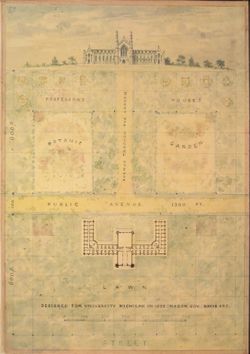

Throughout the 18th and 19th centuries, the lawn was an essential element of the American designed landscape. It was a stretch of grass turf occasionally referred to as grass-ground or greensward. Samuel Johnson defined “greensword” as “the turf on which grass grows.” These terms, however, were rarer in American usage than the term “lawn.”[1] Although descriptions exist of public spaces having lawns, such as the former bowling green in New York, described by John Lambert (1816), and the University of Virginia in Charlottesville, described by Margaret Bayard Smith (1828), other terms (such as square, park, green or bowling green, common, or mall) were more commonly used for public sites. The term “lawn” was used more often in descriptions of residential landscapes.
The scale of lawns ranged from modest to grand. Small dwelling yards contrasted with broad swaths of turf in settings as diverse as landscape parks at country homes, campuses [Fig. 1], hospitals, resorts, and public spaces that included greens and commons. Where rainfall, climate, and soil allowed, imported English grasses and cultivars, such as clover, were planted in lawns, and native meadow grasses were scythed to similar effect.[2] George Washington mentions planting his lawn with “English grass Seeds” in 1785. Correspondence between Charles Carroll (of Annapolis) and his son reveals the planning and labor involved in planting a lawn: "Severall Small Boys & Girls Have been employed. . . in picking English grass & white Clover seed. Ye 1st was allmost all shed, of ye latter I think I shall send you enough. . . In levelling yr ground I hope you have been Carefull to preserve ye top Soil & to lay it on again, Sowe yr Clover seed when ye Soil is moist, Rake it & when pretty dry Role it with yr Garden Roler is not too Heavy."[3]
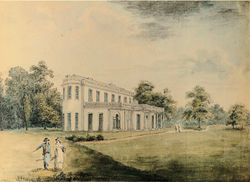

While turf was most likely cultivated in some fashion during colonial times, it was not until the last quarter of the 18th century that garden descriptions and other landscape writing registered the common practice of planting lawns, particularly among the larger gardens of the colonial elite.[4] Lawns continued to grow in popularity in America, and by the mid-19th century they were firmly established as a signature of the prosperous American homeowner’s landscape. These lawns became a stage for the social dramas of leisure and sport, depicted at White Sulphur Springs in Virginia, Elysian Fields in Hoboken, New Jersey [Fig. 2], and New Haven Green in Connecticut.[5]
Praising the merits of turf had a long tradition in treatise writing. Batty Langley (1728) included several unadorned “parterres of grass” in his designs, noting that “the Grandeur of those beautiful Carpets consists in their native Plainness” [Fig. 3]. Treatises for American audiences continued to offer instructions for maintaining lush, green lawns and recommended frequent scything or mowing, sweeping, and rolling, while acknowledging the limitations of the often hotter and dryer American climate.

The qualities praised in the didactic sources in terms of color and texture were reflected in representations of the American lawn in both verbal and visual descriptions. The smooth, green plane provided a pleasing setting for views of a house, as suggested by Margaret Bayard Smith’s 1828 description of James Madison’s Montpelier in Virginia, and by house portraits by such artists as Charles Fraser [Fig. 4], William Russell Birch [Fig. 5], and Benjamin Henry Latrobe [Fig. 6]. Distant views, such as Karl Bodmer’s painting of Point Breeze [Fig. 7], capitalized upon the effect of a house surrounded by an unobstructed lawn—the centerpiece of the estate presented like a jewel mounted on a swath of green velvet. In a similar manner, the unbroken plane of a green lawn provided a foreground for views from a main house. This idea was exemplified by several descriptions of Monticello, Mount Vernon, and William Hamilton's seat, The Woodlands, near Philadelphia, and was depicted in paintings, such as Benjamin Henry Latrobe's view from Mount Vernon [Fig. 8] and a view of the picturesque Green-Wood Cemetery in Brooklyn, New York, by James Smillie [Fig. 9]. This foreground effect of the lawn was further enhanced by planting trees at its edge in a diverging or undulating pattern, drawing the viewer’s attention outward, thus enhancing the distant view and accentuating the size of the lawn.
The appearance of an open lawn, freely blending with the landscape beyond, was an essential aspect of the “modern style” of English parks and of their American emulations. This effect was to be achieved, where possible, with the appearance of minimal human intervention. One technique was the use of the ha-ha, or, later, the wire fence, which provided a measure of protection against wildlife without interrupting the effect of a continuous transition from the house and lawn to the surrounding countryside. Writers and artists alike admired the contrast of the lawn, “smooth as velvet,” with the irregular, shadowy outline of trees, which helped to create the contrast and diversity espoused by advocates of the natural and picturesque styles. The disposition of groups of trees and shrubs suggested by John Abercrombie (1817) presented the lawn as a space through which one wandered, over which one’s gaze was carried to distant vistas, and on which animals grazed.[6] The principle was one that A. J. Downing espoused in A Treatise on the Theory and Practice of Landscape Gardening (1849) in his designs for residential gardens. Despite the emphasis in treatise texts on the use of broad, sweeping lawns in large-scale plantation and estate gardens, lawns were also important design elements in small, enclosed spaces, such as the Friends Almshouse in Philadelphia [Fig. 10]. In numerous examples dating from the 18th and 19th centuries, lawns were enclosed with either a screen of trees or a barrier of fencing, walls, or hedges.[7] Sometimes these enclosures were necessitated by space constraints, as seen, for example, in the anonymous painting of Col. George Boyd’s seat in Portsmouth, New Hampshire [Fig. 11], and, at times, by the desire to separate the lawn from other parts of the garden or work areas, as in Rebecca Couch’s painting of a Connecticut house [Fig. 12] (see Yard). Even in small lots, however, garden periodicals and treatises encouraged the juxtaposition of lawn and trees, beds, or shrubs to give the illusion of greater depth and to diversify the space [Fig. 13].
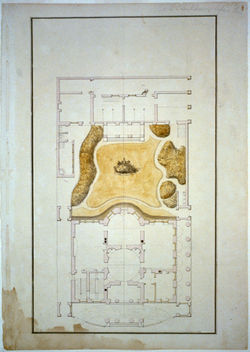
While the pursuit of the picturesque landscape continued through the mid-19th century (with proponents such as Bernard M’Mahon and Downing), another current of garden design was less concerned with mimicking the irregularity of nature than with the “clean unbroken line.” Promoted by British writers, such as Humphry Repton (1803) and J. C. Loudon (1826), and by American writers, such as Thomas Bridgeman (1832) and James E. Teschemacher (1835), the lawn was praised as a setting for variety within the garden, whether its carpet-like surface was cut into by the regular forms of walks and flower beds, or embellished with furniture, benches, arbors, and statuary. In contrast to qualities of diversity and irregularity, the frequent use of adjectives such as “polish,” “neatness,” and “precision” conveyed the effect of the lawn as a kind of canvas into which regular elements were cut or placed. In addition to their visual significance in American landscape design, lawns held social and symbolic significance. In both the 18th and 19th centuries, the lawn was perceived to be a sign of improved or “cultivated” space. For example, John Lambert in his 1816 account of the Hudson River area, found pleasure in the contrast between uncultivated woods and copses and cultivated lawns and meadows. In domestic residences, the green lushness sought after by admirers of the lawn was a mark of competence, investment, and, as Downing phrased it, “a universal passport to admiration.” Visitors often took note of a lawn’s color as a sign of its condition and a reflection of its owner’s care: Margaret Bayard Smith (1828) reported that the lawn at Montpelier was “green as in spring,” while David Bailie Warden (1816) admired the “beautiful verdure” of Analostan Island, Gen. John Mason’s summer house in Washington, DC. Turfing one’s grounds not only indicated an investment in the labor of planting and maintaining a lawn, but also signaled that one had the luxury of devoting time and space to something other than utilitarian kitchen gardens or orchards. Numerous portraits, such as that of Levin Winder [Fig. 14], depicted the sitter’s properties, including lawns expressive of status and wealth.
In addition to the lawn’s role as a marker of status, descriptions, such as that by Frederick Douglass of Col. Edward Lloyd’s Wye House in Talbot County, Maryland (1825), as a scene of “Eden-like beauty,” reflected the broader rhetoric of America as the new paradise with its bountiful, limitless space untainted by the crowding and evils of the Old World. In seeming contradiction, the lawn was also read as a sign of having an affinity with the vast estates and pleasure parks of civilized Europe. Several writers describing American residences noted that lawn and tree groupings, even in modest scale, alluded to the great landscape gardens of English manor houses that were known through the descriptions and tours in such works as Thomas Whately’s Observations on Modern Gardening (1770).[8] Both Douglass at Wye House and C. M. (Charles Mason) Hovey (1841) at William Demming’s residence, Presque Isle, in Fishkill, New York, described in Downing's Magazine of Horticulture, linked the American lawn to English parks.
In addition, in the second half of the 18th century the lawn referred to the agrarian roots of the new republic and to the classical villas, on which many of the planter gentry modeled their estates.[9] In short, the lawn was equated with the land itself. Even a small patch of green in a muddy, smelly town alluded to a plantation or country house, presumed or real. Granted, the rhetoric of the lawn as the vestigial rural seat of the natural legislator was one shared by an elite few, but it was a symbol of an ideology that shaped much of the political philosophy of the revolutionary and early national period. Jefferson, in Notes on the State of Virginia (1784), echoed French Physiocratic philosophers in his presentation of the land as the only true and moral source of wealth. J.-P. Brissot de Warville wrote upon visiting Mount Vernon in 1788 that George Washington had often been “compared to Cincinnatus: the comparison is doubtless just. This celebrated General is nothing more at present than a good farmer.”[10] America’s 18th-century landed gentry was not only versed in the arts of botany, geometry, astronomy, classics, and music, but also in farming their own land. The smooth spread of lawn, even at a modest scale surrounding an urban dwelling, could be read as a badge of allegiance to that agrarian ideal.
—Elizabeth Kryder-Reid
Texts
Usage
- Gordon, Lord Adam, May 1765, describing a house in Annapolis, MD (quoted in Mereness 1916: 408)[11]
- “. . . a house which was built for a Governour. . . but never was finished. . . the Situation of it most Elegant, Standing on an agreeable rising ground, in a beautiful Lawn, commanding the view of the Town.”

- Washington, George, October 6, 1785, describing Mount Vernon, plantation of George Washington, Fairfax County, VA (Jackson and Twohig, eds., 1978: 4:202)[12]
- “The appearances of the day, and the impracticability of giving, on acct. of the clammyness of the Earth, an even face to any more of my lawn, until the grd. should get dryer, of which there is no immediate prospect, I sowed what was levelled & smoothed of it, with English grass Seeds; and as soon as the top was so dry, as not to stick to the Roller, I rolled & cross rolled it; first with a light wooden roller; and then with a heavy wooden roller; with a view of compressing the Ground— smoothing the Surfice of it & to bury the Seeds.” [Fig. 15]
- Anonymous, January 21, 1790, describing in the Virginia Herald and Fredericksburg Advertiser a property for sale in Orange County, VA (Colonial Williamsburg Foundation)
- “To be sold, The place where I reside in Orange County, lying on the great mountain road, 30 miles from Fredericksburg. . . a lawn of 10 acres surrounding the dwelling houses.”
- Bartram, William, 1791, describing Marshall Plantation, on the San Juan River, FL (1928: 84)[13]
- “The house was situated on an eminence, about one hundred and fifty yards from the river. . . On the other side was a spacious garden, occupying a regular slope of ground down to the water; and a pleasant lawn lay between.”
- Bentley, William, April 21, 1791, describing a house and garden in Newbury, MA (1962: 1:249)[14]
- “[74] 21. . . . Hon. Mr Jackson shewed me his elegant mansion House. It is situate in the upper Street above the Church towards Amsbury ferry. It has a spacious lawn behind it with a gradual descent, & is near the house of John Tracey. The banks slope from the House.”
- Tucker, Saint George, 1793, describing a passage of landscape in his “Almanack” (quoted in Martin 1991: 222, n39)[15]
- “How sweet is the landscape before us!—the distant mountains mingle with the azure, and all between is the finest penciling of nature. The verdant lawn, the tufted grove, the dusky tower, the hanging wood, the winding stream and tumbling water fall, compose the lovely picture before you.”
- Brown, Charles Brockden, 1798, describing a fictional character’s home (1798: 58–59)[16]
- “One sunny afternoon, I was standing in the door of my house, when I marked a person passing close to the edge of the bank that was in front. . .
- “such figures were seldom seen by me, except on the road or field. This lawn was only traversed by men whose views were directed to the pleasures of the walk, or the grandeur of the scenery.”

- Weld, Isaac, 1799, describing Mount Vernon, plantation of George Washington, Fairfax County, VA (1799: 53)[17]
- “In front, the breadth of the whole building, is a lawn with a gravel walk round it, planted with trees, and separated by hedges on either side from the farm yard and garden. As for the garden, it wears exactly the appearance of a nursery, and with every thing about the place indicates that more attention is paid to profit than to pleasure. The ground in the rear of the house is also laid out in a lawn, and the declivity of the Mount, towards the water, in a deer park.” [Fig. 16]
- Codman, Dr. John, July 18, 1800, in a letter to Sarah Codman, describing the Grange, estate of Dr. John and Sarah Codman, Lincoln, MA (Society for the Preservation of New England Antiquities, Codman Family Manuscript Collection, box 118, folder 1,923.)
- “Mrs. Gore and myself have been planning improvements at Lincoln, she says it is the handsomest place in America and might be made a l’anglaise with ease. I like her plan that the fore-yard should be thrown down into a lawn that carriages may drive to the front door.”
- Cutler, Manasseh, January 2, 1802, in a letter to his daughter, Mrs. Torrey, describing The Woodlands, seat of William Hamilton, near Philadelphia, PA (1987: 2:145)[18]
- “We then walked over the pleasure grounds in front and a little back of the house. It is formed into walks, in every direction, with borders of flowering shrubs and trees. Between are lawns of green grass, frequently mowed to make them convenient for walking, and at different distances numerous copse of native trees, interspersed with artificial groves, which are set with trees collected from all parts of the world.”
- Jefferson, Thomas, c. 1804, describing improvements for Monticello, plantation of Thomas Jefferson, Charlottesville, VA (quoted in Nichols and Griswold 1978: 111)[19]
- “The ground between the upper and lower roundabouts to be laid out in lawns & clumps of trees, the lawns opening so as to give advantageous catches of prospect to the upper roundabout.” [Fig. 17]
- Drayton, Charles, November 2, 1806, describing The Woodlands, seat of William Hamilton, near Philadelphia, PA (1806: 54—58)[20]
- “The Approach, its road, woods, lawn & clumps, are laid out with much taste & ingenuity. Also the location of the Stables; with a Yard between the house, stables, lawn of approach or park, & the pleasure ground or garden.
- The Fences separating the Park-lawn from the Garden on one hand, & the office yard on the other, are 4 ft. 6 high. . . The park lawn is not in good order, for lack of being fed upon. . .
- “The Garden consists of a large verdant lawn surrounded by a belt of walk, & shrubbery for some distance. . .
- “The Stable Yard, tho contiguous to the house, is perfectly concealed from it, the Lawn, & the Garden. . . This sloping passage being a segment of a circle, & its two outer walls concealed by loose hedges, & by the projection of the flat roofed Screen of masonry, keeps the yard, & I believe the whole passage out of sight from the house—but certainly from the garden & park lawn.” [Fig. 18]
- Ticknor, George, 1815, describing Monticello, plantation of Thomas Jefferson, Charlottesville (quoted in Jones 1957: 3–4)[21]
- “He [ Thomas Jefferson ] lives on a mountain. . . We were obliged to wind two thirds round its sides before we reached the artificial lawn on which the house stands. . . The lawn on the top, as I hinted, was artificially formed by cutting down the peak of the height. In its centre, and facing the southeast, Mr. Jefferson has placed his house.”
- Lambert, John, 1816, describing the Hudson River Valley, NY (1816: 2:45)[22]
- “The cultivated parts are intersected with small woods, coppices, and clumps of trees, which add much to the diversity of the scenery, and form a pleasing contrast to lawns, meadows, and cornfields.”
- Lambert, John, 1816, describing New York, NY (1816: 2:57)[22]
- “At the commencement of the Broadway, near the Battery, stands the old Government-house, now converted into offices for the customs. Before it is a small lawn railed in, and in the centre is a stone pedestal, upon which formerly stood a leaden statue of George the Third.”
- Paulding, James Kirke, 1816, describing Berkeley Springs, VA (later WV) (1817: 1:196)[23]
- “The visiters live in cabins built of square logs, whitewashed, and disposed in a range just on the skirts of a little lawn, so that they have all the air of a rural village.”
- Warden, David Bailie, 1816, describing Analostan Island, seat of Gen. John Mason, Washington, DC (quoted in Junior League of Washington 1977: 106)[24]
- “The garden, the sides of which are washed by the waters of the river, is ornamented with a variety of trees and shrubs, and in the midst, there is a lawn covered with a beautiful verdure.” [Fig. 19]
- Forman, Martha Ogle, 1818, 1820, and 1823, describing Rose Hill, home of Martha Ogle Forman, Baltimore County, MD (1976: 60, 102, 159)[25]
- “[24 April 1818] Ramsey. . . has erected on the lawn a handsome Cage for the Hawk Pen, he has also made for us a Chicken, a duck, a Turkey, and a goose Coop. . . .
- “[11 May 1820]. . . Mowed our lawn, which looks beautiful. . .
- “[8 May 1823] Rachel finished whitewashing the garden poles, the Pigeon house and the fence round the lawn.”
- Silliman, Benjamin, 1824, describing Monte Video, property of Daniel Wadsworth, Avon, CT (1824: 12)[26]
- “To the west, the lawn rises gradually from the water, until it reaches the portico of the house, near the brow of the mountain, beyond which, the western valley is again seen.” [Fig. 20]
- Bacon, Edmund, 1825, describing Monticello, plantation of Thomas Jefferson, Charlottesville, VA (quoted in Adams 1976: 329)[27]
- “The grounds around the house were most beautifully ornamented with flowers and shrubbery. There were walks, and borders, and flowers, that I have never seen or heard of anywhere else. Some of them were in bloom from early spring until late in the winter. A good many of them were foreign. Back of the house was a beautiful lawn of two or three acres, where his grandchildren used to play a great deal.” [Fig. 21]
- Douglass, Frederick, 1825, describing Wye House, estate of Col. Edward Lloyd, Talbot County, MD (1855; repr., 1987: 47)[28]
- “The carriage entrance to the house was a large gate, more than a quarter of a mile distant from it; the intermediate space was a beautiful lawn, very neatly trimmed, and watched with the greatest care. It was dotted thickly over with delightful trees, shrubbery, and flowers. The road, or lane, from the gate to the great house, was richly paved with white pebbles from the beach, and, in its course, formed a complete circle around the beautiful lawn. Carriages going in and retiring from the great house, made the circuit of the lawn, and their passengers were permitted to behold a scene of almost Eden-like beauty. Outside this select inclosure, were parks, where—as about the residences of the English nobility—rabbits, deer, and other wild game, might be seen, peering and playing about, with none to molest them or make them afraid.”
- Smith, Margaret Bayard, August 2, 1828, in a letter to Mrs. Boyd, describing the University of Virginia, Charlottesville, VA (1906: 225)[29]
- “A vast wide lawn separates the two rows of pavillions and dormitories.” [Fig. 22]
- Smith, Margaret Bayard, August 17, 1828, in a letter to Mrs. Boyd, describing Montpelier, plantation of James Madison, Montpelier Station, VA (1906: 233)[29]
- “We were at first conducted into the Drawing room, which opens on the back Portico and thus commands a view through the whole house, which is surrounded with an extensive lawn, as green as in spring; the lawn is enclosed with fine trees, chiefly forest, but interspersed with weeping willows and other ornamental trees, all of most luxuriant growth and vivid verdure. It was a beautiful scene!”
- Trollope, Frances Milton, 1830, describing Fairmount Waterworks, Philadelphia, PA (1832: 2:43)[30]
- “On the farther side of the river is a gentleman’s seat, the beautiful lawns of which slope to the water’s edge, and groups of weeping-willows and other trees throw their shadows on the stream. The works themselves are enclosed in a simple but very handsome building of freestone. . . behind the building, and divided from it only by a lawn, rises a lofty wall of solid lime-stone rock, which has, at one or two points, been cut into, for the passage of the water into the noble reservoir above.”
- Mason, Gen. John, c. 1830, describing Gunston Hall, seat of George Mason, Mason Neck, VA (quoted in Rowland 1964: 1:98)[31]
- “On the north front by which was the principal approach, was an extensive lawn kept closely pastured, through the midst of which ran a spacious avenue.”
- Thacher, James, December 3, 1830, “An Excursion on the Hudson,” describing Hyde Park, seat of David Hosack, on the Hudson River, NY (New England Farmer 9: 156)[32]
- “The mansion house at Hyde Park is elevated about 200 feet above the surface of the river. With its two wings it presents a noble front of 136 feet, and is two stories above the basement. The centre or principal building, has a piazza on both fronts; the west front is open to the Hudson, and the east looks over a spacious, beautiful lawn towards the turnpike from New York to Albany. . . The forest trees which surround the domicile are identically the natives which are found in our forest; some of the oaks are a century in age, and all are large and so grouped and intermingled over the lawn, as to present at every step the most fantastic views that can attract the pencil of the artist.”
- Latrobe, John H. B., August 1832, describing the University of Virginia, Charlottesville, VA (quoted in Semmes 1917: 247)[33]
- “There are four rows of buildings, composed of one story colonnades, under which are the student’s rooms; and at equal distances are the two inner rows and the professors’ houses two stories in height, with porticos of various architecture. At the upper side of the lawn is the rotunda, containing the library, a beautiful room.”
- Latrobe, John H. B., August 1832, describing White Sulphur Springs, VA (quoted in Semmes 1917: 252)[33]
- “Cottages hidden in the dark green foliage, long rows of white homes of all descriptions scattered here and there, and as we came into the precints, there on the right was the ascending lawn of the freshest verdure, surrounding with its picturesque cabins, with vehicles of all sorts under its trees. Gay groups laughing and enjoying the afternoon were assembled on the lawn. Here a gay party of equestrians careering on their return from their evening ride, here another prancing pellmell, here were fencers, here a group starting greyhounds for a race, here a number of serious smokers on one side by themselves, here a whole bevy of children with their whoop and hallo. Servants were hurrying to and fro. The quoit was flying in the air, and the roll of the nine pin ally came upon the ear with the crash and clatter of skittles.” [Fig. 23]
- Ingraham, Joseph Holt, 1835, describing a plantation near New Orleans, LA (1:235–36)[34]
- “we proceeded to the sugar-house or sucrérie, through a lawn which nearly surrounded the ornamental grounds about the house, studded here and there with lofty trees, which the good taste of the original proprietor of the domain had left standing in their forest majesty. From this rich green sward, on which two or three fine saddle-horses were grazing, we passed through a turnstile into a less lovely, but more domestic enclosure.”
- Martineau, Harriet, 1835, describing Jamaica Pond, vicinity of Boston, MA (1838: 2:182–83)[35]
- “A cottage on Jamaica Pond, for instance, within an easy ride of Boston, is a luxurious summer abode. I know of one unequalled in its attractions, with its flower-garden, its lawn, with banks shelving down to the mere; banks dark with rustling pines, from under whose shade the bright track of the moon may be seen, lying cool on the rippling waters.”
- Anonymous, April 1, 1837, describing Landscape Gardening (Horticultural Register and Gardener's Magazine 3: 130)[36]
- "Few are able to devote much ground or much expense in extensive ornamental plantation; but all may decorate the immediate vicinity of their residencies. The house should be situated at some distance from the road, which distance should be greater or less according as the house is large or small, and it should be on a moderate rise of ground. There should be a spacious open lawn or grass ground in front, which should be unoccupied by any objects except an occasional small groups of trees. . . If it is situated on an eminence, the back as well as front view may be exhibited to great advantage. . ."
- Hovey, C. M. (Charles Mason), October 1839, “Some Remarks upon several Gardens and Nurseries in Providence, Burlington, (N.J.) and Baltimore,” describing the residence of Horace Binney, Burlington, NJ (Magazine of Horticulture 5: 363)[37]
- “The flower garden is nearly a square, and is laid out with one main circular walk, running round the whole, and a border for flowers on each side; the centre forming a lawn scattered over with several large fruit trees.”
- MacDonald, James, October 1839, describing the Bloomingdale Asylum for the Insane, New York, NY (quoted in Hawkins 1991: 86)[38]
- “The approach to the Asylum from the southern entrance, by the stranger who associates the most sombre scenes with a lunatic hospital, is highly pleasing. The sudden opening of the view, the extent of the grounds, the various avenues gracefully winding through so large a lawn; the cedar hedges, the fir, and other ornamental trees, tastefully distributed or grouped, the variety of shrubbery and flowers; in fine, the assemblage of so many objects to please the eye, and relieve the melancholy mind from its sad musings, strike him as one of the most successful and useful instances of landscape gardening.”
- Buckingham, James Silk, April 1840, describing the garden of Father George Rapp, Economy, PA (1842: 2:227)[39]
- “This [the garden] covered about an acre and half of ground, and was neatly laid out in lawns, arbours, and flower-beds, with two prettily ornamented open octagonal arcades, each supporting a circular dome over a fountain.”
- Buckingham, James Silk, 1841, describing the Pennsylvania Hospital for the Insane, Philadelphia, PA (1841: 1:400–401)[40]
- “The greenhouses, containing a handsome collection of exotic plants, together with the ornamental lawns in front and rear of the house, are under the care of a regular gardener. The attention paid to neatness, and even ornament, in the exterior and interior of the house, gives to the whole an air of elegance seldom equalled in establishments of this nature.”
- Hovey, C. M. (Charles Mason), August 1841, “Notes made during a Visit to New York, Philadelphia, Baltimore, &c.,” describing the United States Capitol, Washington, DC (Magazine of Horticulture 8: 127–28)[41]
- “On each side of the centre avenues rows of trees are planted, and upon the grass lawns which intervene between the centre and outer walks, are two large circles of dug ground, planted with shrubs, dahlias, and other flowers.”
- Hovey, C. M. (Charles Mason), August 1841, “Notes made during a Visit to New York, &c.,” describing Presque Isle, residence of William Demming, Fishkill, NY (Magazine of Horticulture 7: 374)[42]
- “Beyond the grouping of trees on the bank of the river, and the stately forms of some of the single specimens on the lawn, we found but little to notice. Of the former we can speak in gratifying terms; for we are delighted to be able to give our evidence of the existence of so much of that landscape beauty among us, which is almost exclusively the peculiar feature of the gardening of Britain. Nature, it is true, has done much for the place, but art has also accomplished a great deal. . .
- “Through the belt on the border of the river, by cutting away the branches, views of the most interesting portions of the opposite side of the river have been opened. Were the lawn only kept closer, and more frequently mown, the walks filled with gravel and well rolled, we could have imagined ourselves in some of the fine old picturesque places of England.”
- Hovey, C. M. (Charles Mason), November 1841, “Select Villa Residences,” describing Highland Place, estate of A. J. Downing, Newburgh, NY (Magazine of Horticulture 7: 403)[43]
- “3. Lawn; which descends very gradually to the nursery grounds in front. The piece being too narrow to admit of greater width, the lawn was lengthened to have the appearance of more breadth of surface. This should be borne in mind by those whose grounds are so situated as to prevent their obtaining the requisite width. There is another object which should be taken into consideration, when forming a lawn in front of a house situated on the bank of a river, like Mr. Downing's, and commanding such fine views: the distant scenery would be hid by the extent of trees which would intervene, unless very judiciously managed.”
- Blair, Francis P., July 1, 1843, describing Hermitage, estate of Andrew Jackson, Nashville, TN (Ladies Hermitage Association Research #977)
- “On one side of the lawn leading to the house, is the garden which embosoms the monument which covers the grave of Mrs. Jackson. . . On the other side of the lawn is the orchard; and in front is a large woodland (whose extent cannot be seen) for the most part of the tall tulip poplars, are left almost in a state of native wildness.”
- Longfellow, Alexander W., January 1844, describing the Vassall-Craigie-Longfellow House, Cambridge, MA (quoted in Evans 1993: 38)[44]
- “We were very busy planning the grounds & I laid out a linden avenue for the Professor’s private walk. I was often reminded of your fancy for such things. . . The house is to be repaired but not essentially altered, the old out buildings to be removed, trees planted a pond, & rustic bridge, created the pond is an apology for the bridge.”

- Downing, Andrew Jackson, November 1846, describing Livingston Manor, seat of Mary Livingston, on the Hudson River, NY, and Camac Cottage, near Philadelphia (Horticulturist 1: 204)[45]
- “There are two residences in this country which so far surpass all others in the perfection of their lawns, that we hope to be pardoned for holding them up to commendation. . .
- “The lawn at the Livingston Manor is very extensive and park-like—certainly the largest well-kept lawn in America, and we wish all our readers who are skeptical regarding an American lawn, could see and feel its many excellent perfections. They would only be still more surprised when they were told how few men keep so large a surface in the highest order. [Fig. 24]
- “The Camac Cottage is a gem of neatness and high keeping. We hope Pennsylvanians at least, who, we think, have perhaps our best lawn climate, will not fail to profit by so admirable an example as they will find there, of what SPENSER quaintly and prettily calls ‘the grassie ground.’”
- Anonymous, August 1848, describing Riversdale, estate of George and Rosalie Stier Calvert, Prince George’s County, MD (American Farmer 4: 53)[46]
- “On either front is an ample lawn with shade trees, grass plots, parterres, shrubbery, and flowers, whose effect upon the senses impart an interest to the view, warm the mind into admiration, and give assurance, that a chastened taste and artistic skill had presided while these were being fashioned into form. . . These improvements were made by the present proprietor’s ancestors, in the beginning of the present century, but are still in a state of the most perfect preservation.”
- Justicia [pseud.], March 1849, “A Visit to Springbrook,” seat of Caleb Cope, near Philadelphia (Horticulturist 3: 411)[47]
- “The elegant mansion is surrounded with a spacious lawn, kept in a masterly style; and the pleasure-grounds are enclosed by a light iron fence, about half a mile in length, and studded with many varieties of hardy trees, backed by a natural piece of the most majestic woods,—giving a fine sylvan character to the place.”
- Hovey, C. M. (Charles Mason), December 1849, describing Oatlands, residence of D. P. Manice, Hempstead, NY (Magazine of Horticulture 15: 529–31)[48]
- “The house is a handsome building, in a kind of castellated gothic, standing about fifty feet from the road, with the conservatory and hothouse, and flower garden on the left,—the kitchen garden and forcing-houses on the right,—and the lawn and pleasure ground, in the rear of the house, separating it from the park. . .
- “we continued on to the lawn, where we found much of interest in the various specimens of trees and shrubs.”
- Eppes, Francis, c. 1850, describing Eppington, plantation of Francis Eppes, on the James River, VA (quoted in Weaver 1969: 31)[49]
- “The mansion-house itself. . . was placed at the extreme side of a large level or lawn, covered with green sward, extending to a considerable distance in front, and declining on the left side as you entered, and in the rear of the house to the low grounds of the Appomattox, a mile off. In front and over the neighborhood road which skirted the lawn, was situated the garden. . . The mansion. . . was almost imbedded in a beautiful double row of the tall Lombardy poplar. . . and this row reached to another double row or avenue which skirted one side of the lawn, dividing it from the orchard and stables. The lawn in front was closed in by a fence with a small gate in the middle and a large one on either extremity, one opposite the avenue of poplars, and the other at the end of the carriageway which swept around it.”
- Londoniensis [pseud.], October 1850, “Notes and Recollections of a Visit to the Nurseries of Messrs. Hovey & Co., Cambridge” (Magazine of Horticulture 16: 443)[50]
- “In front of this house is a fine open lawn, of an acre or more, dotted with clumps of flowering plants, and single trees of the rarer species, more particularly of the new weeping trees and coniferae. This lawn is encircled by a broad walk, on the lawn side of which are circular beds of the choicest summer blooming plants. I did not much like this multitude of circular beds, but it is the general style throughout the country.”
- Downing, Andrew Jackson, 1851, describing plans for improving the public grounds of Washington, DC (quoted in Washburn 1967: 55)[51]
- “The pleasing natural undulations of surface, where they occur, I propose to retain, instead of expending money in reducing them to a level. The surface of the Parks, generally, should be kept in grass or lawn, and mown by the mowing machine used in England, by which, with a man and horse, the labor of six men can be done in one day.”
- Jones, C. C., 5 June 1851, describing Hermitage, estate of Andrew Jackson, Nashville, TN (1851; repr. 1976: 175)[52]
- “An iron gate let us into the lawn immediately before the mansion; nor had we in our approach seen anything more than the top of a chimney or the glimpse of a wall or pillar; nor did we see anything now, so embosomed is it in trees, and so full of small cedars and shrubbery is the lawn. The road winds around an enclosed plat in shape resembling a guitar, shut in by low white posts connected by a small rope with one another. The grass in this lot was much grown, and we observed that the mower had commenced to smooth it off with his scythe.”

- Downing, Andrew Jackson, August 1851, “The Annual Cattle Sale at Mount Fordham,” describing Mount Fordham, seat of Lewis G. Morris, New York, NY (Horticulturist 6: 372)[53]
- “Around the house at Mount Fordham, extends on all sides a kind of meadow-lawn, enclosed and divided by pretty wire fences of various patterns. This lawn is kept short by the grazing of improved dairy stock, and we were glad to see successfully practiced what we have been commending so strongly of late to our readers, as the most available point of English country places, that we saw on the other side of the Atlantic—that is the maintenance of a neat and handsome lawn about a country house, not only without the expense of mowing, but with united profit and beauty—the profit of grazing the grass and the beauty—the real pastoral beauty—of fine cattle, soft turf, and pleasant groups of trees, as the home landscape of our country places generally. By adopting this course, the hay-field aspect of many so-called gentlemen’s country-seats, would disappear, and a more complete and satisfactory lawn or park be acquired, with no loss of money, and the attainment of a higher species of keeping to one’s country home. [Fig. 25]
Citations
- Switzer, Stephen, 1718, Ichnographia Rustica (1718: 2:200)[54]
- “If the Wood is thin, ‘tis there one may clear it quite away, and make open Lawns. And if the Wood be an Eminence, then all the small Stuff on the Outside ought to be clear’d away, to open the distant Prospect, if it deserve it; but if it be an unsightly, barren Prospect, then let the Wood remain to blind it.”
- Langley, Batty, 1728, New Principles of Gardening (1728; repr., 1982: 195, 201)[55]
- “General DIRECTIONS, &c. . .
- “I. THAT the grand Front of a Building lie open upon an elegant Lawn or Plain of Grass, adorn’d with beautiful Statues, (of which hereafter in their Place,) terminated on its Sides with open Groves. . .
- “VI. That no Borders be made, or Scroll-Work cut, in any such Lawn or plain Parterre; for the Grandeur of those beautiful Carpets consists in their native Plainness. . .
- “XXX. Open Lawns should be always in Proportion to the Grandeur of the Building; and the Breadth of Avenues to the Fronts of Edifices, and their own Length also.”
- Ranlett, William H., describing Frances Palmer’s work (Ranlett 1847 1:25)[56]
- PLATE 18 - Ground plot, for Design III. and IV., of houses, proposed to be erected near the shore, at Clifton, Staten Island, 100 ft. by 150 each, showing the location of the houses and other buildings, with the walks, carriage way, shrubbery&c., also a stream of water between the lawn and vegetable garden.
- Miller, Philip, 1759, The Gardeners Dictionary (1759: n.p.)[57]
- “In a fine Garden, the first thing that should present itself to the Sight should be an open lawn of Grass which is size should be proportionable to the garden; in a large garden it should not be less than six or eight acres. . . The figure of this lawn need not be regular, and if on the Sides there are trees planted irregularly, by way of an open Grove, some of which may be planted forwarder upon the lawn than the others, whereby the regularity of the lawn will be broken, it will render it more like nature.”
- Society for the Encouragement of Arts, Manufacturers and Commerce, 1769, The Complete Farmer (1769: n.p.)[58]
- “The flower-garden should be made near the back-front of the house, from whence a descent of six or seven steps will finely embellish the whole. Proper room should be allowed for a lawn of sufficient extent, which, if it be the first object that strikes the sight, will have a very pleasing effect.”
- Ogilvie, George, 1776, Carolina, or The Planter (1790; repr., 1986: 67–68)[59]
- “Here Pales seems with Flora to have strove,
- To blend the beauties of the lawn and grove;
- Till ev’ry season yields its ev’ry flow’r,
- Pride of the month, or pageant of the hour.”
- Marshall, Charles, 1799, An Introduction to the Knowledge and Practice of Gardening (1799: 1:124)[60]
- “Here [about the house] should be also a good portion of grass plat, or lawn, which so delights the eye when neatly kept, also borders of shewy flowers, which, if backed by any kind of fence, it should be hid with evergreens, or at least with deciduous shrubs, that the scene may be as much as possible vivacious.”
- Repton, Humphry, 1803, Observations on the Theory and Practice of Landscape Gardening (1803: 13, 46)[61]
- “There is no error more prevalent in modern gardening, or more frequently carried to excess, than taking away hedges to unite many small fields into one extensive and naked lawn, before plantations are made to give it the appearance of a park; and where ground is subdivided by sunk fences, imaginary freedom is dearly purchased at the expence of actual confinement. . .
- “In some situations where great masses of wood, and a large expanse of open lawn prevail, the contrast is too violent, and the mind becomes dissatisfied by the want of unity; we are never well pleased with a composition in natural landscape, unless the wood and the lawn are so blended that the eye cannot trace the precise limits of either.”
- M’Mahon, Bernard, 1806, The American Gardener’s Calendar (1806: 55–57)[62]
- “THE district commonly called the Pleasure, or Flower-Garden, or Pleasure-ground, may be said to comprehend all ornamental compartments, or divisions of ground, surrounding the mansion; consisting of lawns, plantations of trees and shrubs, flower compartments, walks, pieces of water, &c. whether situated wholly within the space generally considered as the Pleasure-Garden, or extended to the adjacent fields, parks, or other out-grounds. . .
- “For instance, a grand and spacious open lawn, of grass-ground, is generally first presented immediately to the front of the mansion, or main habitation; sometimes widely extended on both sides, to admit of a greater prospect, &c. and sometimes more contracted towards the habitation; widening gradually outwards, and having each side embellished with plantations of shrubbery, clumps, thickets, &c. in sweeps, curves, and projections, towards the lawn; with breaks or opens of grass-spaces at intervals, between the different plantations; together with serpentine gravel walks, winding under the shade of the trees. . .
- “First an open lawn of grass-ground is extended on one of the principal fronts of the mansion or main house, widening gradually from the house outward, having each side bounded by various plantations of trees, shrubs, and flowers, in clumps, thickets, &c. exhibited in a variety of rural forms, in moderate concave and convex curves, and projections, to prevent all appearance of a stiff uniformity; introducing between the plantations at intervals, breaks or opens of grass-ground, communicating with the lawn and internal divisions, in some places widely spread, in others more contracted; leaving also tracts for serpentine gravel-walks, some winding under the shade of the plantations, so conducted as to command views of the lawn and interior divisions occasionally, and at intervals, of the most beautiful parts of the surrounding country.”
- Abercrombie, John, with James Mean, 1817, Abercrombie’s Practical Gardener (1817: 473)[63]
- “The commencement of the lawn should be wider than the front of the house; and the sides of it should diverge, so that if screens of plantation leave only a front view, the eye may not feel itself confined.
- “In proportion as the lawn is extensive or the surface uniform, it requires to be broken by groups of shrubs and trees. The principle on which variety, and some degree of intricacy, are essential, in the composition of a pleasing scene, may be illustrated by surveying an immense flat meadow.”
- Loudon, J. C. (John Claudius), 1826, An Encyclopaedia of Gardening (1826: 1020)[64]
- “7262. The lawn, or that breadth of mown turf formed in front of, or extending in different directions from, the garden-front of the house, is, in the geometric style, varied by architectural forms, levels, and slopes; and in the modern by a picturesque or painter-like disposition of groups, placed so as to connect with the leading masses, and throw the lawn into an agreeable shape or shapes. In very small villas the lawn may embrace the garden or principal front of the house, without the intervention of terrace-scenery, and may be separated from the park, or park-like field, by a light wire fence; but in more extensive scenes it should embrace a terrace, or some avowedly artificial architectural basis to the mansion, and a sunk wall, as a distant separation, will be more dignified and permanent than any iron fence. The park may come close up to the terrace-garden, especially in a flat situation, or where the breadth of the terrace is considerable.”
- Webster, Noah, 1828, An American Dictionary of the English Language (1828: 2:n.p.)[65]
- “LAWN, n. [W. llan, an open, clear place. It is the same word as land, with an appropriate signification, and coincides with plain, planus, Ir. cluain.]
- “A open space between woods, or a plain in a park or adjoining a noble seat.
- “Betwixt them lawns or level downs, and flocks “Grazing the tender herbs, were interspers’d. Milton.”
- Floy, Michael, September 24, 1830, “Description of Trees and Shrubs” (New England Farmer 9: 74)[66]
- “Platanus occidentalis, Button-ball, by some called Sycamore, is a large and majestic tree, calculated for avenues or large lawns, or for ornamental plantations. . .
- “Umlas, or Elm, three kinds, the European Elm, the American White Elm, and the American Slippery Elm, are all desirable to form a good landscape for lawns or avenues, &c.
- “Tilia Americana, the American Lindin, and the Tilia Europea, are both beautiful trees, well calculated for streets or lawns—the trees grow handsome, and when in flower, the honey bees are much attracted to its sweet, honey-like perfume.”
- Bridgeman, Thomas, 1832, The Young Gardener’s Assistant (1832: 112)[67]
- “[Regarding the flower garden] If there are lawns or grass walks, they should be frequently trimmed, and more frequently mowed and rolled, to prevent the grass from interfering with the flower beds, and to give the whole a neat regular carpet-like appearance.”
- Teschemacher, James E., June 1, 1835, “On Horticultural Architecture” (Horticultural Register 1: 228)[68]
- “The garden behind the house may if large be composed of three parts.
- “1st. A grass lawn.
- “2d. Separate beds for distinct flowers.
- “3d. A boundary of ornamental shrubs. . .
- “The lawn may be formed either by sowing seed. . . this will take, however, two or three years to bring to fine order—therefore the quickest way is to pare turf from a meadow and lay it down evenly, the pieces close to each other; they will soon join and form a continuous surface. The great beauty of this ornament to the garden consists in having it soft to tread on, and a beautiful bright green color; this can always be effected by mowing frequently. . . After each mowing the lawn must be neatly swept, and then rolled with a roller of iron, preferable to one of stone. The edges of the walk should be kept trimmed so as to present a clean unbroken line. . . A lawn kept in this style is certainly always an object of delight to the eye, and preferable to the finest carpet for the foot—but if not neatly kept it had better be omitted altogether from the garden. The form of lawns must depend on the extent, the surface, or on individual taste; a few short and simple rules for general forms will be given in a future part of these papers.
- “If extensive, the lawn may be diversified by clumps of ornamental trees or if the space be small by single trees.
- “The approach to the house should be by a broad semi-circular drive intersecting the lawns, and leading by branches to the stables and out buildings, as well as to the flower and kitchen gardens; this last, if near the house, must be completely concealed, either by walls covered with fruit trees, or by shrubberies, and may be preferably laid out in a series of parallelograms.
- Teschemacher, James E., November 1, 1835, “On Horticultural Architecture” (Horticultural Register 1: 411)[69]
- “The vicinity of Boston abounds so much in every variety of beautiful landscape, that there is scarcely any place where art is less required in laying out pleasure grounds. . . after leaving this paradise of sweets, passing some distance through a thick plantation of the most ornamental forest trees of America, including the varieties of pine and fir, then suddenly emerging on the beautiful expanse of grass lawn in front; all this, owing to the natural advantages of the country surrounding Boston, may be accomplished at a comparatively trifling expense and loss of time.”
- Sayers, Edward, February 1838, “On Laying out Gardens and Ornamental Plantations: Laying out Approaches and Planting Shrubberies” (Horticultural Register 4: 62)[70]
- “In such grounds the front part next to the road, may be appropriated to a grass plot or lawn, planted with a few ornamental trees, as the Balsam Fir, Mountain Ash, and the like, which gives a relief to the carriage road that will pass close to the front door, and have an appearance of easy access to and from the house to the carriage.”
- Downing, Andrew Jackson, November 1846, “A Chapter on Lawns” (Horticulturist 1: 202, 204)[71]
- “In short, the ideal of grass is a lawn, which is, to a meadow, what ‘Bishop’s lawn’ is to homespun Irish linen.
- “With such a lawn, and large and massive trees, one has indeed the most enduring sources of beauty in a country residence. Perpetual neatness, freshness and verdure in the one; ever expanding beauty, variety and grandeur in the other—what more does a reasonable man desire of the beautiful about him in the country? . . .
- “After your lawn is once fairly established, there are but two secrets in keeping it perfect— frequent mowing and rolling. Without the first, it will soon degenerate into a coarse meadow; the latter will render it firmer, closer, shorter, and finer every time it is repeated. . .
- “There are but few good lawns yet in America; but we have great pleasure in observing that they are rapidly multiplying. Though it may seem a heavy tax to some, yet no expenditure in ornamental gardening is, to our mind, productive of so much beauty as that incurred in producing a well kept lawn. Without this feature, no place, however great its architectural beauties, its charms of scenery, or its collections of flowers and shrubs, can be said to deserve consideration in point of landscape gardening; and with it the humble cottage grounds will possess a charm which is, among pleasure grounds, what a refined and graceful manner is in society—an universal passport to admiration.”
- Johnson, George William, 1847, Dictionary of Modern Gardening (1847: 343–44)[72]
- “LAWN is a surface of turf in the vicinity of the house, requiring to be kept smooth by the regular application of the roller and scythe. When first constructed, after the ground has been dug over as level as may be, it must be rolled, the hollows filled up, and this repeated until a level surface of earth is obtained. It must then be slightly pointed over with a fork, and the turf laid, or the grass seed sown. See Turfing.”
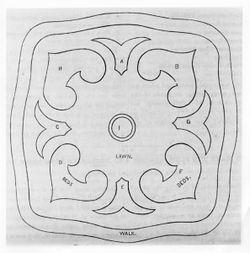
- Downing, Andrew Jackson, May 1848, “Design for a Small Flower Garden” (Horticulturist 2: 503–4)[73]
- “The following little plan of a flower garden, of this kind, on a small scale, is adopted from one of the designs of our late friend, Mr. LOUDON. It is supposed to be formed in a plot of smooth level lawn, and to be surrounded by a boundary walk, which may, or may not, be backed by a belt of evergreens and flowering shrubs. In the former case, it would make a complete little scene by itself in a portion of the garden or grounds.” [Fig. 26]
- Downing, Andrew Jackson, 1849, A Treatise on the Theory and Practice of Landscape Gardening (1849; repr., 1991: 75, 343, 525–27)[74]
- “But the lawn may be less frequently mown, the edges of the walks less carefully trimmed, where the Picturesque prevails; while in portions more removed from the house, the walks may sometimes sink into a mere footpath without gravel, and the lawn change into the forest glade or meadow. . .
- “A wide-spread lawn, on the contrary, where no boundaries are conspicuous, conveys an impression of ample extent and space for enjoyment. . .
- “As a lawn is the ground-work of a landscape garden. . . “The unrivalled beauty of the ‘velvet lawns’ of England has passed into a proverb. This is undoubtedly owing, in some measure, to their superior care and keeping, but mainly to the highly favorable climate of that moist and sea-girt land. . .
- “Our climate, however, is in the middle states one of too much heat and brilliancy of sun, to allow us to keep our lawns in the best condition without considerable care. . .
- “the whole beauty of a lawn depends on frequent mowing. . .
- “We can already, especially in the finer places on the Hudson, and about Boston, boast of many finely kept lawns, and we hope every day, as the better class of country residences increases, to see this indispensable feature in tasteful grounds becoming better understood and more universal.”
- Elder, Walter, 1849, The Cottage Garden of America (1849: 26)[75]
- “The rich gentleman may have his broad domain finely diversified with wood lots, open fields, deep ravines, creeks, cataracts, canals, rock works, fancy or rustic bridges, etc.; and the wide extended lawn, with its dark green sod, which surrounds his mansion, may be beautifully interspersed with winding walks and deciduous evergreen trees.”
- Downing, Andrew Jackson, March 1850, “How to Arrange Country Places” (Horticulturist 4: 395)[76]
- “Be that as it may, the ground-work of this part [the ornamental portion of a country place] should, in our judgment, always be LAWN. There is in the country no object which at all seasons and times gives the constant satisfaction of the green turf of a nicely kept lawn. If your place is large, so much larger and broader is the good effect of the lawn, as it stretches away, over gentle undulations, alternately smiling and looking serious, in the play of sunshine and shade that rests upon it. If it is small—a mere bit of green turf before your door— then it forms the best and most becoming setting to the small beds and masses of everblooming roses, verbenas, and gay annuals, with which you embroider it, like a carpet.
- “Lawn, there must be, to give any refreshment to the spirits of man in our country places; for nothing is so intolerable to the eye as great flower-gardens of parched earth, lying half baked in the meridian sun of an American summer. And though no nation under the sun may have such lawns as the British, because Britain lies in the lap of the sea, with a climate always more or less humid, yet green and pleasant lawns most persons may have in the northern states, who make the soil deep and keep the grass well mown.”
- Webster, Wm., October 1850, “Laying Out and Planting Lawns” (Horticulturist 5: 163)[77]
- “And now for the greatest point of attraction—the lawn. What can be more beautiful than a well kept lawn, with its drooping trees, and beds of flowers, and many other attractions? No matter however beautiful a place may appear, it is still incomplete without its due proportion of grass; in fact, a well kept lawn lends a charm to all surrounding objects, and gives effect to the whole. In the formation of lawns, I would recommend the laying down of turf, in preference to seeding one. When a lawn is sown, it takes a great length of time to get a good turf; whereas, by laying one down, a fine even surface is obtained at once, and a beautiful verdure. Fancy figures may also be cut around the edges, or in different parts of the lawn, for the planting of flowers in masses, such as Verbenas, Petunias, Fuchsias, and the like. Drooping trees should also be planted in different parts of the lawn singly; the beauties of which, I need not here descant upon, as it has already been so ably done by Mr. BARRY, in the last number of this journal. All close fences, or any unsightly objects, should be hid by trees, or covered with climbing plants or creepers.”
- New York State Lunatic Asylum Trustees, 1851, describing the ideal grounds for a lunatic asylum (quoted in Hawkins 1991: 53)[38]
- “The salutary influence on the insane mind of highly cultivated lawns—pleasant walks amid shade trees, shrubbery, and fountains, beguiling the long hours of their [sic] tedious confinement—giving pleasure, content, and health, by their beauty and variety, are fully appreciated by us.”
- Breck, Joseph, 1851, The Flower-Garden (1851: 31–32)[78]
- “No flower-garden can be complete without some grass. There are but very few, however, who can afford the luxury of an extensive grass lawn; but every one wishes for a few rods, at least, about the house; this may lay between the house and garden. When there is but a small surface to grass over, it may be done with turf, if it can be obtained of a good quality, which is not often the case. . .
- “To have a fine lawn, it is necessary not only to mow it often, but roll it also, especially after a rain. By doing thus, a close texture and fine velvety turf may be obtained.”
Images
Inscribed
Samuel Vaughan, Sketch plan of Mount Vernon, June–September 1787. "19. Lawn."
Benjamin Henry Latrobe, View to the North from the Lawn at Mount Vernon, 1796.
Benjamin Henry Latrobe, Sketch Plan of Serpentine Walks at Mount Vernon [detail], July 19, 1796. Verso of View to the North from the Lawn at Mount Vernon, RS4693.
Mutual Assurance Society, Richmond, Declaration for Assurance Book, vol. 26, policy no. 2049, Insurance policy drawings for Mount Vernon, March 13, 1803.
Thomas Jefferson, Sketch of the garden and flower beds at Monticello, June 7, 1807. “. . . winding walk surrounding the lawn before the house.”
Anonymous, Plan of the Harvard Botanic Garden, c. 1807. “B. lots or small lawns with flowering Shrubs.”
J. C. Loudon, Plan of a flower garden with lawn (b), in An Encyclopædia of Gardening, 4th ed. (1826), 791, fig. 540.
Alexander Jackson Davis, Mount Vernon, c. 1831.
Alexander Jackson Davis, Design for University of Michigan (elevation and plan of building and grounds), c. 1838.
Miller & Co., Map of the residence & park grounds, near Bordentown, New Jersey: of the late Joseph Napoleon Bonaparte, ex-king of Spain, 1847.
James Smillie, “Greenwood Cemetery,” in Nehemiah Cleaveland, Green-Wood Illustrated (1847), flyleaf.
Anonymous, “A Small Arabesque Flower Garden,” in A. J. Downing, ed., Horticulturist 2, no. 11 (May 1848): 504.
Anonymous, “Plan of the foregoing grounds as a Country Seat, after ten years’ improvement,” in A. J. Downing, A Treatise on the Theory and Practice of Landscape Gardening, 4th ed. (1849), 114, fig. 24. The “park or lawn appears to be divided into four distinct lawns or areas”.
Anonymous, “Plan of a Suburban Villa Residence,” in A. J. Downing, A Treatise on the Theory and Practice of Landscape Gardening, 4th ed. (1849), 118, fig. 26. "lawn or pleasure-grounds, b."
Anonymous, “The Flower-Garden at Dropmore,” in A. J. Downing, A Treatise on the Theory and Practice of Landscape Gardening, 4th ed. (1849), 431, fig. 77.
Anonymous, “English Flower-Garden,” in A. J. Downing, A Treatise on the Theory and Practice of Landscape Gardening, 4th ed. (1849), 434, fig. 78. ". . .the central portion is occupied by the lawn."
Frances Palmer, “Ground Plot,” in William H. Ranlett, The Architect (1851), vol. 2, pl. 29. "S, bleaching lawn; . . . U U, grass lawn. . . "
Matthew Vassar, Plan of Springside, 1851. "(14), where another beautiful lawn lies. . ."; "Lawn Terrace (17)."
G. & F. Bill (firm), Birds eye view of Mt. Vernon the home of Washington, c. 1859.
Associated
Edward Savage, The West Front of Mount Vernon, c. 1787—92.
Edward Savage, The East Front of Mount Vernon, c. 1787—92.
Anonymous, A View of Mount Vernon, c. 1790.
William Groombridge, The Woodlands, the Seat of William Hamilton, Esq., 1793. Santa Barbara Museum of Art, Gift of Mrs. Sterling Morton for the Preston Morton Collection.
George Isham Parkyns, Mount Vernon, 1795.
Benjamin Henry Latrobe, View of Mount Vernon looking to the North, July 17, 1796.
Benjamin Henry Latrobe, View of Mount Vernon looking towards the South West, 1796.
Alexander Robertson (artist), Francis Jukes (engraver), “Mount Vernon in Virginia,” 1800.
George Ropes, Mount Vernon, 1806.
Thomas Jefferson, Plan of the grounds at Monticello, 1806.
John Archibald Woodside, Lemon Hill, 1807.
Thomas Jefferson, Plan of serpentine walk and flower beds at Monticello, May 23, 1808.
Thomas Jefferson, Early study for pavilion VII, University of Virginia, 1817.
Thomas Jefferson, Bird’s-eye view of the University of Virginia, c. 1820.
Alexander Jackson Davis, “View in the Grounds at Blithewood,” in A. J. Downing, A Treatise on the Theory and Practice of Landscape Gardening, 4th ed. (1849), frontispiece.
Anthony St. John Baker, Mount Airy, Virginia; northeast front, 1827, in Mémoires d’un voyageur qui se repose (1850), part IV, 520A.
Anthony St. John Baker, Mount Airy, Virginia; southwest front as viewed from the bowling green, 1827, in Mémoires d’un voyageur qui se repose (1850), part IV, 520B.
Karl Bodmer, Point Breeze, 1832.
Victor de Grailly, Mount Vernon, c. 1840—50.
Victor de Grailly, The Tomb at Mount Vernon, c. 1840—50.
W. Mason, “Pennsylvania Hospital for the Insane,” c. 1841, in Thomas S. Kirkbride, Reports of the Pennsylvania Hospital for the Insane: With a Sketch of its History, Buildings, and Organization (1851), frontispiece.
Anonymous, “Ground Plan of a portion of Downing’s Botanic Gardens and Nurseries,” in The Magazine of Horticulture 7, no. 11 (November 1841): 404.
Anonymous (artist), A. Kollner (lithographer), “North West View of the Mansion of George Washington Mount Vernon,” in Franklin Knight, ed., Letters on Agriculture from His Excellency George Washington (1847), opp. 124.
Anonymous, “The Manor of Livingston,” ed. A. J. Downing, Horticulturist 1, no. 5 (November 1846): pl. opp. 201, fig. 55.
Anonymous, “Beaverwyck, the Seat of Wm. P. Van Rensselaer, Esq.,” in A. J. Downing, A Treatise on the Theory and Practice of Landscape Gardening (1849), pl. opp. 51, fig. 7.
Anonymous, “Cottage Residence of Wm. H. Aspinwall, Esq.,” in A. J. Downing, A Treatise on the Theory and Practice of Landscape Gardening, 4th ed. (1849), pl. opp. 51, fig. 8.
Anonymous, “Belmont Place, near Boston, the seat of J. P. Cushing, Esq.,” in A. J. Downing, A Treatise on the Theory and Practice of Landscape Gardening, 4th ed. (1849), pl. opp. 54, fig. 10.
Anonymous, “View in the Grounds of James Arnold, Esp.,” in A. J. Downing, A Treatise on the Theory and Practice of Landscape Gardening, 4th ed. (1849), pl. opp. 57.
Anonymous, “Mrs. Camac’s Residence,” in A. J. Downing, A Treatise on the Theory and Practice of Landscape Gardening, 4th ed. (1849), pl. between 58 and 59, fig. 13.
Anonymous, “Villa of Theodore Lyman, Esq., near Boston,” in A. J. Downing, A Treatise on the Theory and Practice of Landscape Gardening, 4th ed. (1849), 387, fig. 48.
Frances Palmer, Ground plots for proposed houses near Clifton, Staten Island, in William H. Ranlett, The Architect (1849), vol. 1, pl. 18.
Thomas Chambers, Mount Auburn Cemetery, mid-19th century.
Frances Palmer, “Ground Plot of 4-1/4 Acres,” in William H. Ranlett, The Architect (1851), vol. 2, pl. 6. "The lawn is on the north of the house. . ."
Anonymous, “Mount Fordham—the Country Seat of Lewis G. Morris, Esq.,” in A. J. Downing, ed., Horticulturist 6, no. 8 (August 1851): pl. opp. 345.
Middleton, Strobridge & Co. (engravers), Mount Vernon. The Home of Washington, c. 1861.
Attributed
Anonymous, Fairhill, The Seat of Isaac Norris Esq., 18th century.
Batty Langley, One of two “Designs for Gardens that lye irregularly to the ground House. . . House opening to the North upon a plain Parterre of Grass,” in New Principles of Gardening (1728), pl. XI.
Batty Langley, “Part of a Park Exhibiting their manner of planting, after a more grand manner than has been done before,” in New Principles of Gardening (1728), pl. XIV.
William Tennant, A North-West Prospect of Nassau Hall, with a Front View of the Presidents House in New-Jersey, Princeton College, 1764.
Jonathan Budington, View of the Cannon House and Wharf, 1792.
David Leonard, A S. W. view of the College in Providence, together with the President’s House & Gardens, c. 1795.
Benjamin Henry Latrobe, Garden plan with outbuildings, from “Buildings Erected or Proposed to be Built in Virginia,” 1795–99.
Unknown, Kitchen Garden [detail], Elias Hasket Derby House, c. 1795-99.
Unknown, Kitchen Garden [detail], Elias Hasket Derby House, c. 1795-99.
Benjamin Henry Latrobe, Sedgeley, c. 1799.
Charles Fraser, The Seat of John Julius Pringle, Esquire, on the Ashley River, 1800.
William Groombridge, Fairmount and Schuylkill River, 1800.
Charles Fraser, Another View of Brabants: Seat of the Late Bishop Smith, c. 1800
Charles Fraser, A Seat on Ashley River, April 1802.
Charles Fraser, Mepkin, the Seat of Henry Laurens, Esq., May 1803.
Charles Fraser, Richmond: The Seat of Edward Rutledge, Esq., Saint Johns, 1803.
Thomas Jefferson, “Plan of Spring Roundabout at Monticello,” c. 1804.
Amos Doolittle, A View of the Buildings of Yale College at New Haven, 1807.
P. Lodet, Clermont, Seat of the Chancellor Livingston - North River 1807, 1807.
William Russell Birch, Montebello—The Seat of General Smith, c. 1808.
William Russell Birch, “Hampton, the Seat of Gen.l Cha.s Ridgely, Maryland,” in The Country Seats of the United States (1808).
William Russell Birch, “Hoboken in New Jersey, the Seat of M.r John Stevens,” 1808, in The Country Seats of the United States (1808), pl. 3.
William Russell Birch, “Solitude in Pennsylv.a belonging to M.r Penn,” in The Country Seats of the United States (1808), pl. 9.
Anne-Marguerite-Henriette Rouillé de Marigny Hyde de Neuville, The Moreau House, July 2, 1809.
William Strickland, “The Woodlands,” 1809, in Casket 5, no. 10 (October 1830): pl. opp. 432.
Rebecca Chester, A Full View of Deadrick’s Hill, 1810.
Benjamin Henry Latrobe, Elevation of the South front of the President’s house, copied from the design as proposed to be altered in 1807, January 1817.
Janika de Fériet, The Hermitage, c. 1820.
Anne-Marguerite Hyde de Neuville, Washington City, 1821.
Jane Braddick Peticolas, View of the West Front of Monticello and Garden, 1825.
Anthony St. John Baker, “View of the White House,” 1826, in Mémoires d’un voyageur qui se repose (1850).
E. W. Clay, etched by J.W. Steel and W.H. Hay, “Sedgeley Park,” in C.G. Childs, Views in Philadelphia and its environs, from original drawings taken in 1827-30 (1830), pl. 24.
Archibald L. Dick, “Elysian Fields, Hoboken (New York in the distance),” in Views in New-York and its Environs (1831–34).
Anonymous, “Montpelier, Va., the Seat of the late James Madison,” 1835.
James W. Steel, “Beech Hill, The Country Seat of R. Gilmor, Esq.,” in W. H. Carpenter and T. S. Arthur, eds., The Baltimore Book: A Christmas and New Year’s Present (1838), pl. opp. 184.
Anonymous, “The Conservatory,” Montgomery Place, in A. J. Downing, ed., Horticulturist 2, no. 4 (October 1847): 159, fig. 28.
James Smillie (artist), “View from Battle Hill,” in Nehemiah Cleaveland, Green-Wood Illustrated (1847), opp. 79.
Anonymous, “Residence of Gov. Morehead, North Carolina,” in A. J. Downing, A Treatise on the Theory and Practice of Landscape Gardening, 4th ed. (1849), 387, fig. 46.
Edwin Whitefield, View of Hartford, CT. From the Deaf and Dumb Asylum, 1849.
Robert P. Smith, View of Washington, c. 1850.
Notes
- ↑ See Samuel Johnson Jr., Dictionary of the English Language, 2 vols. (London: W. Strahan for J. and P. Knapton, 1755), 1:n.p., view on Zotero, and S. Allen Chambers Jr., Poplar Forest and Thomas Jefferson (Forest, VA: Corporation for Jefferson’s Poplar Forest, 1993), 73, view on Zotero. One of the first recorded examples of the use of the term “greensward” is Thomas Jefferson’s 1812 instructions that if “seed could be gathered by the children it might be sowed in the fall or spring in the square round the house where the greensward has not yet taken.”
- ↑ The importation of English grasses was necessary for providing forage for livestock that had been introduced to America. As early as the 1640s, a thriving seed market had been established in Rhode Island. See Daniel A. Romani Jr., “‘Our English Clover-Grass Sowen Thrives Very Well’: The Importation of English Grasses and Forages into Seventeenth-Century New England,” in Plants and People: The Dublin Seminar for New England Folklife, Annual Proceedings, 1995, ed. Peter Benes (Boston: Boston University Press, 1996), 25–37, view on Zotero. While the presence of grass seed does not indicate a similarly early practice of planting lawns, many of the same cultivars were used in the descriptions of American lawns in the last third of the 18th century.
- ↑ Charles Carroll (of Annapolis) to Charles Carroll of Carrollton, August 16, 1771. Maryland Historical Society, Carroll Papers, MS 206.
- ↑ Virginia Scott Jenkins, The Lawn: A History of an American Obsession (Washington, DC: Smithsonian Institution Press, 1994), 14, view on Zotero, and Therese O’Malley, “The Lawn in Early American Landscape and Garden Design,” in The American Lawn, ed. Georges Teyssot (New York: Princeton Architectural Press, 1999), 64–87, view on Zotero.
- ↑ In contrast to Jenkins’s interpretation, which argues that the importance of the lawn began with the development of American suburbs in the mid-19th century and culminated in the mid-20th century, the lawn was a significant element of American landscape design in the 18th and early 19th centuries as well. See Jenkins 1994, 14, view on Zotero.
- ↑ While images of landscape gardens often included sheep and cattle reclining or grazing on lawns in classic pastoral repose, we have only two references that address the symbiotic utility of lawns or greenswards for grazing livestock.
- ↑ Tom Williamson has pointed out a similar continuity of enclosed, often geometrically regular gardens near the house even after the construction of large, naturalistic landscape gardens on the same estate. See Tom Williamson, Polite Landscapes: Gardens and Society in Eighteenth-Century England (Baltimore: Johns Hopkins University Press, 1995), 69–71, view on Zotero.
- ↑ Thomas Whately, Observations on Modern Gardening (1770; repr., New York: Garland, 1982), view on Zotero.
- ↑ William A. Brogden, “The Ferme Ornée and Changing Attitudes to Agricultural Improvement,” Eighteenth Century Life 8 (January 1983): 39–40, view on Zotero; James S. Ackerman, The Villa: Form and Ideology of Country Houses (Princeton, NJ: Princeton University Press, 1990), view on Zotero, see especially chapters 8 and 10 about Jefferson and Downing.
- ↑ J.-P. Brissot de Warville, New Travels in the United States of America, ed. Durand Echeverria, trans. Mara Soceanu Vamos and Durand Echeverria (Cambridge, MA: Belknap, 1964), 428–29, view on Zotero.
- ↑ Newton Dennison Mereness, ed., Travels in the American Colonies (New York: Macmillan, 1916), view on Zotero.
- ↑ George Washington, The Diaries of George Washington, eds. Donald Jackson and Dorothy Twohig, 6 vols. (Charlottesville: University Press of Virginia, 1978), view on Zotero.
- ↑ William Bartram, Travels through North and South Carolina, Georgia, East and West Florida, ed. Mark Van Doren (New York: Dover, 1928), view on Zotero.
- ↑ William Bentley, The Diary of William Bentley, D.D., Pastor of the East Church, Salem, Massachusetts (Gloucester, MA: Peter Smith, 1962), view on Zotero.
- ↑ Peter Martin, The Pleasure Gardens of Virginia: From Jamestown to Jefferson (Princeton, NJ: Princeton University Press, 1991), view on Zotero.
- ↑ Charles Brockden Brown, Wieland, or The Transformation, An American Tale (New York: T. & J. Swords, 1798), view on Zotero.
- ↑ Isaac Weld, Travels through the States of North America and the Provinces of Upper and Lower Canada, during the Years 1795, 1796, and 1797 (London: John Stockdale, 1799), view on Zotero.
- ↑ William Parker Cutler, Life, Journals, and Correspondence of Rev. Manasseh Cutler, LL.D. (Athens: Ohio University Press, 1987), view on Zotero.
- ↑ Frederick Doveton Nichols and Ralph E. Griswold, Thomas Jefferson, Landscape Architect (Charlottesville: University Press of Virginia, 1978), view on Zotero.
- ↑ Charles Drayton, “The Diary of Charles Drayton I, 1806,” Drayton Hall: A National Historic Trust Site, view on Zotero.
- ↑ Katharine M. Jones, The Plantation South (New York: Bobbs-Merrill, 1957), view on Zotero.
- ↑ 22.0 22.1 John Lambert, Travels through Canada, and the United States of North America in the Years 1806, 1807, and 1808, 2 vols. (London: Baldwin, Cradock, and Joy, 1816), view on Zotero.
- ↑ James Kirke Paulding, Letters from the South, 2 vols. (New York: James Eastburn, 1817), view on Zotero.
- ↑ Junior League of Washington, The City of Washington: An Illustrated History (New York: Alfred A. Knopf, 1977), view on Zotero.
- ↑ Martha Ogle Forman, Plantation Life at Rose Hill: The Diaries of Martha Ogle Forman, 1814–1845 (Wilmington: Historical Society of Delaware, 1976), view on Zotero.
- ↑ Benjamin Silliman, Remarks Made on a Short Tour between Hartford and Quebec, in the Autumn of 1819 (New Haven, CT: S. Converse, 1824), view on Zotero.
- ↑ William Howard Adams, ed., The Eye of Thomas Jefferson (Washington, DC: National Gallery of Art, 1976), view on Zotero.
- ↑ Frederick Douglass, My Bondage and My Freedom, ed. William L. Andrews (Urbana, IL: University of Illinois Press, 1987), view on Zotero.
- ↑ 29.0 29.1 Margaret Bayard Smith, The First Forty Years of Washington Society, ed. Gaillard Hunt (New York: Charles Scribner’s, 1906), view on Zotero.
- ↑ Frances Milton Trollope, Domestic Manners of the Americans, 2 vols. (London: Wittaker, Treacher & Co., 1832), view on Zotero.
- ↑ Kate Mason Rowland, The Life of George Mason: 1725–1792, 2 vols. (New York: Russell and Russell, 1964), view on Zotero.
- ↑ James Thacher, “An Excursion on the Hudson. Letter II,” New England Farmer, and Horticultural Journal 9, no. 20 (December 3, 1830): 156–57, view on Zotero.
- ↑ 33.0 33.1 John E. Semmes, John H. B. Latrobe and His Times, 1803–1891 (Baltimore, MD: Norman, Remington, 1917), view on Zotero.
- ↑ Joseph Holt Ingraham, The South-West, 2 vols. (New York: Harper, 1835), view on Zotero.
- ↑ Harriet Martineau, Retrospect of Western Travel, 2 vols. (London: Saunders and Otley, 1838), view on Zotero.
- ↑ Horticultural Register and Gardener's Magazine, edited by Joseph Breck, (April 1, 1837), 130, view on Zotero.
- ↑ Charles Mason Hovey, “Some Remarks upon Several Gardens and Nurseries, in Providence, Burlington, (N.J.) and Baltimore,” Magazine of Horticulture, Botany, and All Useful Discoveries and Improvements in Rural Affairs 5, no. 10 (October 1839): 361–76, view on Zotero.
- ↑ 38.0 38.1 Kenneth Hawkins, “The Therapeutic Landscape: Nature, Architecture, and Mind in Nineteenth-Century America” (PhD diss., University of Rochester, 1991), view on Zotero.
- ↑ James Silk Buckingham, The Eastern and Western States of America, 3 vols. (London: Fisher, 1842), view on Zotero.
- ↑ James Silk Buckingham, America, Historical, Statistic, and Descriptive, 2 vols. (New York: Harper, 1841), view on Zotero.
- ↑ Charles Mason Hovey, “Notes Made during a Visit to New York, Philadelphia, Baltimore, and Washington, and Intermediate Places, from August 8th to the 23rd, 1841,” Magazine of Horticulture, Botany, and All Useful Discoveries and Improvements in Rural Affairs 8, no. 2 (April 1842): 121–29, view on Zotero.
- ↑ Charles Mason Hovey, “Notes Made during a Visit to New York, Philadelphia, Baltimore, and Washington, and Intermediate Places, from August 8th to the 23rd, 1841,” The Magazine of Horticulture, Botany, and All Useful Discoveries and Improvements in Rural Affairs 7, no. 10 (October 1841): 361–74, view on Zotero.
- ↑ Charles Mason Hovey, “Select Villa Residences, with Descriptive Notices of Each; Accompanied with Remarks and Observations on the Principles and Practice of Landscape Gardening: Intended with a View to Illustrate the Art of Laying Out, Arranging, and Forming Gardens and Ornamental Grounds,” The Magazine of Horticulture, Botany, and All Useful Discoveries and Improvements in Rural Affairs 7, no. 11 (November 1841): 401–11, view on Zotero.
- ↑ Catherine Evans, Cultural Landscape Report for Longfellow National Historic Site, History and Existing Conditions (Boston: National Park Service, North Atlantic Region, 1993), view on Zotero.
- ↑ A. J. Downing, “A Chapter on Lawns,” Horticulturist and Journal of Rural Art and Rural Taste 1, no. 5 (November 1846): 202–4, view on Zotero.
- ↑ Anonymous, “Visit to Riversdale,” American Farmer and Spirit of the Agricultural Journals of the Day 4 (August 1848): 52–55, view on Zotero.
- ↑ Justicia [pseud.], “A Visit to Springbrook, the Seat of the President of the Pennsylvania Horticultural Society,” Horticulturist and Journal of Rural Art and Rural Taste 3, no. 9 (March 1849): 411–14, view on Zotero.
- ↑ Charles Mason Hovey, “Notes of a Visit to Oatlands, Hempstead, L.I., N.Y., the Residence of D. F. Manice, Esq.”, The Magazine of Horticulture, Botany, and All Useful Discoveries and Improvements in Rural Affairs 15, no. 12 (December 1849): 529–33, view on Zotero.
- ↑ Bettie Woodson Weaver, “Mary Jefferson and Eppington,” Virginia Cavalcade 19 (1969): 30–38, view on Zotero.
- ↑ Londoniensis [pseud.], “Notes and Recollections of a Visit to the Nurseries of Messrs. Hovey & Co., Cambridge,” Magazine of Horticulture, Botany, and All Useful Discoveries and Improvements in Rural Affairs 16, no. 10 (October 1850): 442–47, view on Zotero.
- ↑ Wilcomb E. Washburn, “Vision of Life for the Mall,” AIA Journal 47 (1967): 52–59, view on Zotero.
- ↑ C. C. Jones, A Georgian at Princeton, ed. Robert Manson Myers (1851; repr., New York: Harcourt Brace Jovanovich, 1976), view on Zotero.
- ↑ A. J. Downing, “The Annual Cattle Sale at Mount Fordham,” Horticulturist and Journal of Rural Art and Rural Taste 6, no. 8 (August 1851): 372–73, view on Zotero.
- ↑ Stephen Switzer, Ichnographia Rustica, or The Nobleman, Gentleman and Gardener’s Recreation . . ., 3 vols. (London: D. Browne, 1718), view on Zotero.
- ↑ Batty Langley, New Principles of Gardening, or The Laying out and Planting Parterres, Groves, Wildernesses, Labyrinths, Avenues, Parks, &c. (London: A. Bettesworth and J. Batley, etc., 1728; repr., New York: Garland, 1982), view on Zotero.
- ↑ William H. Ranlett, The Architect: A Series of Original Designs, for Domestic and Ornametnal Cottages and Villas, Connected with Landscape Gardening, Adapted to the United States. . . (New York: Dewitt & Davenport, 1847), view on Zotero.
- ↑ Philip Miller, The Gardeners Dictionary: Containing the Methods of Cultivation and Improving the Kitchen, Fruit, and Flower Garden. . . , 7th ed. (London: Philip Miller, 1759), view on Zotero.
- ↑ Society for the Encouragement of Arts, Manufacturers and Commerce, The Complete Farmer, or A General Dictionary of Husbandry, 2nd ed. (London: R. Baldwin et al., 1769), view on Zotero.
- ↑ George Ogilvie, “Carolina; Or, the Planter,” Southern Literary Journal 18 (1986): 7–82, 102–12, view on Zotero.
- ↑ Charles Marshall, An Introduction to the Knowledge and Practice of Gardening, 1st American ed., 2 vols. (Boston: Samuel Etheridge, 1799), view on Zotero.
- ↑ Humphry Repton, Observations on the Theory and Practice of Landscape Gardening (London: Printed by T. Bensley for J. Taylor, 1803), view on Zotero.
- ↑ Bernard M’Mahon, The American Gardener’s Calendar: Adapted to the Climates and Seasons of the United States. Containing a Complete Account of All the Work Necessary to Be Done. . . for Every Month of the Year. . . (Philadelphia: Printed by B. Graves for the author, 1806), view on Zotero.
- ↑ John Abercrombie, Abercrombie’s Practical Gardener Or, Improved System of Modern Horticulture (London: T. Cadell and W. Davies, 1817), view on Zotero.
- ↑ J. C. (John Claudius) Loudon, An Encyclopaedia of Gardening; Comprising the Theory and Practice of Horticulture, Floriculture, Arboriculture, and Landscape-Gardening, 4th ed. (London: Longman et al., 1826), view on Zotero.
- ↑ Noah Webster, An American Dictionary of the English Language, 2 vols. (New York: S. Converse, 1828), view on Zotero.
- ↑ Michael Floy, “A Description of Trees and Shrubs, Producing a Succession of Flowers from Spring to Autumn,” New England Farmer, and Horticultural Journal 9, no. 10 (September 24, 1830): 74, view on Zotero.
- ↑ Thomas Bridgeman, The Young Gardener’s Assistant, 3rd ed. (New York: Geo. Robertson, 1832), view on Zotero.
- ↑ James E. Teschemacher, “On Horticultural Architecture,” Horticultural Register, and Gardener’s Magazine 1 (June 1, 1835): 228–30, view on Zotero.
- ↑ James E. Teschemacher, “On Horticultural Architecture,” Horticultural Register, and Gardener’s Magazine 1 (November 1, 1835): 409–12, view on Zotero.
- ↑ Edward Sayers, “On Laying Out Gardens and Ornamental Plantations,” The Horticultural Register and Gardener’s Magazine 4 (February 1838): 62, view on Zotero.
- ↑ A. J. Downing, “A Chapter on Lawns,” Horticulturist and Journal of Rural Art and Rural Taste 1, no. 5 (November 1846): 202–4, view on Zotero.
- ↑ George William Johnson, A Dictionary of Modern Gardening, ed. David Landreth (Philadelphia: Lea and Blanchard, 1847), view on Zotero.
- ↑ A. J. Downing, “Design for a Small Flower Garden,” Horticulturist and Journal of Rural Art and Rural Taste 2, no. 11 (May 1848): 503–5, view on Zotero.
- ↑ A. J. [Andrew Jackson] Downing, A Treatise on the Theory and Practice of Landscape Gardening, Adapted to North America, 4th ed. (1849; repr., Washington, DC: Dumbarton Oaks Research Library and Collection, 1991), view on Zotero.
- ↑ Walter Elder, The Cottage Garden of America (Philadelphia: Moss, 1849), view on Zotero.
- ↑ A. J. Downing, “How to Arrange Country Places,” Horticulturist and Journal of Rural Art and Rural Taste 4, no. 9 (March 1850): 393–96, view on Zotero.
- ↑ Wm. Webster, “Laying Out and Planting Lawns,” Horticulturist and Journal of Rural Art and Rural Taste 5, no. 4 (October 1850): 162–64, view on Zotero.
- ↑ Joseph Breck, The Flower-Garden, or Breck’s Book of Flowers (Boston: John P. Jewett, 1851), view on Zotero.





